- How We’re Funded & How We Spend
- How We Conserve
- How We Connect
- How We Protect
- Funding Our Future
- Download the Full 2024 Annual Report
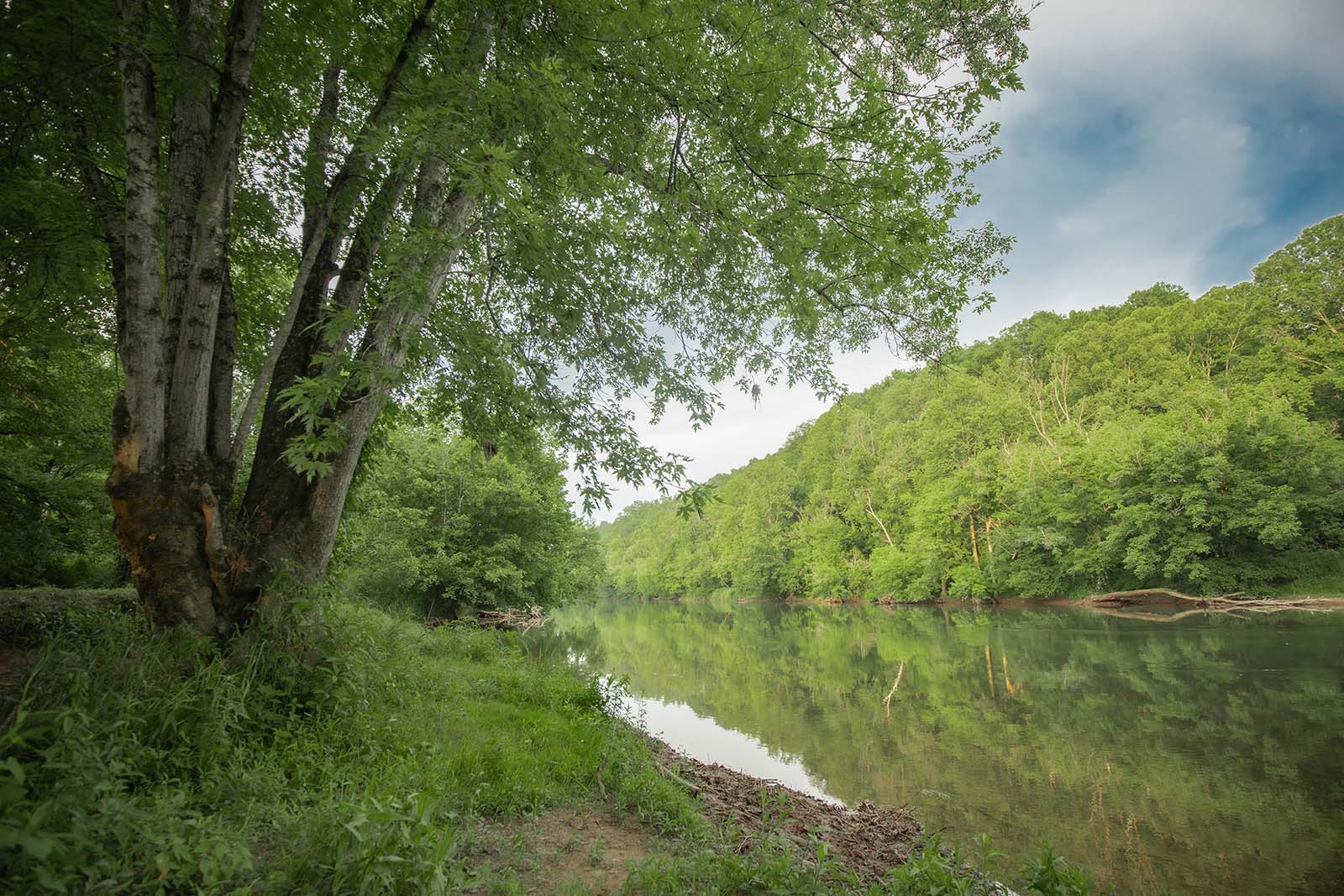
How We’re Funded and How We Spend
The Department of Wildlife Resources (DWR) largely exists through non-general fund revenues. We operate from within multiple restricted funds to support unique programs and responsibilities in Law Enforcement, Wildlife, Aquatics, Boating, Nongame and Endangered Species, Capital Programs, and Outreach, as well as administrative support functions in Human Resources, Planning and Finance, and the Executive Office.
Primary Revenue Sources That Support DWR
(as a percentage of annual revenue)
- Hunting, Fishing, and Trapping Licenses, Permits, and Stamps 37%
- Federal Grants for Wildlife and Aquatics Support 23%
- Sales Tax on Outdoor Equipment for Hunting, Fishing, and Wildlife Watching (HB38) 17%
- Watercraft Sales and Use Tax 10%
- Boat Registration and Titling Fees 6%
- Miscellaneous 4%
- Federal Grants for Boating Support 3%

DWR’s Annual Operating Budget for FY24 By Division
- Law Enforcement $24.7 million
- Wildlife $11.8 million
- Planning, Finance & IT $11.2 million
- Aquatics $10.9 million
- Outreach $5.6 million
- Nongame $4.1 million
- Boating $2.9 million
- Executive Office/Capital Programs $2.2 million
- Human Resources $1.2 million
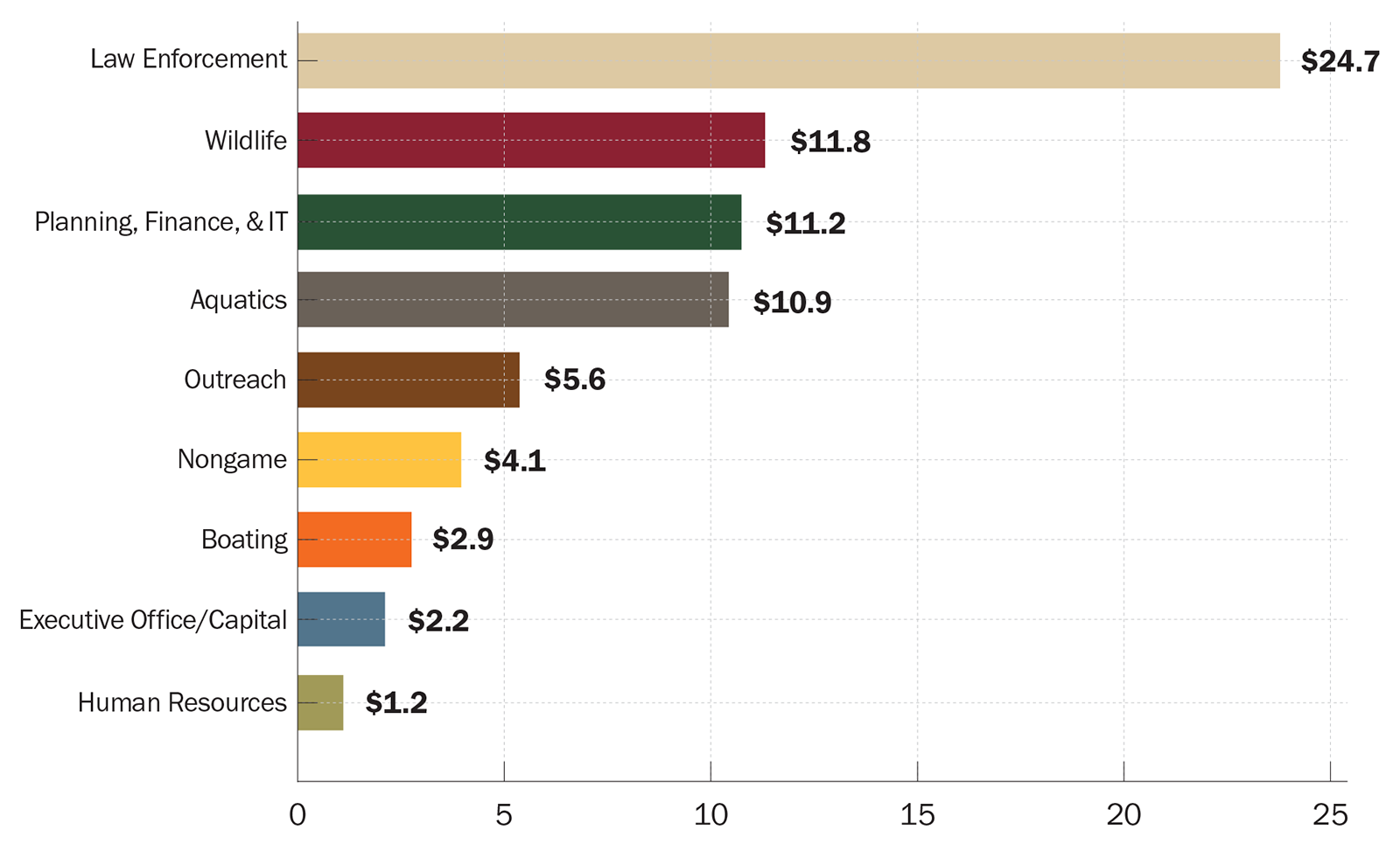
Learn more about DWR’s divisions
- Law Enforcement: Protect natural resources and citizens and visitors—enforcing wildlife and boating laws and regulations; providing dispatch services; training officers and recruits; effecting search-and-rescue/recovery operations; and promoting outreach.
- Wildlife: Develop and manage healthy wildlife resources—providing healthy habitats; managing agency-owned public lands and public boating access sites; leading wildlife health and invasive species initiatives; and managing for human-wildlife conflict.
- Planning, Finance, & IT: Oversee administrative functions—coordinating statewide procurement, grants management, payrolls, accounting, auditing, information management, and budgeting; and delivering online services through GoOutdoorsVirginia.
- Aquatics: Develop and manage aquatic resources—operating nine fish hatcheries and two fresh watermussel propagation facilities; managing and promoting recreational fisheries; producing and stocking fish; and providing input into regulatory environmental permitting.
- Outreach: Oversee agency messaging—managing communications, education, and messaging tools; informing media; fostering public-private partnerships; delivering educational programming; and implementing recreational outdoor opportunities.
- Nongame: Protect, maintain, enhance, and restore native nongame wildlife—supporting target species and their habitats; planning and conducting research; supporting law enforcement efforts; formulating regulations; and enhancing awareness and partnership.
- Boating: Oversee boating safety and registration—delivering boating safety training and education; managing the waterways markers program; registering and titling boats; and managing the agency’s Customer Service.
- Executive Office/Capital: Oversee all executive, regulatory, policy, administrative, and strategic planning decisions—working with the Board of Wildlife Resources; coordinating engagement and support; approving and coordinating property acquisition and capital infrastructure improvement and compliance efforts.
- Human Resources: Oversee human resources policies—coordinating recruitment and training; managing classification, compensation, and recognition initiatives; and supporting diversity, opportunity, and inclusion initiatives.
Economic Contributions in Virginia
Hunting
Hunting-related purchases in Virginia total more than $1.5 billion as contributions to the economy.
Fishing
Fishing-related purchases in Virginia exceed $3.3 billion as contributions to the economy.
Recreational Motorized Boating
Recreational boating contributes $4.4 billion to Virginia’s economy.
Wildlife Watching
Wildlife watching-related purchases—to support activities around home and away from home—exceed $7.7 billion in contributions to the state’s economy.
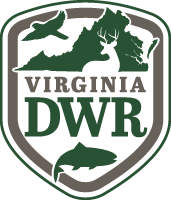
Conserve. Connect. Protect.
DWR leads the conservation and management of healthy terrestrial and aquatic wildlife resources, including for both common and at-risk birds, fish, mammals, reptiles, freshwater mussels and other aquatic invertebrates, and amphibians—and healthy wildlife habitats for the benefit of present and future generations.
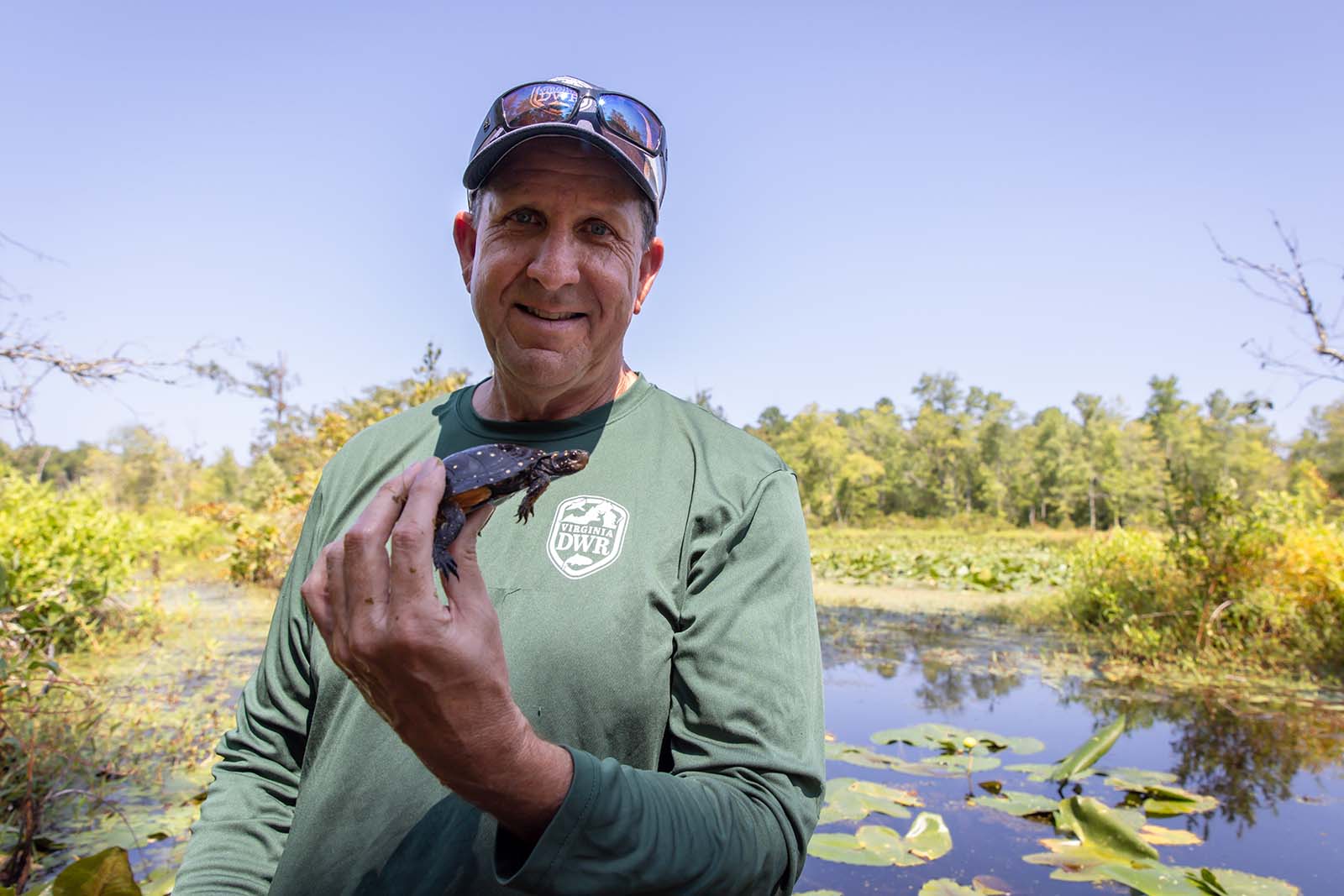
Spotted Turtles Returned to the Wild
Eight spotted turtles are swimming in the wild in Virginia again after being saved from the illegal pet trade pipeline. In 2018, the New York State Department of Environmental Conservation confiscated more than 300 animals—including 185 spotted turtles—destined for the illegal pet trade. While being held, the turtles were genetically tested to determine their location of origin. Of the 185 spotted turtles confiscated in New York, eight were determined to be from Virginia. Veterinary screenings by the Wildlife Center of Virginia ensured the eight turtles were healthy enough to be returned into a wild population. During the summer of 2024, they were released to their genetically assigned watershed in the Coastal Plain of Virginia.
The genetic library of spotted turtle populations in Virginia, developed over many years, was vital to DWR’s ability to return these animals to the wild. Similar libraries for other species have been and are in development. Alternatives for these confiscated animals can be bleak otherwise. Numerous organizations dedicated to the continued conservation of the species worked toward this end result of repatriation, including: the Association of Zoos and Aquariums’ Saving Animals From Extinction American Turtle Program, the Collaborative to Combat the Illegal Trade in Turtles, the Northeast Spotted Turtle Working Group, and the Wildlife Center of Virginia. Funding for the development of the spotted turtle genetic library came from a Competitive State Wildlife Grant from the U.S. Fish and Wildlife Service.
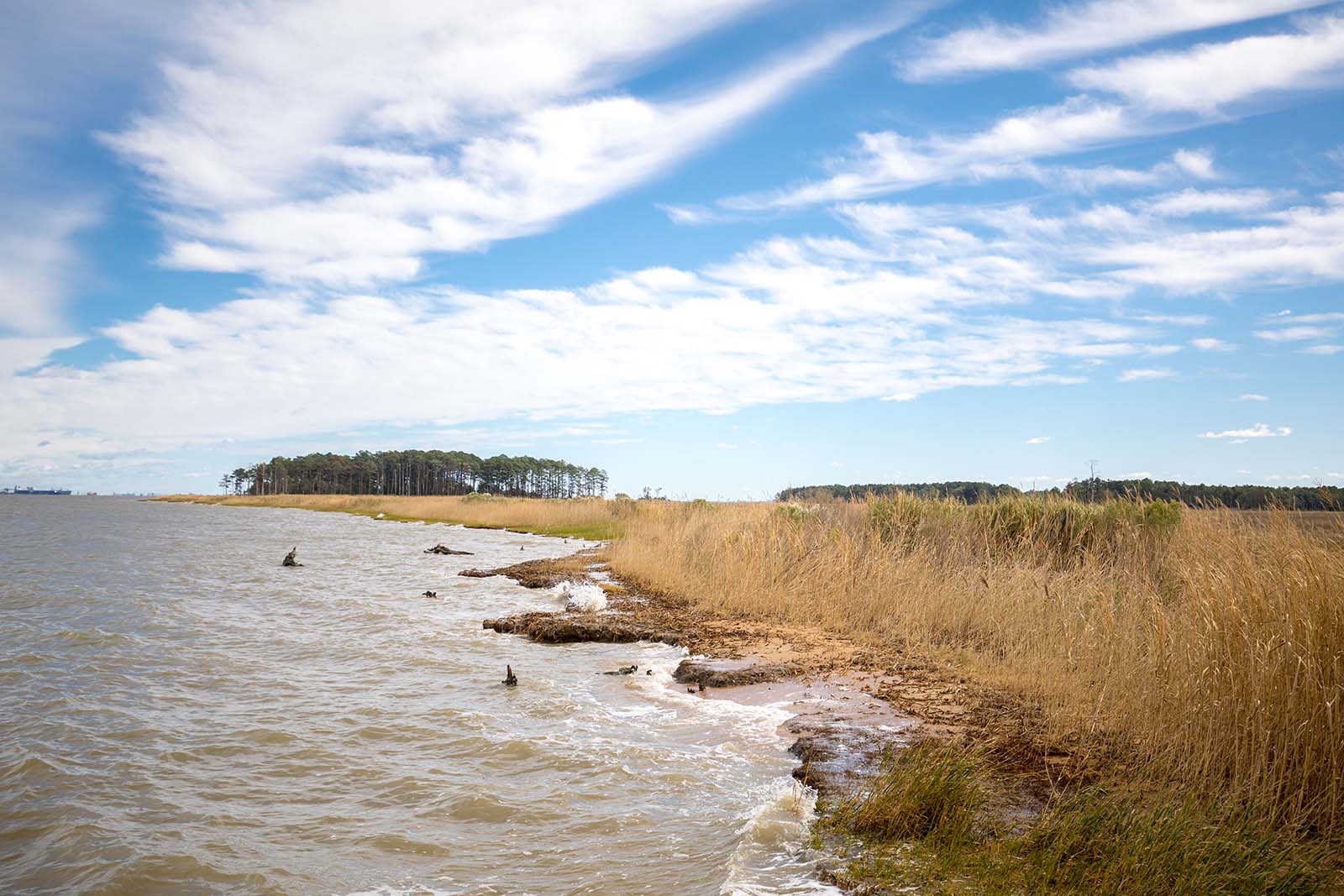
More than $50 Million in Grants Secured
DWR has been awarded two major federal grants totaling more than $50 million. Through the Environmental Protection Agency’s Climate Pollution Reduction Grants Program, DWR has secured $44.59 million for projects included in a proposal of the Atlantic Conservation Coalition, a multi-entity partnership that includes the states of North Carolina (lead applicant), South Carolina, Virginia, and Delaware, and The Nature Conservancy. The primary emphasis of the Coalition proposal was the conservation and restoration of peatlands, wetlands, coastal habitats, and forests across all four states. These habitats all have great ability to capture and store atmospheric carbon. The 21 specific projects identified in the Coalition’s application will reduce greenhouse gas emissions by an estimated 28 million metric tons of CO2 by 2050.
DWR’s specific projects focus on two key habitats—wetlands and coastal forests. The outcomes of these efforts will not only secure existing carbon capture and storage occurring in these habitats, but also improve future capture and storage capabilities. In addition to the carbon benefits, the work proposed will contribute to improved resilience, abated tidal flooding, improved groundwater recharge, improved wildlife habitat, and increased opportunities for wildlife-related recreation and public access.
With $8 million awarded to DWR by the National Oceanic and Atmospheric Administration (NOAA) Transformational Habitat Restoration and Coastal Resilience Grant Program, DWR will protect and enhance the fast-eroding 1,537-acre marsh ecosystem at Ragged Island Wildlife Management Area (WMA) in Isle of Wight County on the James River. The funded work will include the construction of low breakwaters, each of which will include oyster reef habitat and associated living shoreline plantings. The project will not only protect the existing marsh, but also create more than 2.5 acres of new marsh between the breakwaters and current marsh edge. Oyster reef creation will contribute more than 2 acres of restored oyster habitat and provide enhanced fisheries habitats in this section of the James River, benefiting a multitude of fish species.
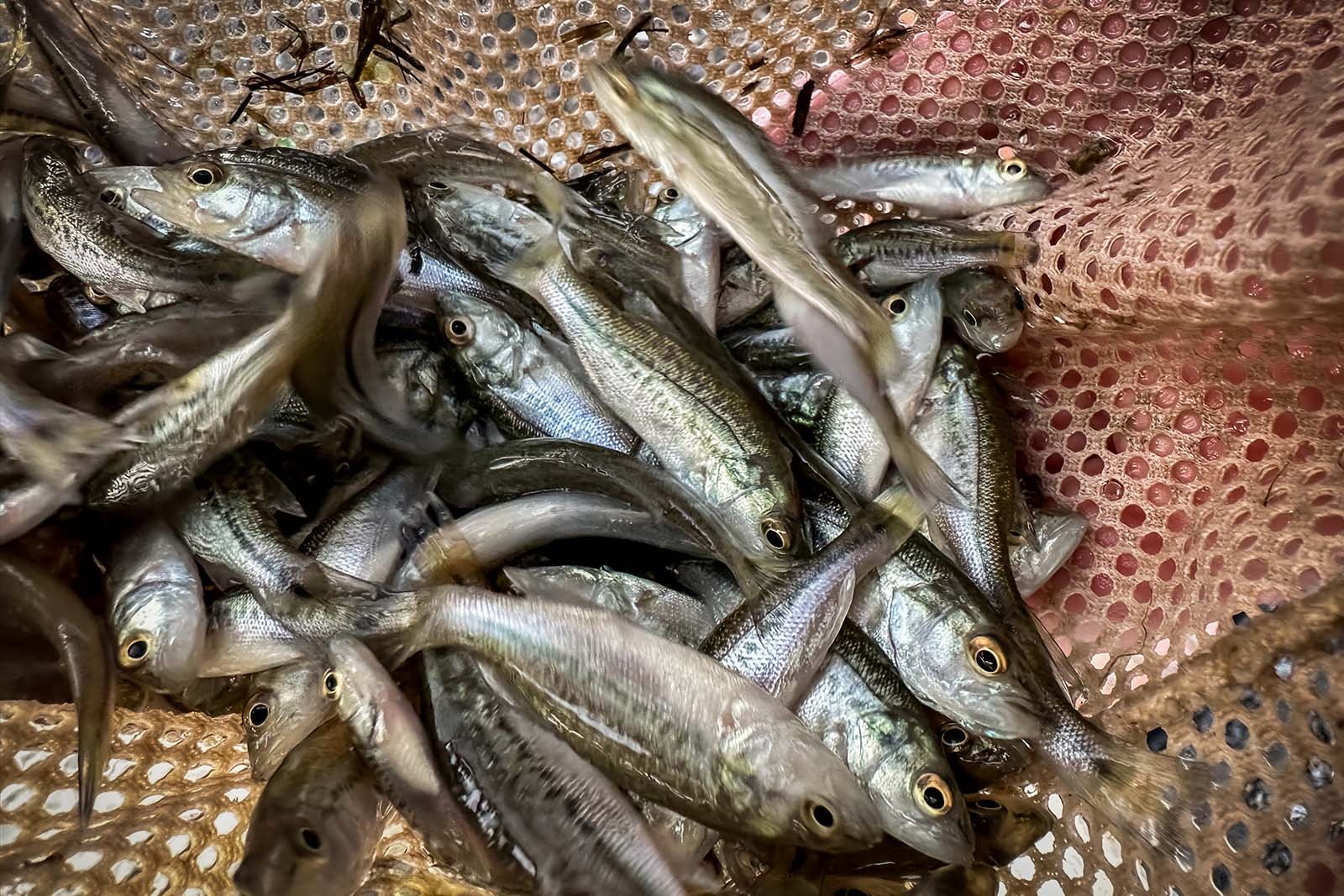
Stocked F1 Largemouth Bass Enhancing Fisheries
In 2023 and early 2024, population surveys that included genetic testing helped determine that more than 25 percent of all F1 largemouth bass over five pounds that had been sampled were fish that DWR had stocked into those waters. Five years before, DWR implemented the F1 bass stocking plan, which aimed to determine if, over a 10-year period, stocking these first- generation hybrids between largemouth and Florida bass can have a positive impact on the fishery. Low densities of F1 bass were placed into large lakes, including Smith Mountain Lake, Lake Anna, Lake Chesdin, and Beaverdam Swamp Reservoir.
Through genetic testing, DWR can tell which fish were stocked and which fish were naturally spawned, thus evaluating their contribution to angler catches. Preliminary results from Smith Mountain Lake, which was stocked three years prior to the onset of the study, suggest a contribution to the population of about five percent, with notably faster growth rates for stocked individuals. DWR will continue to assess data to determine the long-term feasibility and cost effectiveness of this stocking on Smith Mountain Lake and other systems in this study. If successful, this represents a potentially cost-effective method for enhancing bass populations in larger reservoirs, benefiting the 70 percent of anglers that target this species in Virginia. Learn more about F1 largemouth bass:
Learn More About F1 Largemouth Bass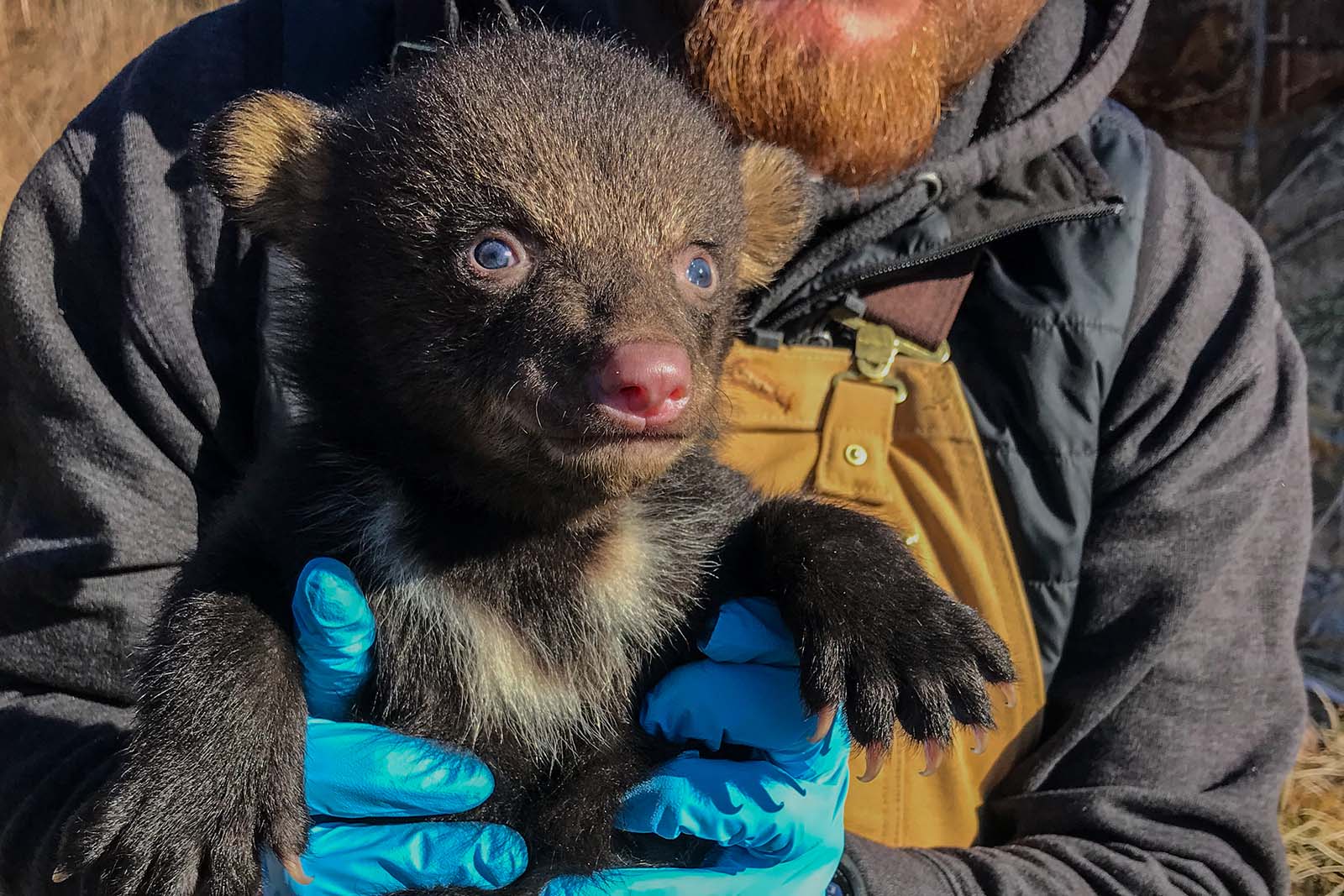
Virginia Bear Management Plan Updated
The Board of Wildlife Resources’ endorsement of the 2023–2032 Virginia Bear Management Plan represents the third version of Virginia’s Bear Management Plan, with some significant updates. The planning model integrates the public’s values associated with bears with the technical expertise of DWR staff to generate a plan that represents the collective desires and interests of citizens for managing bears in Virginia over the next 10 years. The plan includes goals for managing bear populations as related to bear habitat, bear-related recreation, human-bear conflicts, and bear health and welfare. Associated objectives and strategies clarify how these goals will be achieved. Areas of focus in the near-term include achieving bear population objectives, addressing mange in bears, and developing innovations in resolving bear-human conflicts.
Learn More About Virginia’s Bear Management Plan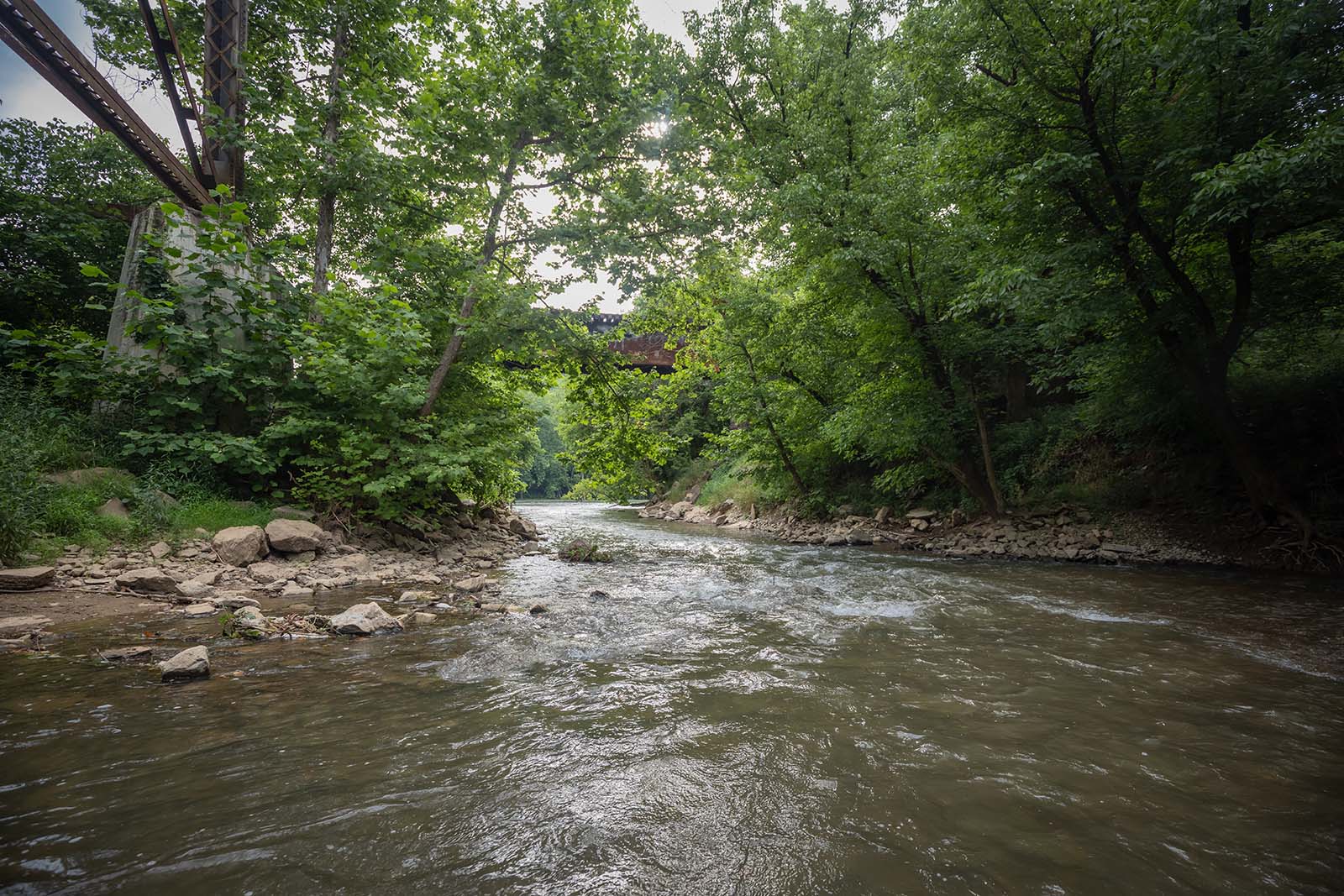
New Public Lands Acquired
DWR added significant land to its public offerings to both benefit wildlife and expand public access. In May 2024, DWR acquired a six-acre tract at the mouth of Copper Creek as it opens into the Clinch River in Scott County. The Copper Creek Wildlife Conservation Site will provide great bank fishing access and the Rexrena boating access site for kayaks and canoes. It will also serve as a great wildlife viewing site for imperiled fish, freshwater mussel species, and birds and other terrestrial animals. That same month, DWR acquired 1,600 acres in Sussex County along the Nottoway River, now named the Arch of the Nottoway River WMA, that will provide public access for hunting, fishing, wildlife viewing, hiking, paddling, and other outdoor recreation. It will also conserve riparian wetlands, supporting improved water quality for several endangered species known in this part of the river.
In June 2024, DWR closed on a gift of a 230-acre tract of land along the Bullpasture River that expands the Highland WMA. This property provides new fishing opportunities, access to the southwestern part of the WMA and scenic Bullpasture River, and important habitat for the federally endangered rusty patched bumble bee.
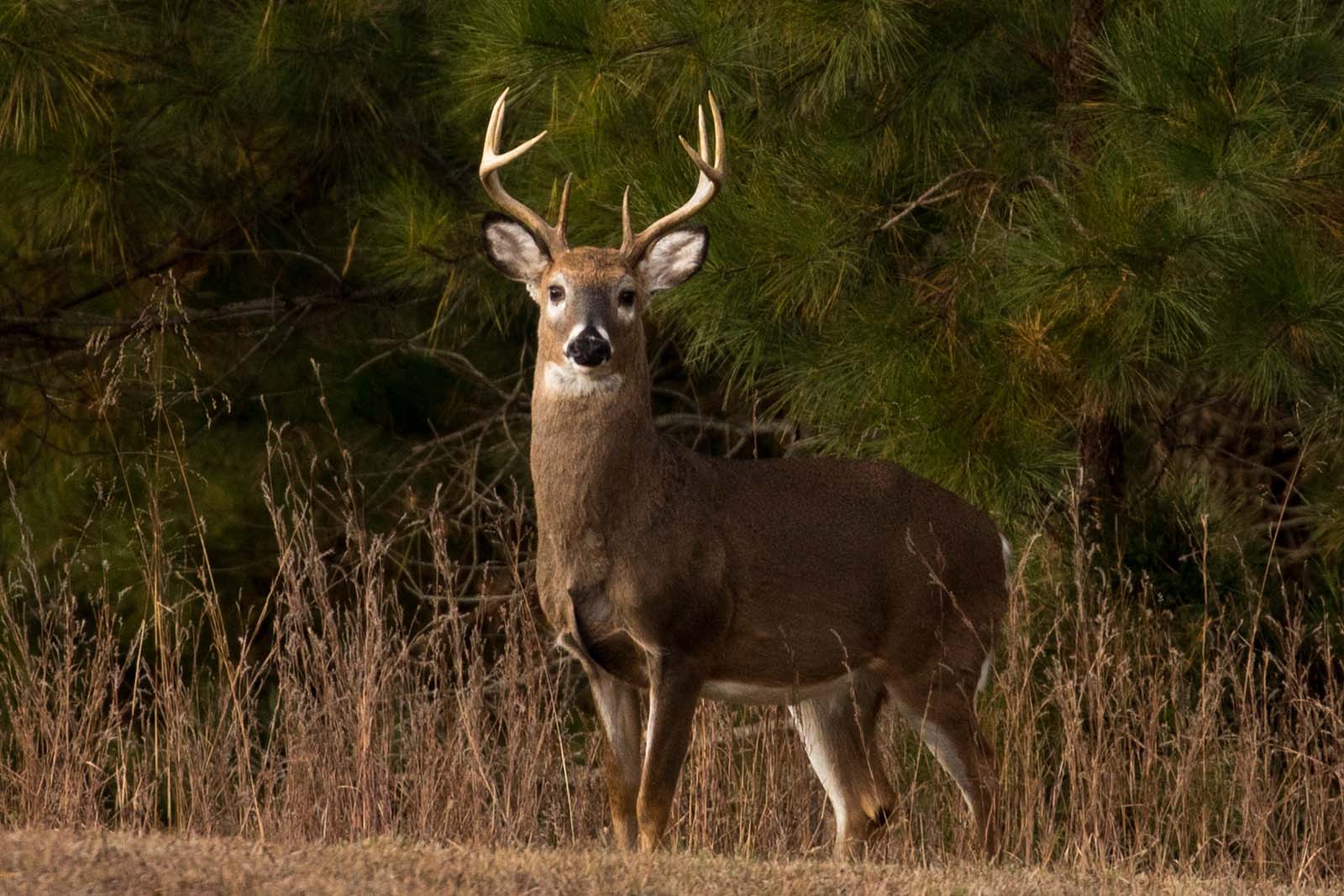
Biologists Monitor Populations
Wildlife biologists work every year to evaluate populations of a wide variety of species, including waterfowl, wild turkey, small game, furbearers, bear, elk, and deer. Strategies include fall and winter aerial surveys, capture and banding, roadside surveys, harvest reporting, GPS-collaring, and reporting from hunters and volunteers.
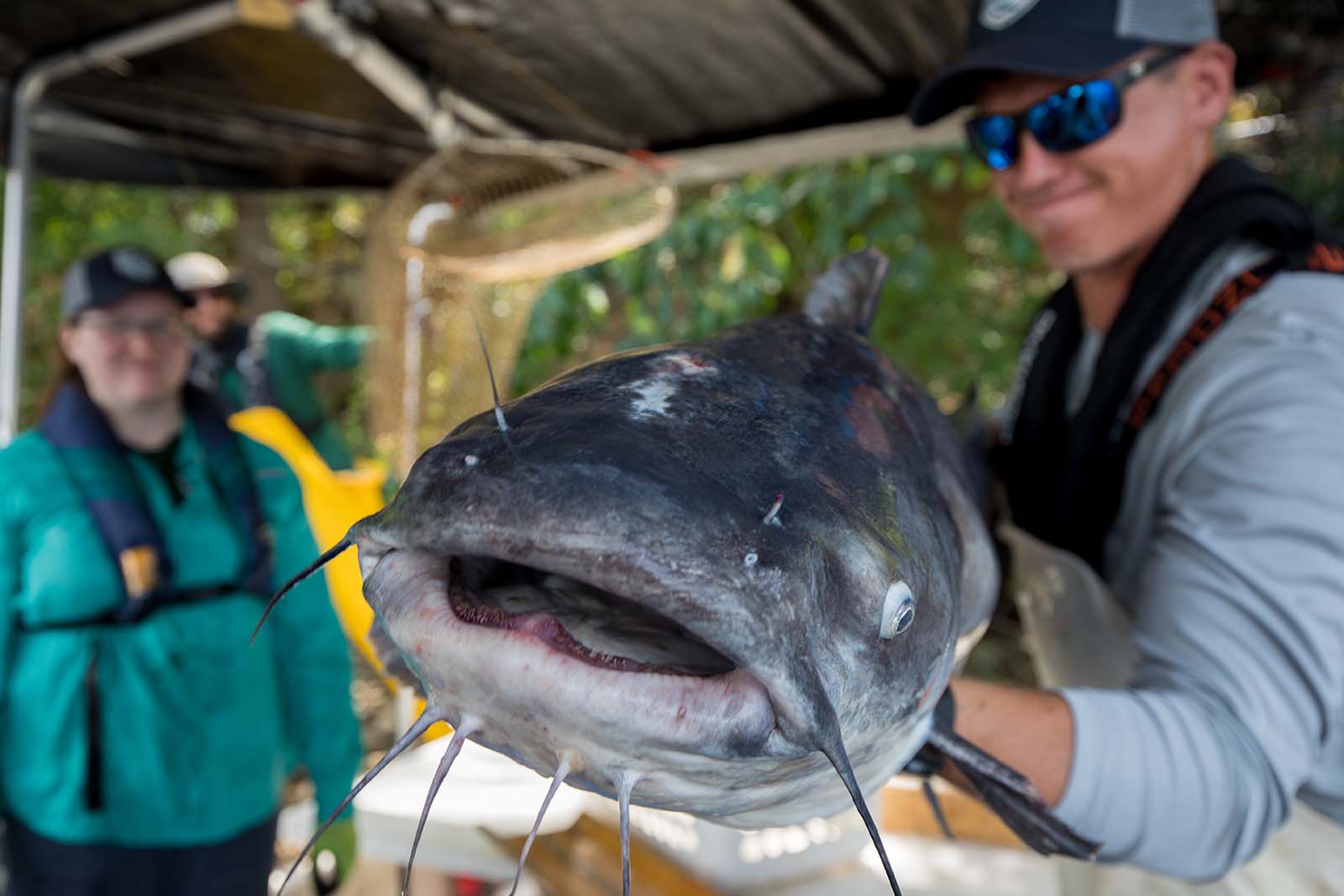
Blue Catfish Tagging Project
Blue catfish support one of the most popular recreational fisheries in Virginia tidal waters, but also present a management challenge because of their high abundance. DWR’s goal is to reduce overall blue catfish abundance by encouraging harvest of small individuals while maintaining the trophy fishery that targets fish over 32 inches, which are unsuitable for human consumption because of potential contamination. To fill critical information gaps, DWR Aquatics Biologists have acoustically tagged a total of 90 blue catfish from one to 67 pounds over three years in the James and Chickahominy rivers, which will provide information on distribution and movement. DWR has coordinated with charter captains and anglers to tag 10 trophy-sized blue catfish; these data will provide deeper insight into where large catfish go in the river system and why. These data will be communicated with anglers and commercial watermen to increase recreational opportunities and increase the efficacy of the commercial blue catfish fishery.
Learn More About Blue Catfish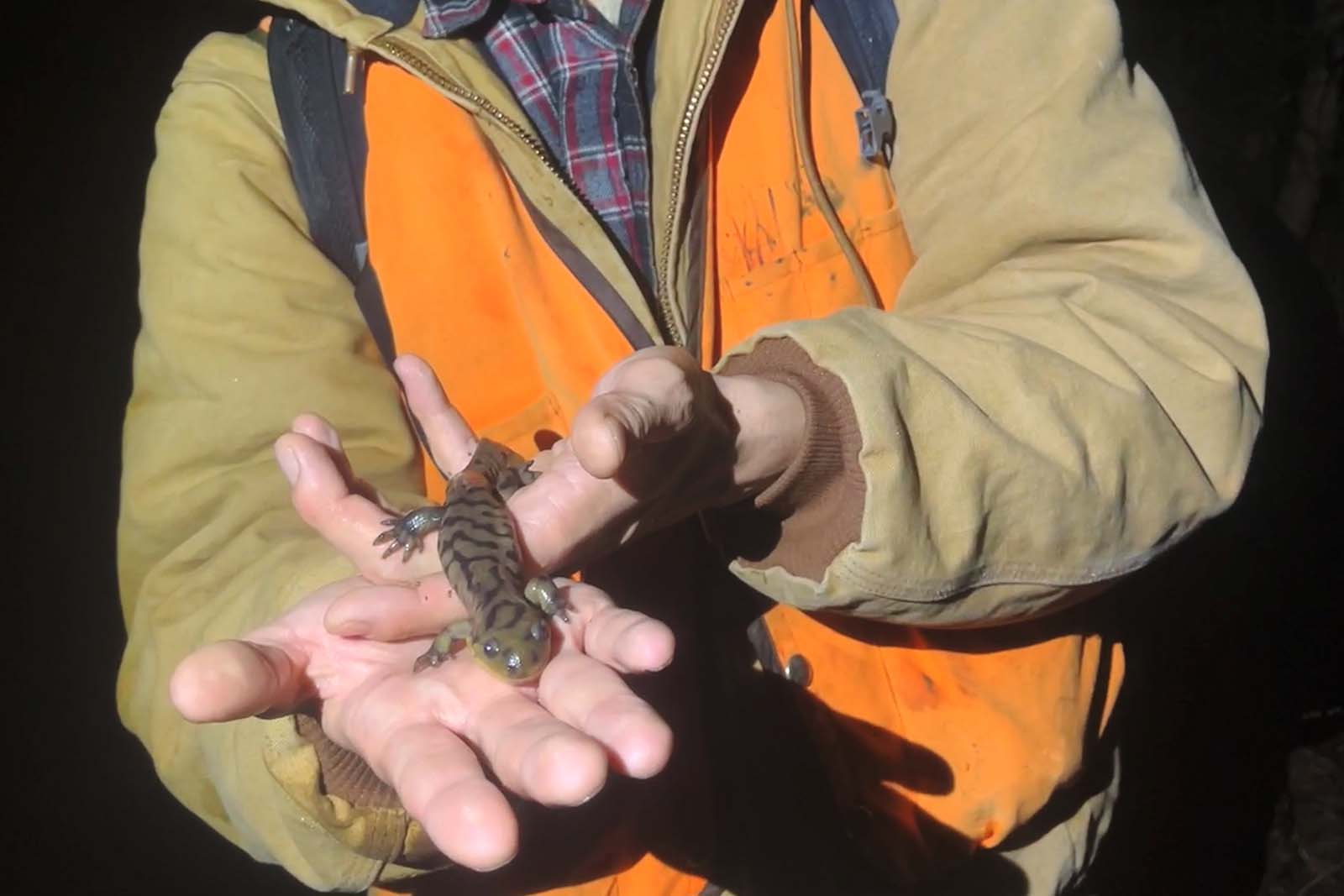
Wetland Restoration and Enhancement
DWR’s wetlands program focuses primarily on implementing voluntary wetland restoration and enhancement projects. With the help of many partners, including Ducks Unlimited (DU), U.S. Fish and Wildlife Service (USFWS), Virginia Department of Forestry (DOF), Coastal Zone Management (CZM), and the Atlantic Coast Joint Venture, the wetlands program has completed more than 330 acres of wetland restoration and enhancement projects and has secured funding to support the design and construction of an additional 830 acres. These projects aim to support Virginia’s wetland-dependent wildlife populations, including several at-risk Species of Greatest Conservation Need (e.g., American black ducks, Eastern black rails, and tiger salamanders).
DWR was recently identified as the lead agency to guide Virginia’s progress toward the 2014 Chesapeake Bay Agreement Wetland Outcome. DWR’s wetlands biologist led the development of the 2023 Virginia Wetlands Action Plan, which highlights several current actions and provides strategies to increase the pace of voluntary wetland restoration efforts in Virginia. Since the Action Plan was developed, Virginia has seen a significant boost in wetlands capacity.
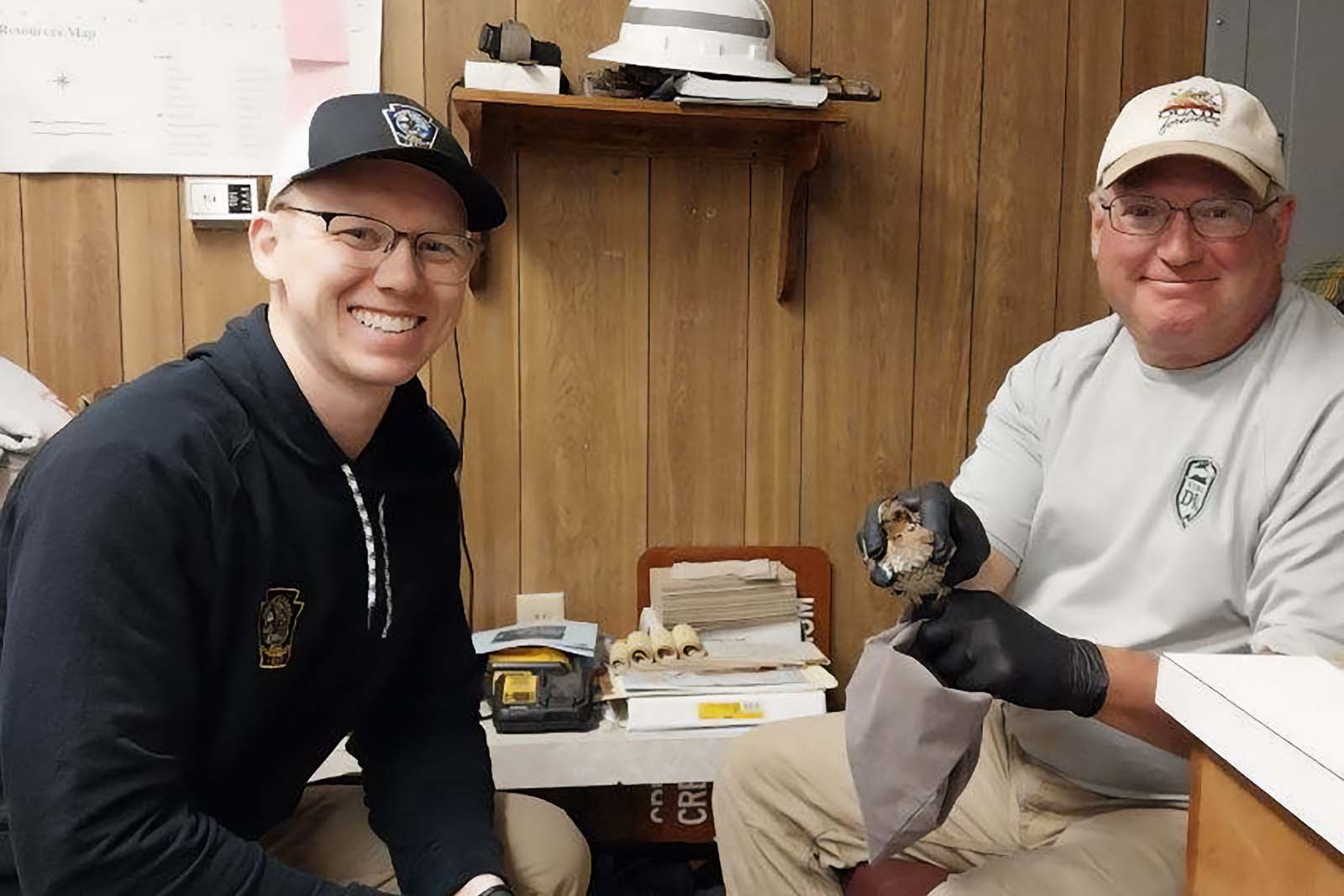
Partnering to Restore Quail in Pennsylvania
Wild quail were declared extirpated in Pennsylvania in 2014, but in early 2024, the species returned to the state thanks to a cooperative effort with DWR. The Pennsylvania Game Commission (PGC) chose Letterkenny Army Depot near Chambersburg, Pennsylvania, for a quail restoration area, with more than 2,000 contiguous acres of good quail habitat created in recent years. Restoration plans included translocating 20–25 quail from Ft. Barfoot in Virginia to serve as one of multiple source populations. In early 2024, staff from PGC, Ft. Barfoot, and DWR conducted a week-long trapping effort, capturing 22 quail to translocate to Pennsylvania. DWR plans to continue this project for two more years, providing 20–25 quail each year.
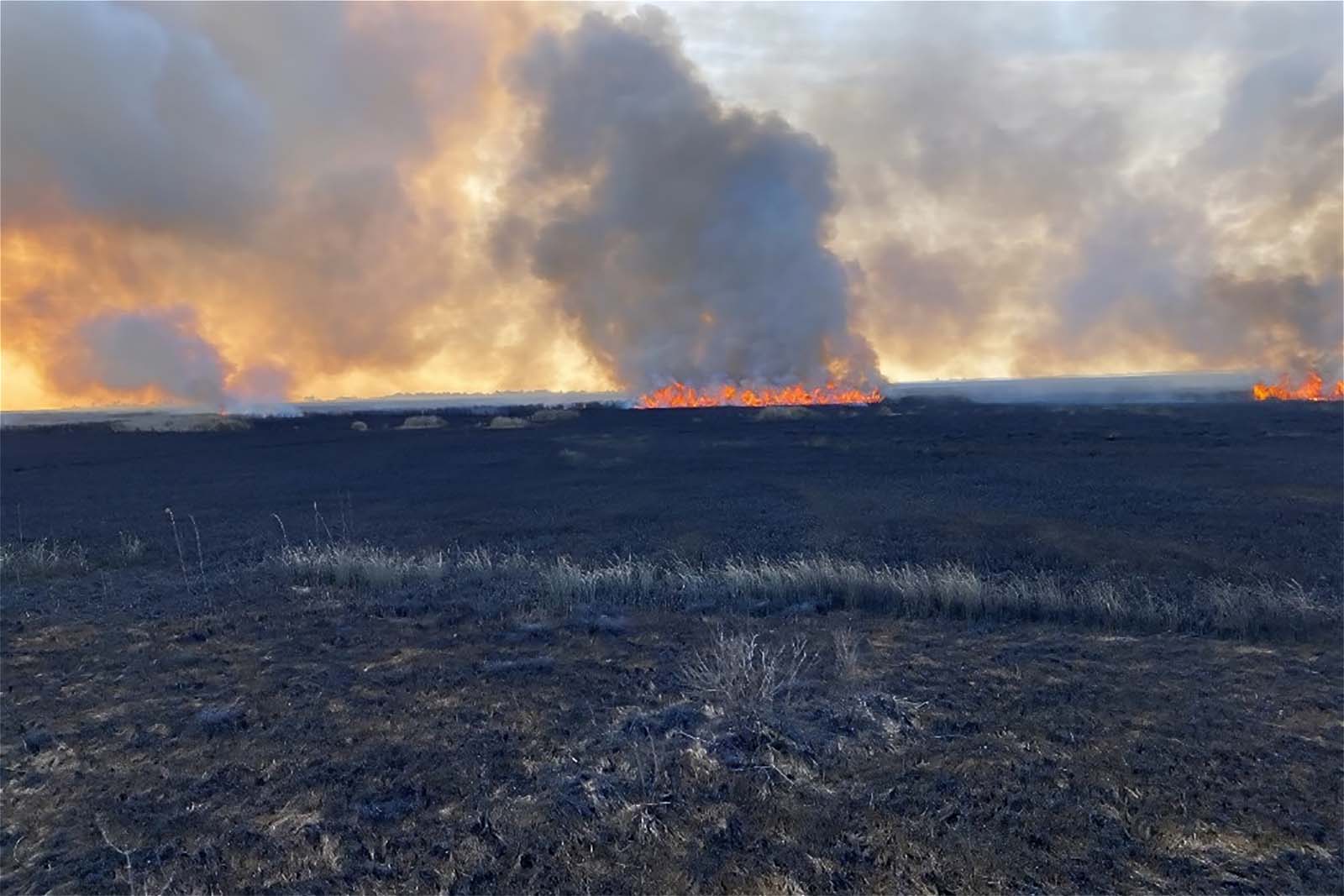
Black Rail Habitat Restoration and Creation
A federally threatened and state- endangered species, the Eastern black rail is nearly extirpated from the Commonwealth. DWR is participating in an Atlantic Coast Joint Venture project funded by a federal Competitive State Wildlife Grant award to restore and/or enhance black rail habitat. In Virginia, that work includes enhancing 250 acres of existing black rail habitat at DWR’s Saxis WMA by controlling extensive stands of Phragmites (an invasive wetland reed) and field-testing habitat creation and management strategies in two impoundments totaling 103 acres at DWR’s Doe Creek WMA. Strategies include woody vegetation removal within and around the impoundments; installing water control structures; and creating elevated refugia for black rail young during high-water events. Staff have completed pre-treatment black rail and vegetation surveys and began hydrology monitoring at both sites. In February 2024, DWR staff, with assistance from USFWS and the Virginia Department of Conservation and Recreation (DCR), conducted a 125-acre prescribed burn at the Saxis WMA to test the efficacy of burning as a way to control Phragmites.
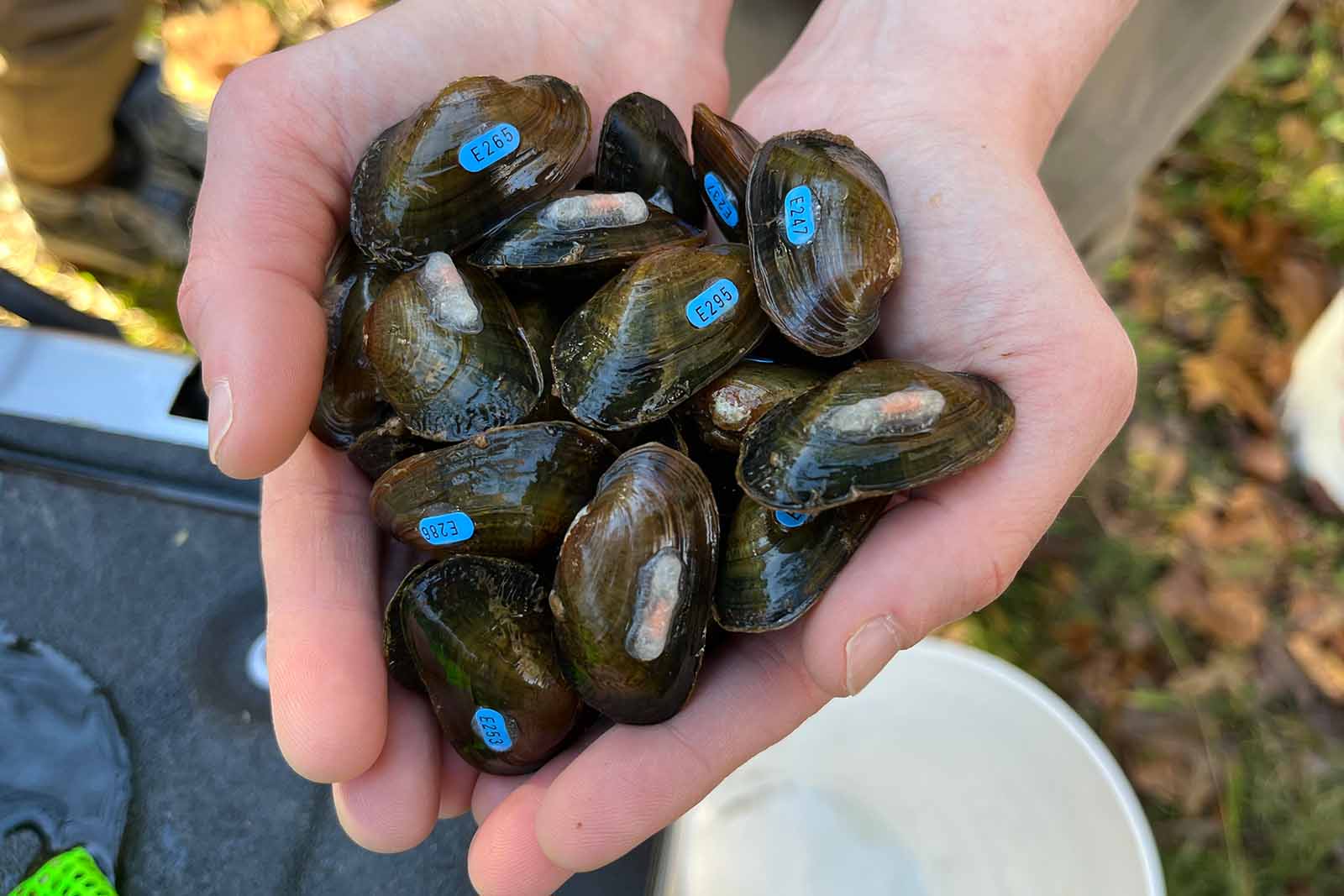
Brook Floater Mussel Conservation and Restoration Initative
The brook floater mussel, which is native to 16 states in the eastern U.S., has populations that declined rapidly throughout their range, and the species is listed as critically imperiled in Virginia. Thanks to DWR’s participation in a multi-state Competitive State Wildlife Grant focused on the propagation, release, and genetic analysis of brook floater mussels, in 2024, 15 adult brook floaters were collected from the Cacapon River in West Virginia, which in turn produced nearly 14,000 juveniles at the Virginia Fisheries and Aquatic Wildlife Center (co-led by DWR) at the USFWS’s Harrison Lake National Fish Hatchery in Charles City County. Those juveniles will be released in 2025 and 2026. Genetic samples of adult brook floaters were provided to Auburn University for analysis, which will provide critical information for how Virginia should be conducting recovery for the species.
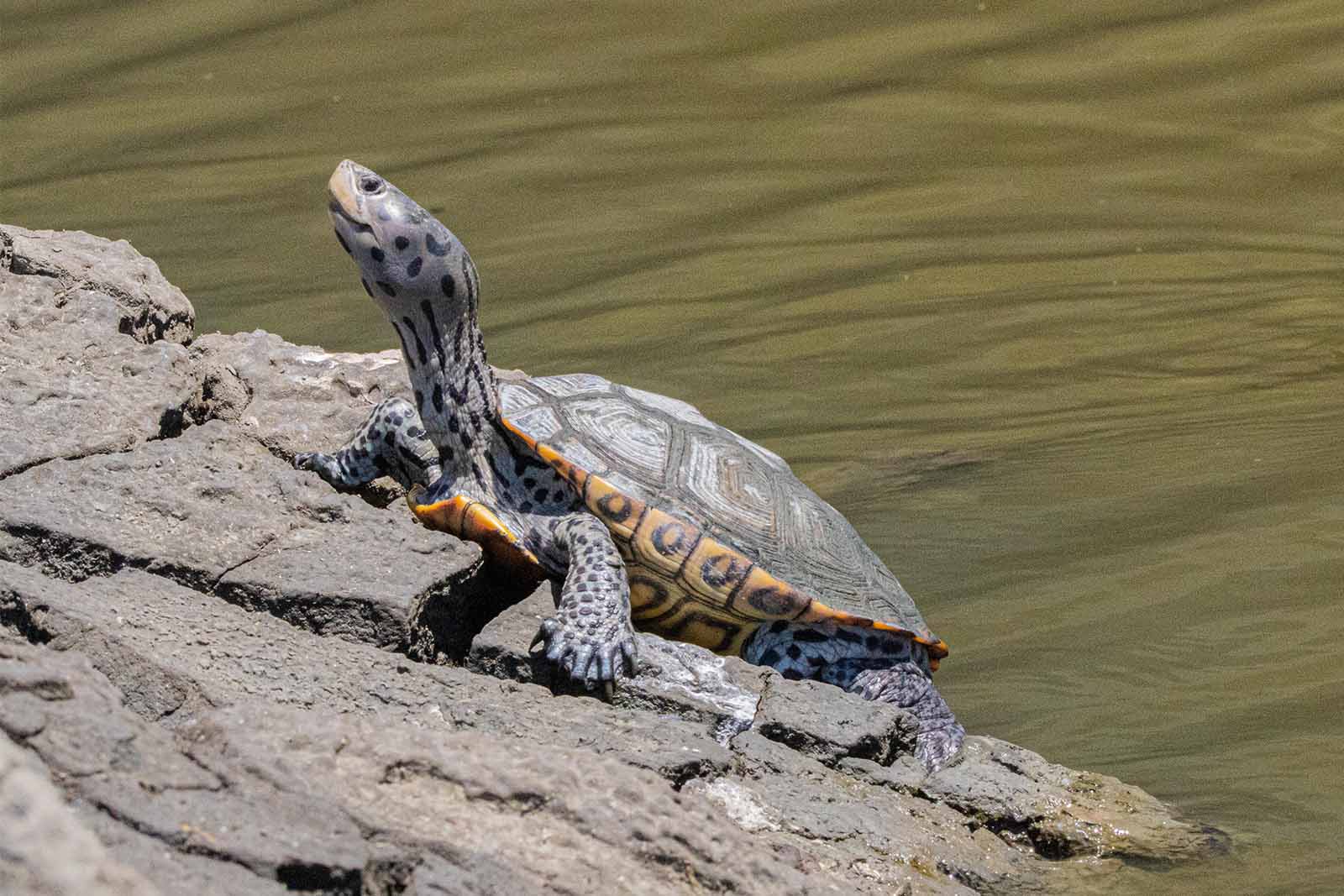
Diamondback Dash Gathers Data
The Diamondback Dash, a participatory science project supporting diamondback terrapin conservation, entered its second year of data collection. This initiative utilizes volunteers to conduct standardized surveys, or headcounts, in search of terrapins along Virginia’s coastal waterways and tidal tributaries. In 2024, 161 trained volunteers sampled 58 routes, ultimately reporting sightings of more than 900 terrapins. The data collected from the Diamondback Dash will help keep terrapins and other wildlife healthy and safe by identifying high-priority waterways in need of protection and prioritizing shoreline conservation in areas that are of high value to these and other animals.
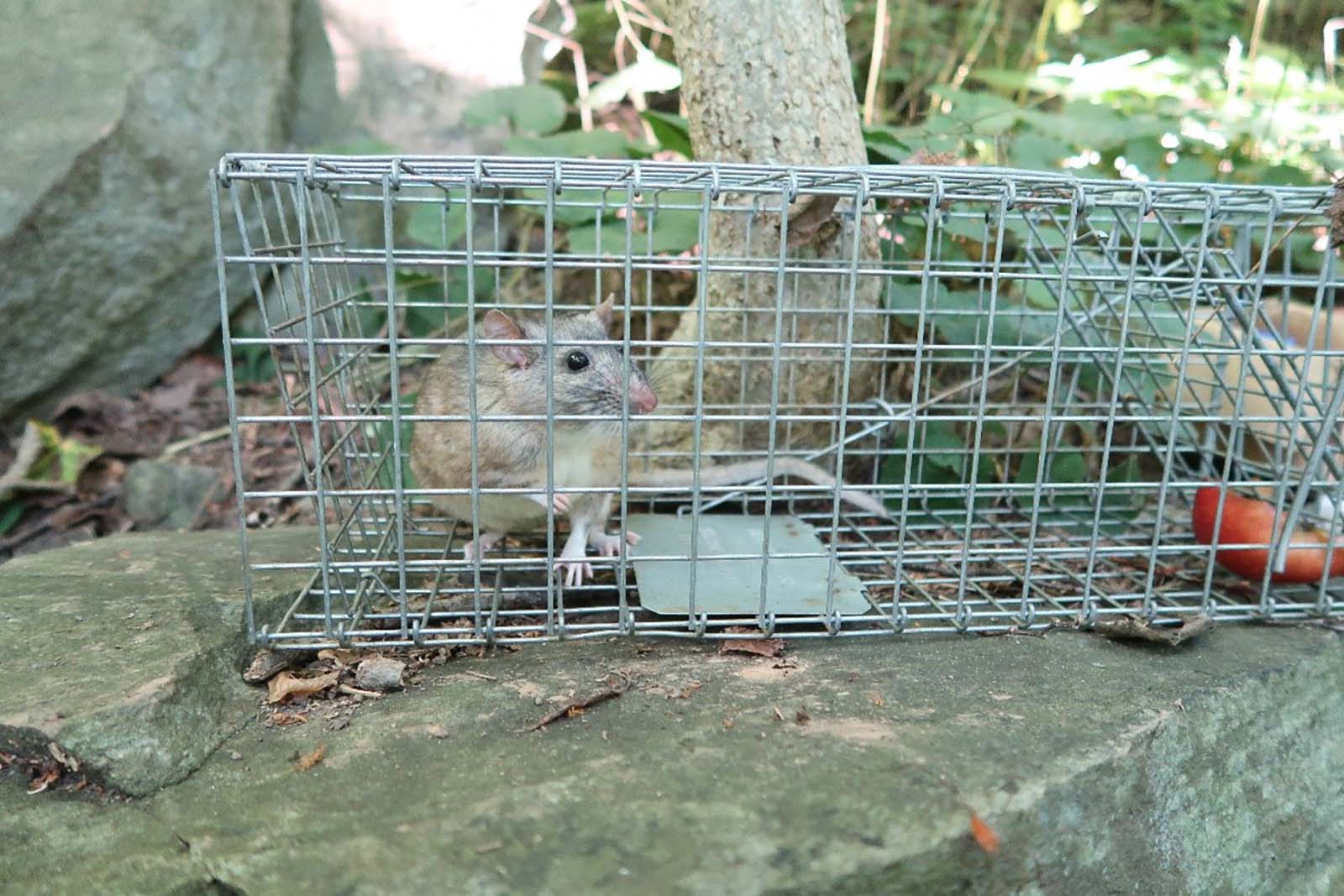
Virginia Alleghey Woodrat Translocation and Population Enhancement in Ohio
DWR, the Wildlife Center of Virginia (WCV), the Ohio Department of Natural Resources (ODNR), and a private landowner collaborated on the capture and translocation of nine Allegheny woodrats to the last remaining population in Ohio. While Allegheny woodrats have been extirpated in New York and are declining dramatically in other nearby states, some populations in Virginia’s mountains appear strong and healthy. However, when woodrats end up in human dwellings, they can cause a conflict. DWR worked with a landowner who had reported property damage due to nesting woodrats to trap nine of those woodrats and transport them to WCV for care. ODNR biologists transported the woodrats to their new home in Ohio. This was a win-win situation for the landowner and ODNR, where a conflict situation turned into a positive outcome for a species that is declining in another state.
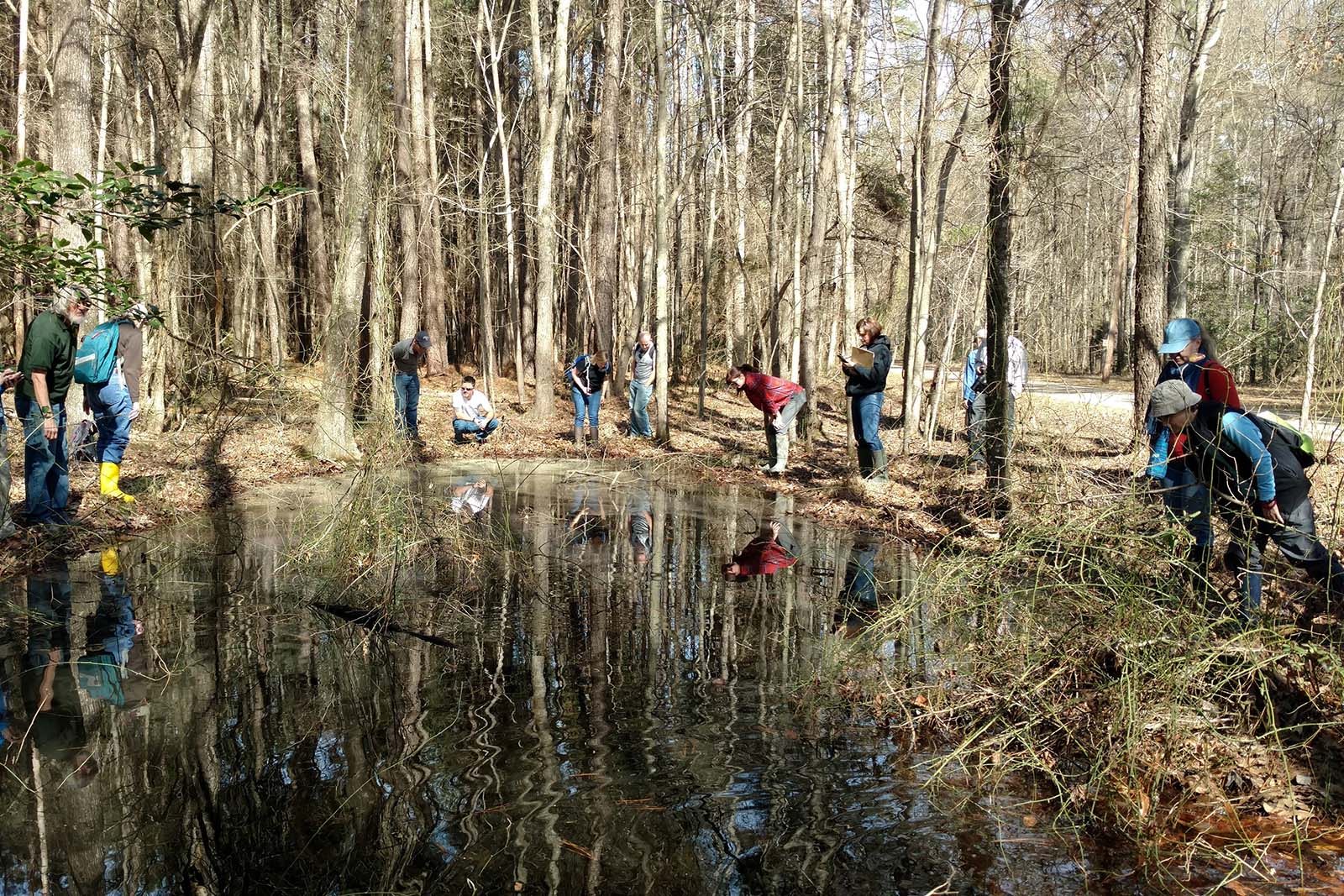
Vernal Pool Cooperative of Virginia
Virginia Master Naturalists (VMN) worked with natural resource managers on public lands to identify and monitor vernal pool habitats, temporary freshwater pools essential to a wide variety of aquatic wildlife. DWR Wildlife Information staff, with colleagues at Virginia Commonwealth University (VCU) and VMN, coordinate on training VMN volunteers to identify and monitor these habitats and submit data using an online database customized for this project on a platform developed and housed by Colorado State University and other partners at CitSci.org. This project provides data to resource managers at the given properties that may be used for education/outreach and conservation/ management purposes.
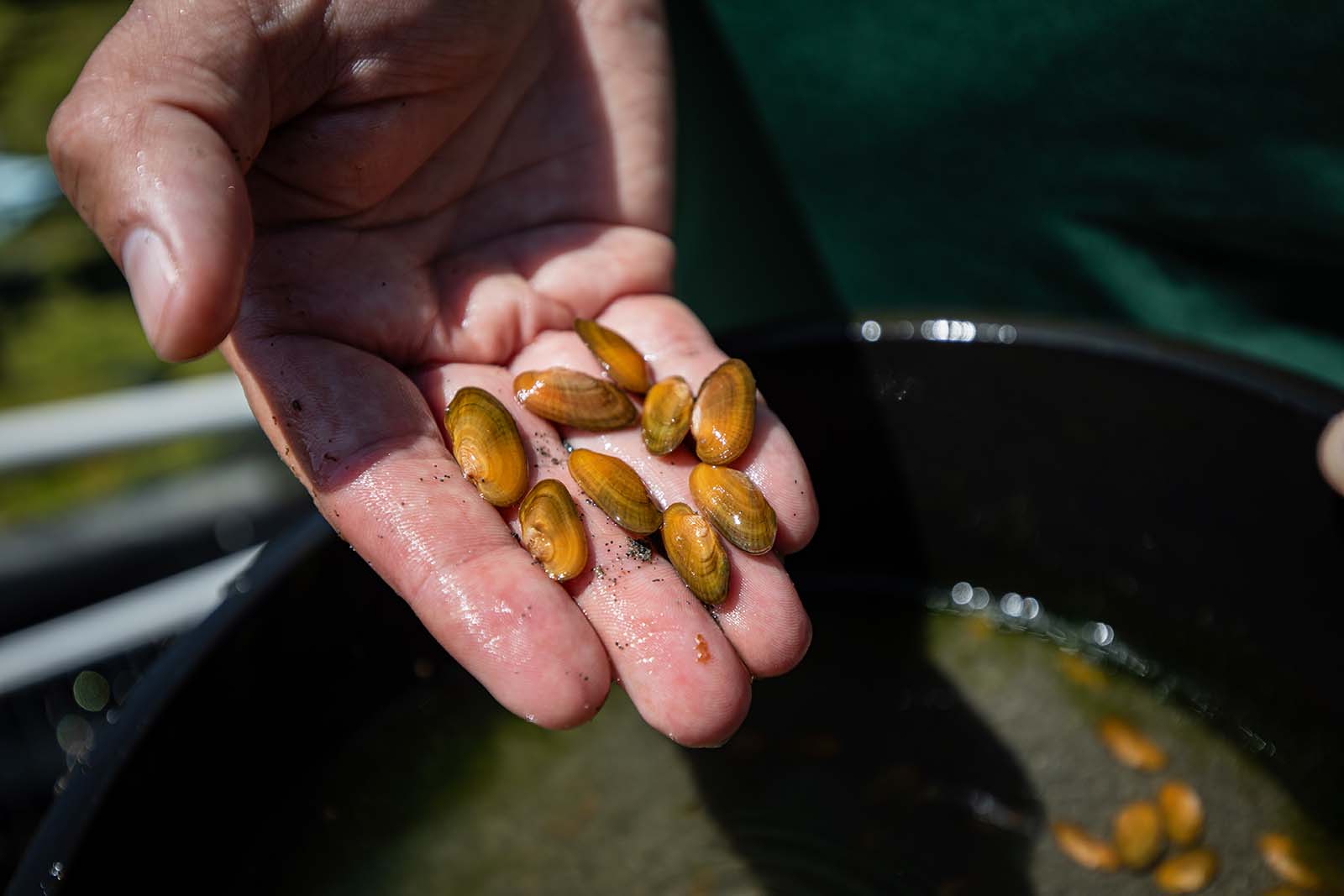
AWCC Production Successes Continue
At DWR’s Aquatic Wildlife Conservation Center (AWCC) in Smyth County, biologists continued to produce notable numbers of the highly imperiled Appalachian monekyface, with 5,102 individuals produced in 2024. This output tripled the most that have ever metamorphosed to this stage in a single season. From that effort, 542 animals have survived to four months of age and are planned to be released in the Clinch and Powell rivers in 2025. To date, only 150 have been released by AWCC staff (in 2022 and 2023). DWR transferred 1,275 federally endangered oyster mussel to the Alabama Department of Conservation and Recreation in May 2024, and that agency transferred back 4,675 federally endangered Tennessee bean mussel to the AWCC for DWR’s future restoration efforts in the North Fork Holston River. This partnership with other states in the Tennessee River basin is important in the national efforts to restore endangered species.
Learn More About the AWCC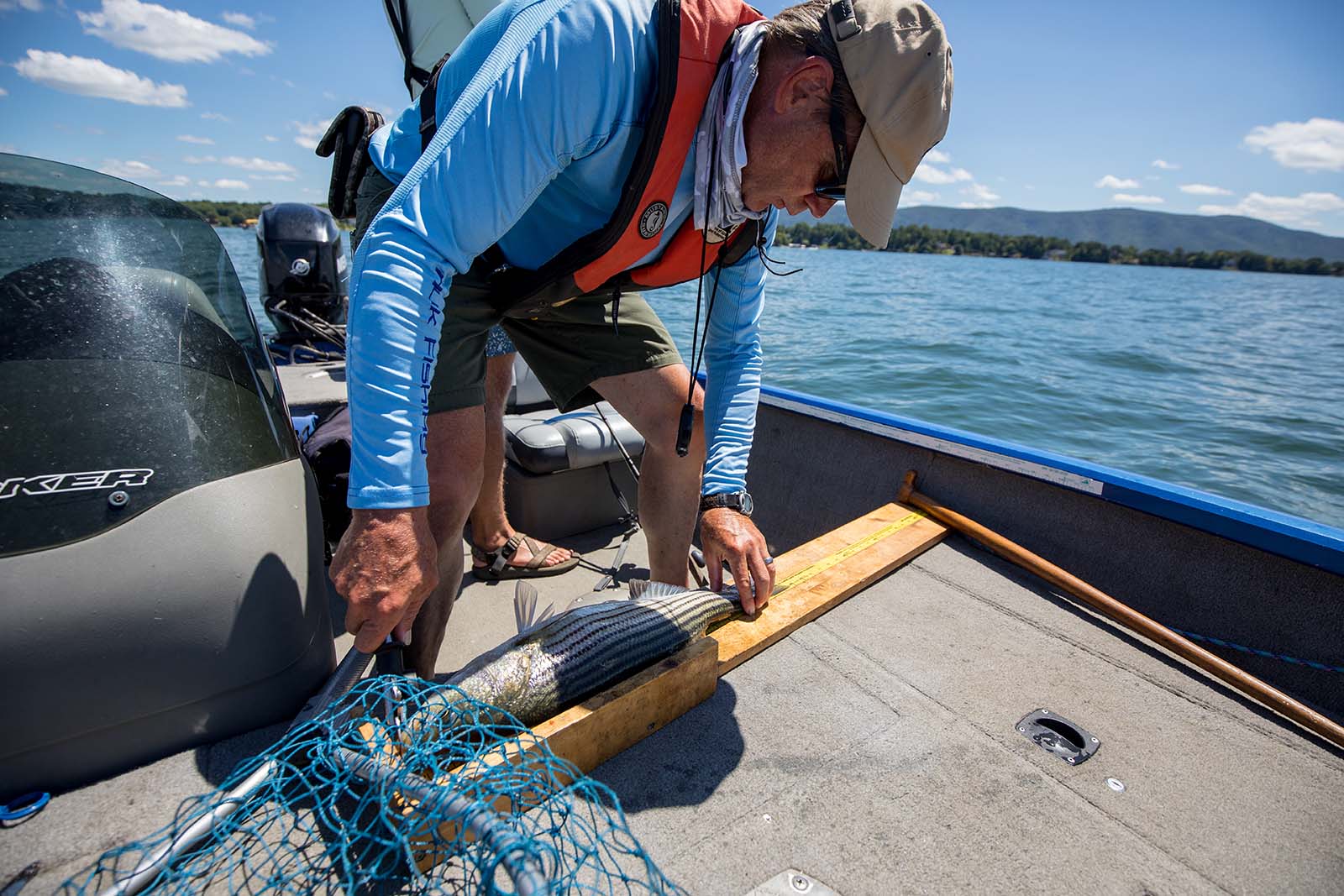
Millions of Fish Stocked
DWR’s Aquatics division operates nine fish hatcheries that produce millions of fish each year to stock into streams, rivers, lakes, and urban waterbodies for anglers to pursue.
Coldwater
- 420,000 Rainbow Trout
- 147,000 Brook Trout
- 124,000 Brown Trout
- 25,000 Tiger Trout
Warmwater
- 710,000 Striped Bass
- 670,000 Walleye
- 500,000 Bluegill
- 140,000 Black Crappie
- 32,000 Smallmouth Bass
- 10,000 Muskellunge
 Learn More About Virginia’s Fish Hatcheries
Learn More About Virginia’s Fish Hatcheries
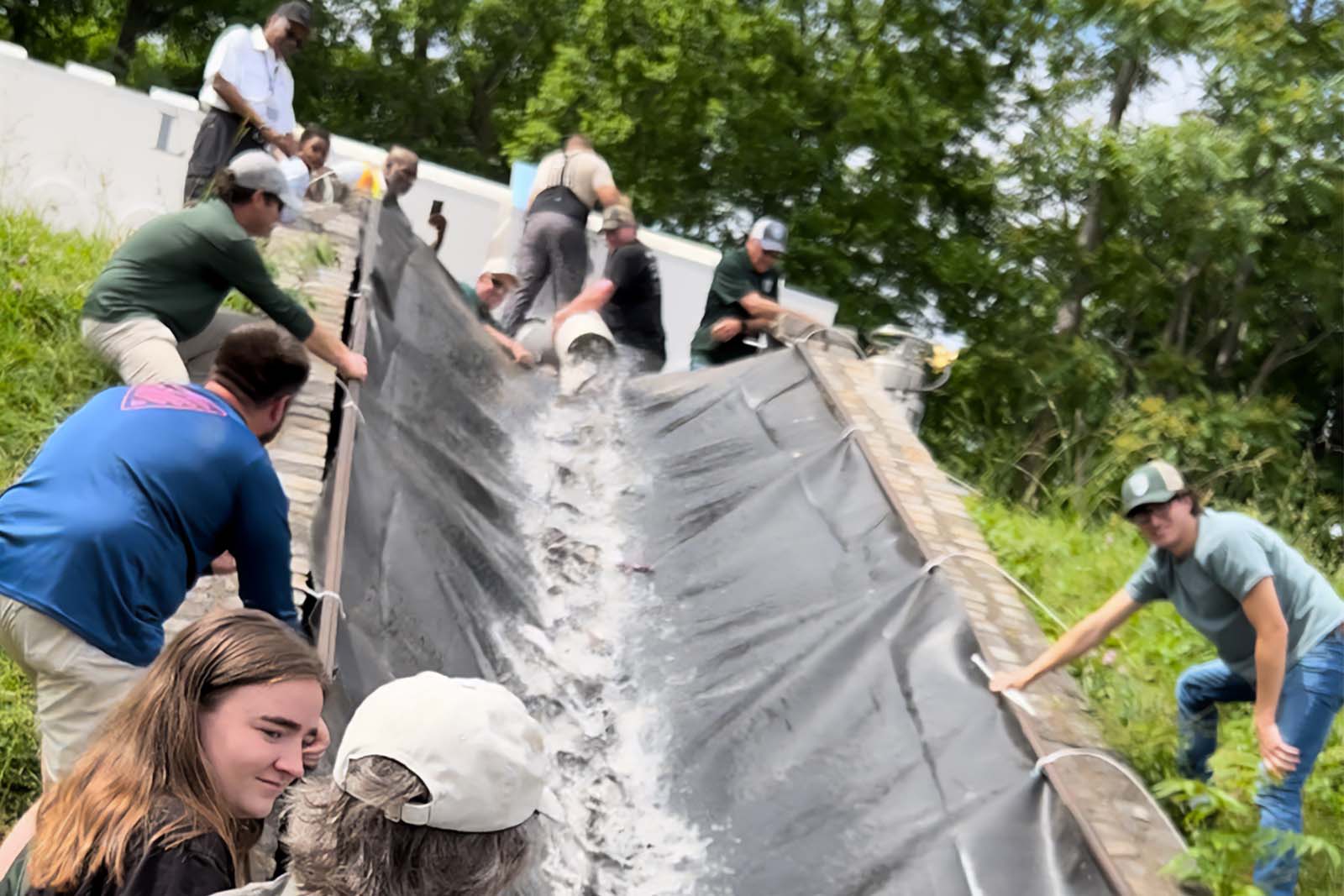
Volunteers Amplify the Workforce
DWR volunteers provide a tremendous service to DWR’s mission, providing an array of services such as stocking fish, assisting at fish hatcheries, assisting with habitat management on WMAs, monitoring invasive species, assisting with dispatch, and much more. They provide logistic support and assist with DWR-sponsored programs and events, helping to create a positive image of the agency in the community. Our volunteers extend and augment the work of paid staff. During this fiscal year, the DWR Volunteer Program contributed 7,273 hours to DWR, resulting in an impact value of $130,914.
Learn More About DWR’s Volunteer Program and Opportunities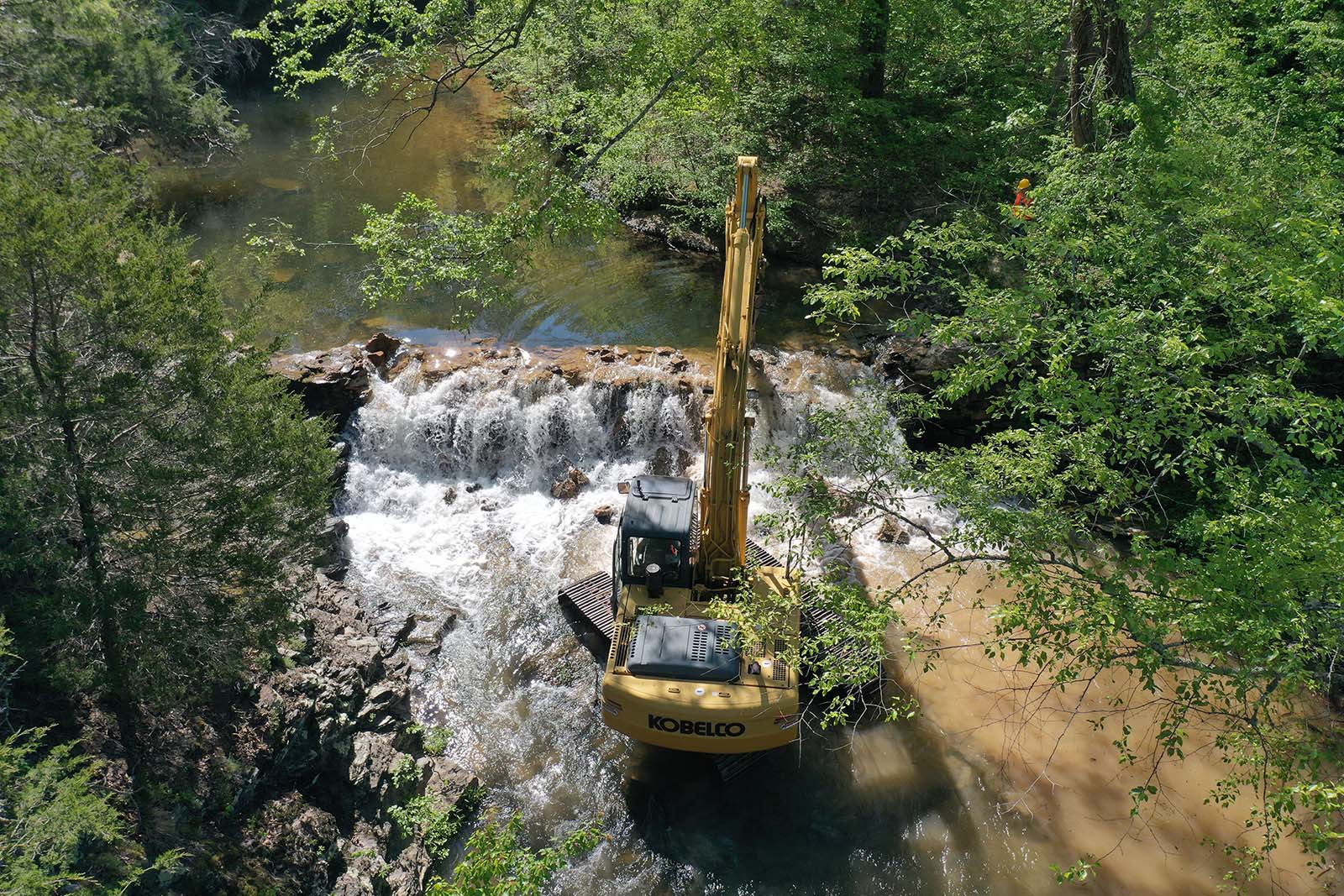
Baber’s Mill Dam Removal
The Baber’s Mill Dam on Rock Island Creek in Buckingham County was removed during the summer of 2024. This dam was located on Weyerhaeuser Company property and was 6 feet tall, 55 feet wide, and nearly 200 years old. This barrier impaired stream connectivity, sediment transport, and the migration of species such as sea lamprey, American eel, and the endangered James spinymussel. Onsite surveys prior to removal confirmed the presence of all species. Removal provided access to an additional 45 miles of river upstream. DWR anticipates positive responses from each of these species following removal. Funds for this project were provided by a State Wildlife Grant, a grant from a private foundation, and Weyerhaeuser Company.
Learn More About DWR’s Fish Passage Program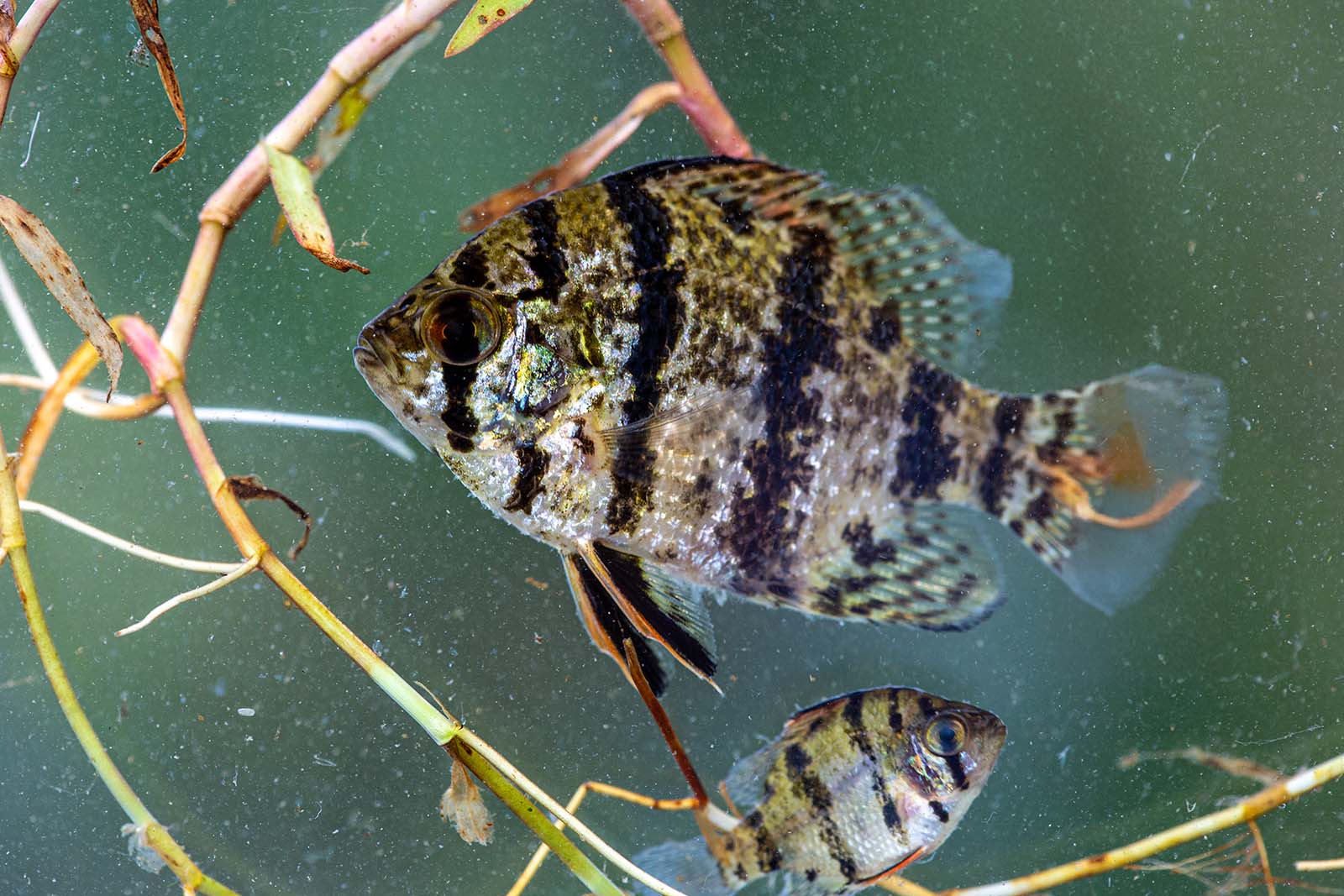
eDNA Surveillance of Blackbanded Sunfish
The blackbanded sunfish is a state-endangered species that occurs in ponds (beaver and man-made) and swamps in the Blackwater and Nottoway watersheds. Because the species is rare, and short-lived, and lives in habitat that’s difficult to access, traditional methods to monitor and capture blackbanded sunfish are tedious and often unsuccessful. Environmental DNA (eDNA) surveillance, where biologists monitor the water for a species’ DNA, offers an alternative, non-invasive sampling approach that is especially useful for rare species for whom distribution is unknown. Additionally, eDNA surveillance is over a large area, allowing it to be a useful initial approach in determining species presence. In 2024, 31 sites were sampled for blackbanded sunfish, with more scheduled in 2025.
Learn More About the Blackbanded Sunfish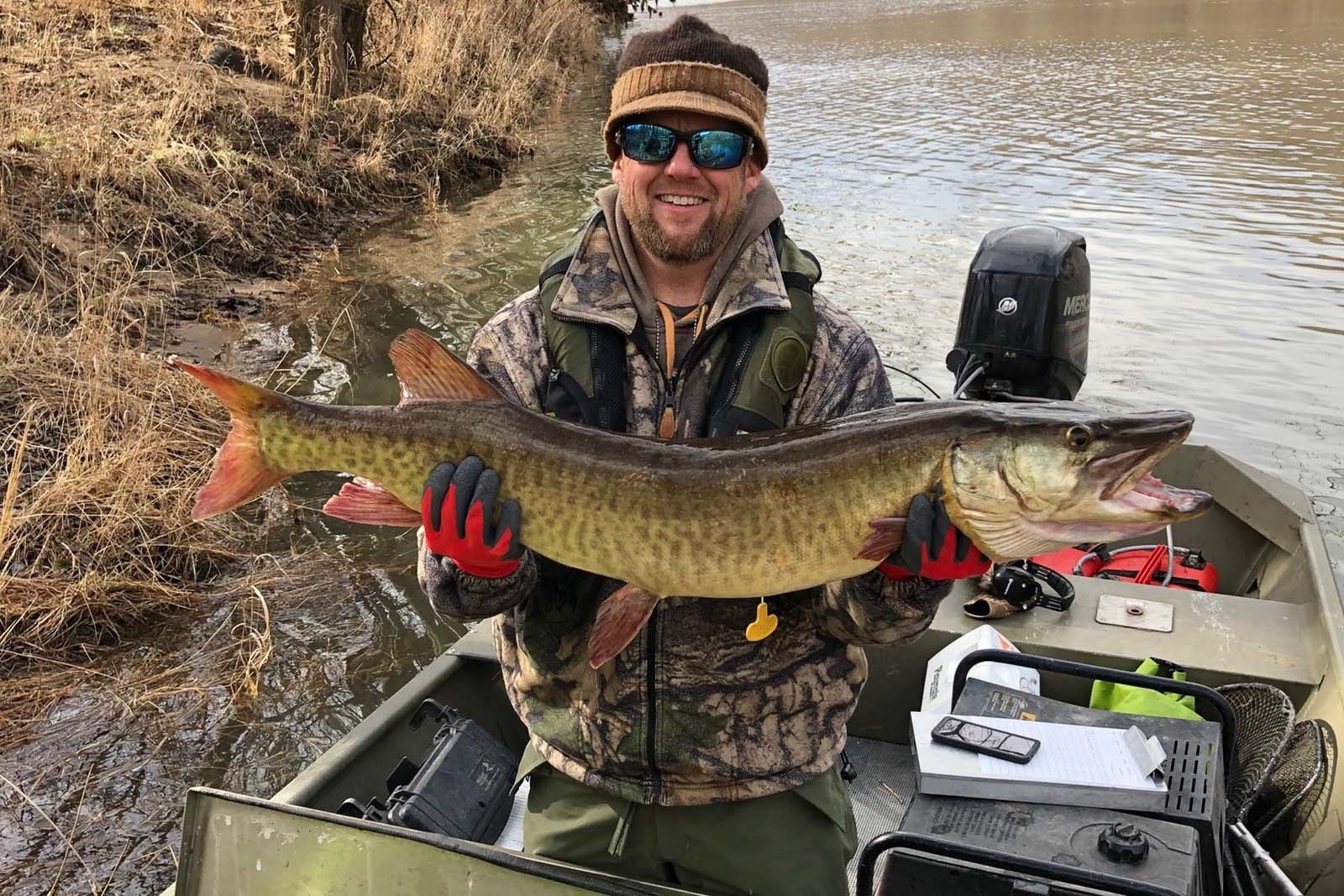
Cooperative Efforts for More Musky
DWR fisheries biologists worked with staff from the North Carolina Wildlife Resources Commission (NCWRC) to collect adult muskellunge, or musky, from the lower New River. This is a continuing partnership in which DWR provides a small number of adult musky to NCWRC, which uses these fish in their hatcheries to produce fingerling musky for stocking in North Carolina. In return, DWR receives a large number of musky fingerlings for stocking throughout the Commonwealth.
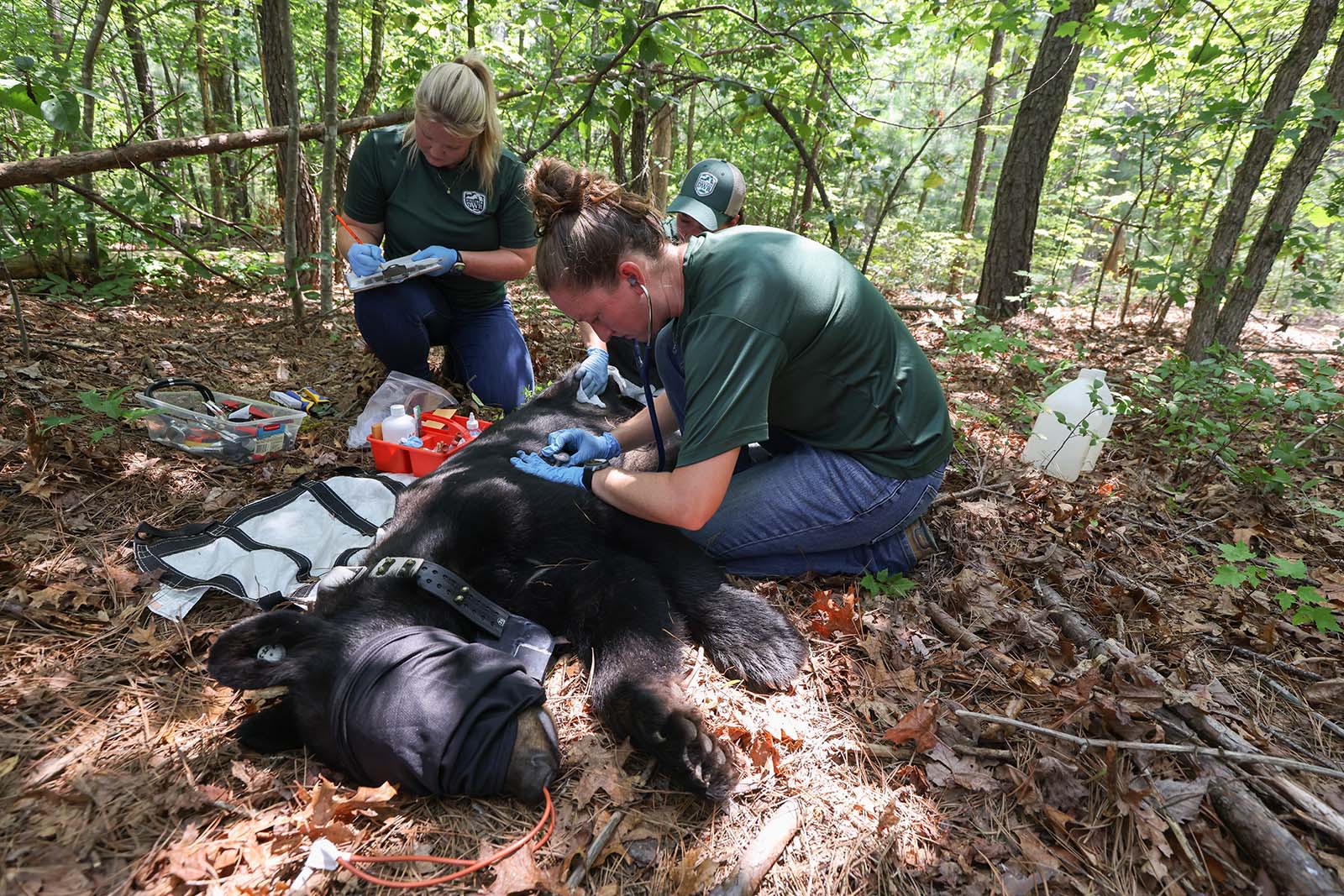
Seeking the Understand Mange in Bears
DWR field work for a large research project to assess the impact of sarcoptic mange on Virginia’s black bear population began in the spring of 2024. This project seeks to improve knowledge of mange impacts on bear populations and DWR’s ability to make proactive management decisions to offset potential mange outbreaks. Data from GPS-collared bears in the study areas—including sample collection from hunter-harvested bears, trail camera images in the study area, and reports of sightings of collared or tagged bears in the study area—will be used to investigate how mange affects bear behavior. Samples from captured bears will also be used for multiple research projects, including multi-state projects being coordinated by the Southeast Cooperative Wildlife Disease Study (SCWDS). Data collected in the first field season included 1,399 hair samples captured in hair- snare grids, capture of more than 30 bears, GPS collar application to 11 bears, and VHF ear tag application to 19 bears.

Conserve. Connect. Protect.
DWR connects people to Virginia’s outdoors through education and information about boating, fishing, hunting, trapping, wildlife viewing, and other wildlife-related activities. Communication efforts focus on safety and enjoyment of wildlife resources by all Virginians.
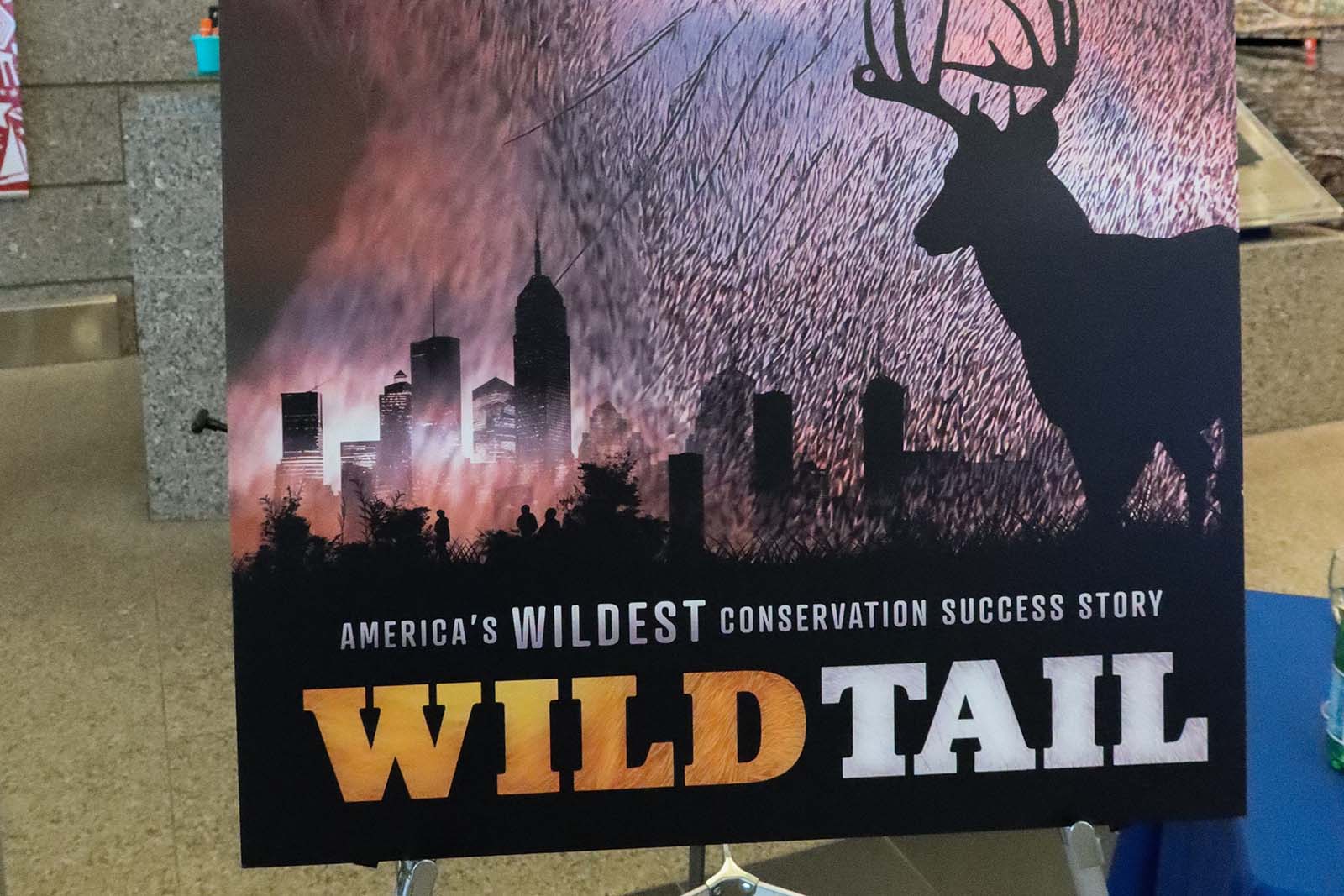
WildTail: America’s Wildest Conservation Success Story
As a member of the Southeast Deer Partnership’s Steering Committee, DWR contributed to all aspects of the development of this documentary, for which the intent was to inform individuals who have an interest in hunting but don’t have a ready means of getting involved in the sport and the public of the importance of our deer resource. Narrated by country music star Dustin Lynch, the documentary guides viewers on the unlikely journey of white-tailed deer from near extinction back to an ecological and economic hero of America’s native landscapes. DWR hosted a Virginia viewing party of the film in the fall of 2023, and the documentary has now been posted on YouTube. DWR promoted the documentary through social media, email newsletters, and press releases.
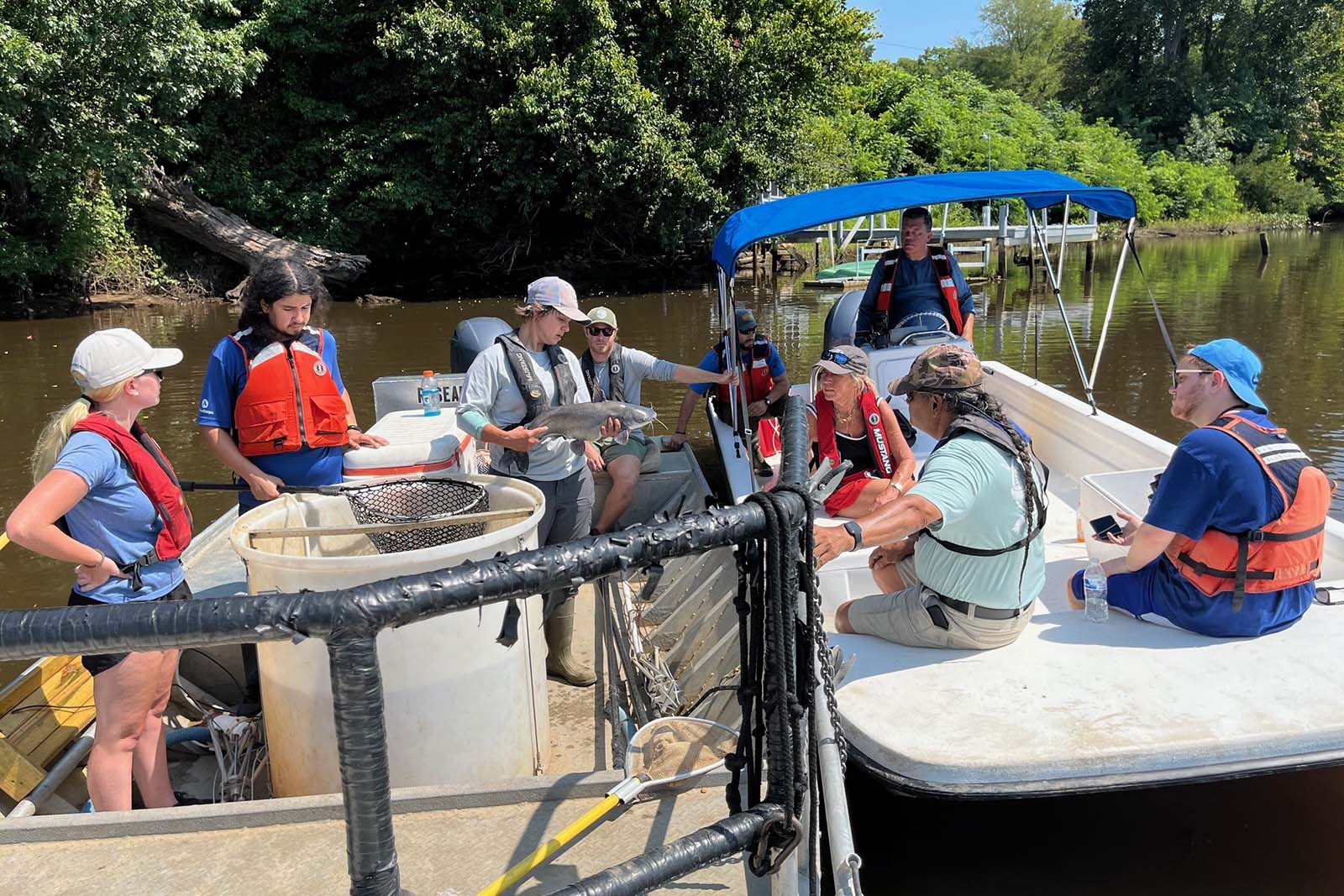
Upper Mattaponi Tribe Joins DWR Aquatics
DWR Aquatics staff partnered with the Virginia Institute of Marine Science (VIMS) to organize an annual field trip with the Upper Mattaponi Tribe on the Mattaponi River. Participants floated downstream from Aylett to West Point, observing fishes, wetlands, and wildlife along the way. Mattaponi tribal elders described tribal connections and cultural heritage as well. This is the third year for this cooperative effort, and Aquatics staff hopes to expand the idea to other regional Native American tribes.
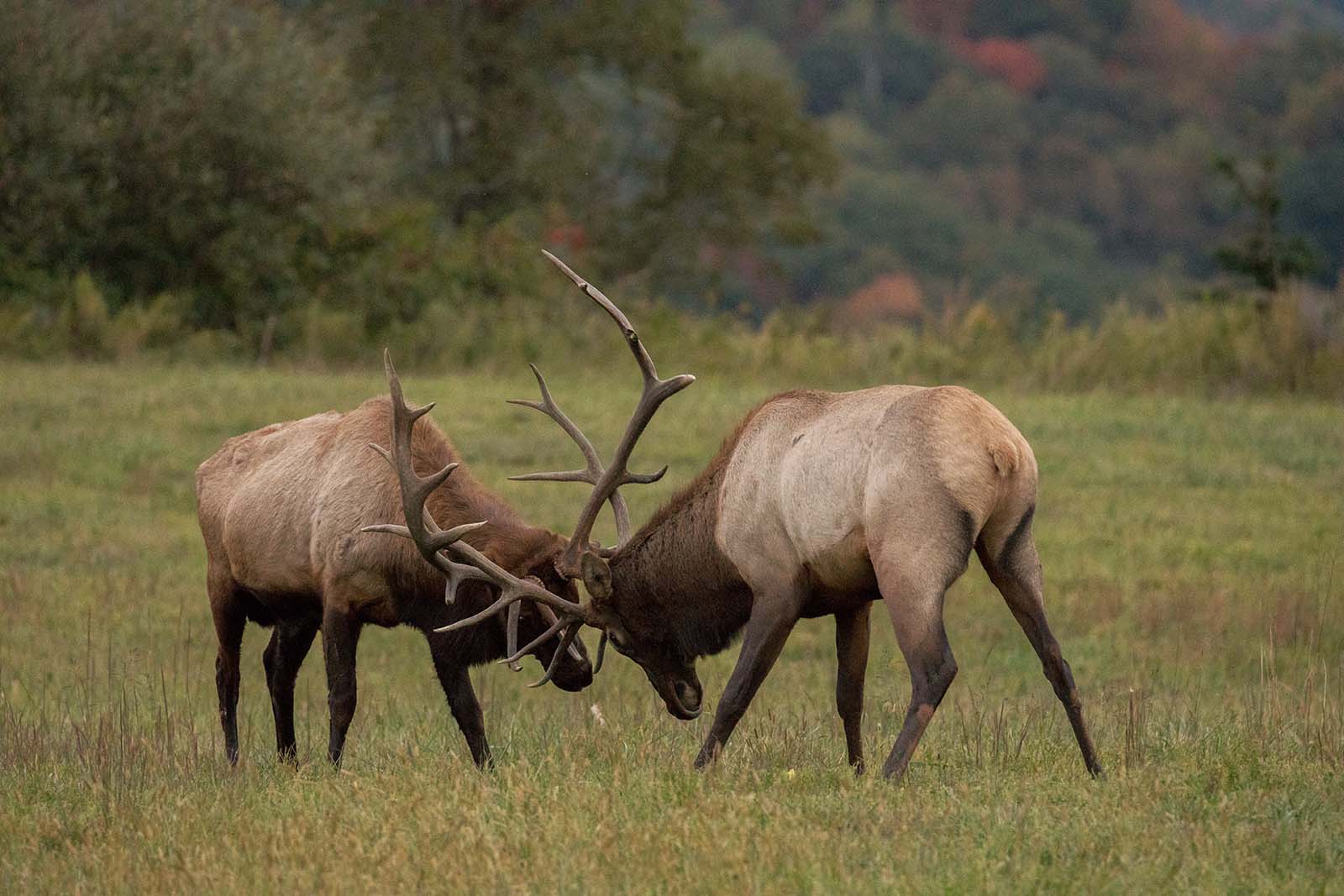
Elk Program Engages on Multiple Levels
Virginia’s restored elk herd continues to thrive, contributing to wildlife viewing and hunting opportunities. Six elk hunters were successful in 2023, harvesting bulls from 526 to 755 pounds. One bull sported a small metal ear tag, which indicated the animal was original to when DWR translocated 75 elk from Kentucky to Buchanan County, Virginia (making him 11.5 years old at harvest). The 2024 elk hunt license lottery had 19,764 applicants and generated $325,000 in revenue for habitat work. DWR offered public elk viewing tours in the fall of 2023. Additionally, the elk web cam was live September – December 2023, and had more than 150,000 views from almost 30,000 users.
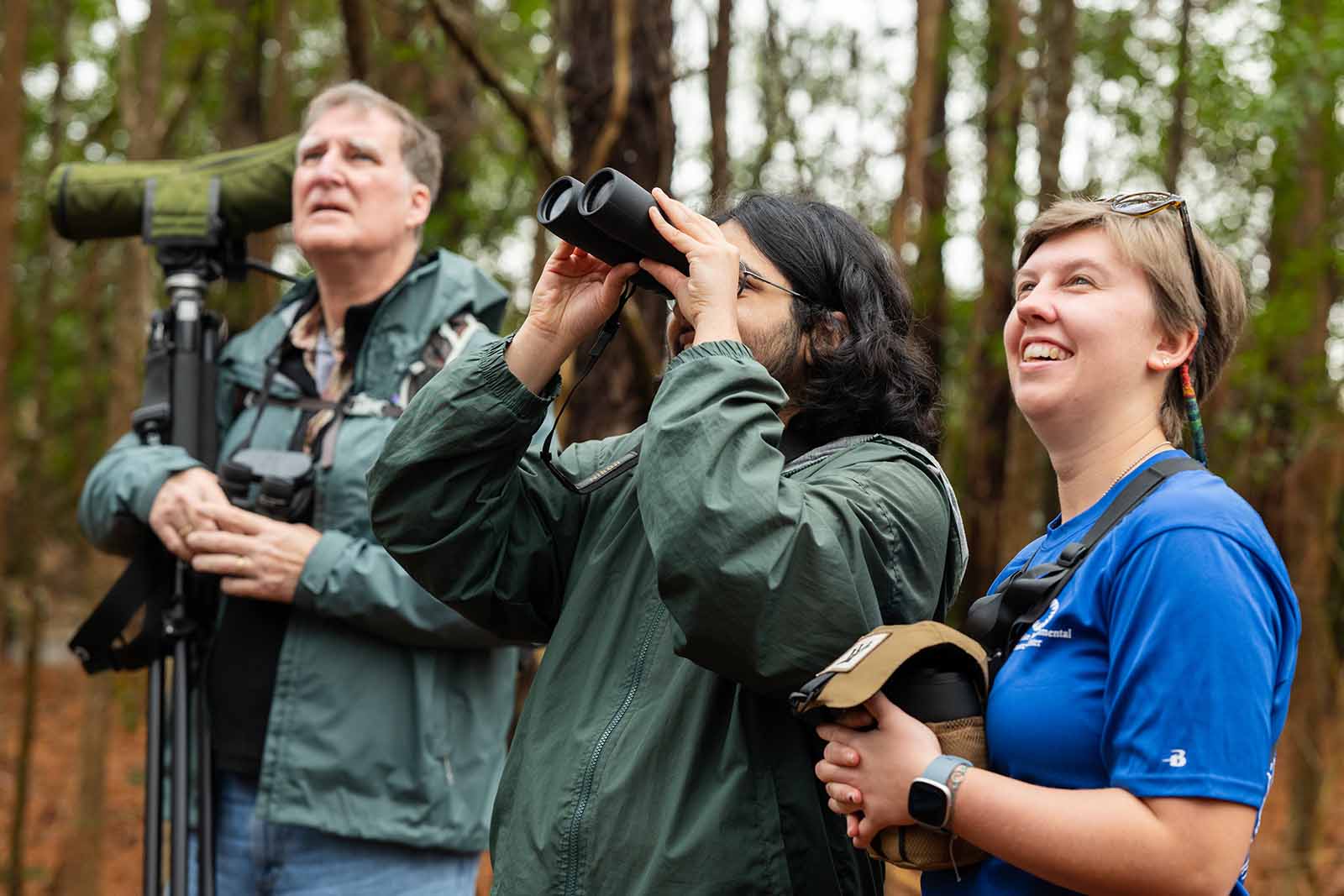
Virginia Birding Classic
Aided by partners at the Virginia Department of Conservation and Recreation (DCR), Virginia Department of Forestry (DOF), U.S. Fish and Wildlife Service (USFWS), Virginia Society of Ornithology (VSO), and Cornell Lab of Ornithology’s eBird, DWR launched the inaugural Virginia Birding Classic—a statewide birding competition that invited teams of birders to go birding on public lands within the Commonwealth. Developed to encourage the public to explore their public lands and to generate revenue for the Virginia Wildlife Grant Program, the competition encouraged teams to use DWR’s Explore the Wild web-based outdoor recreation finder application to identify nearby wildlife viewing opportunities on public lands and log their sightings through a partnership with the Cornell Laboratory of Ornithology’s eBird service. All registration proceeds benefited the Virginia Wildlife Grant Program.
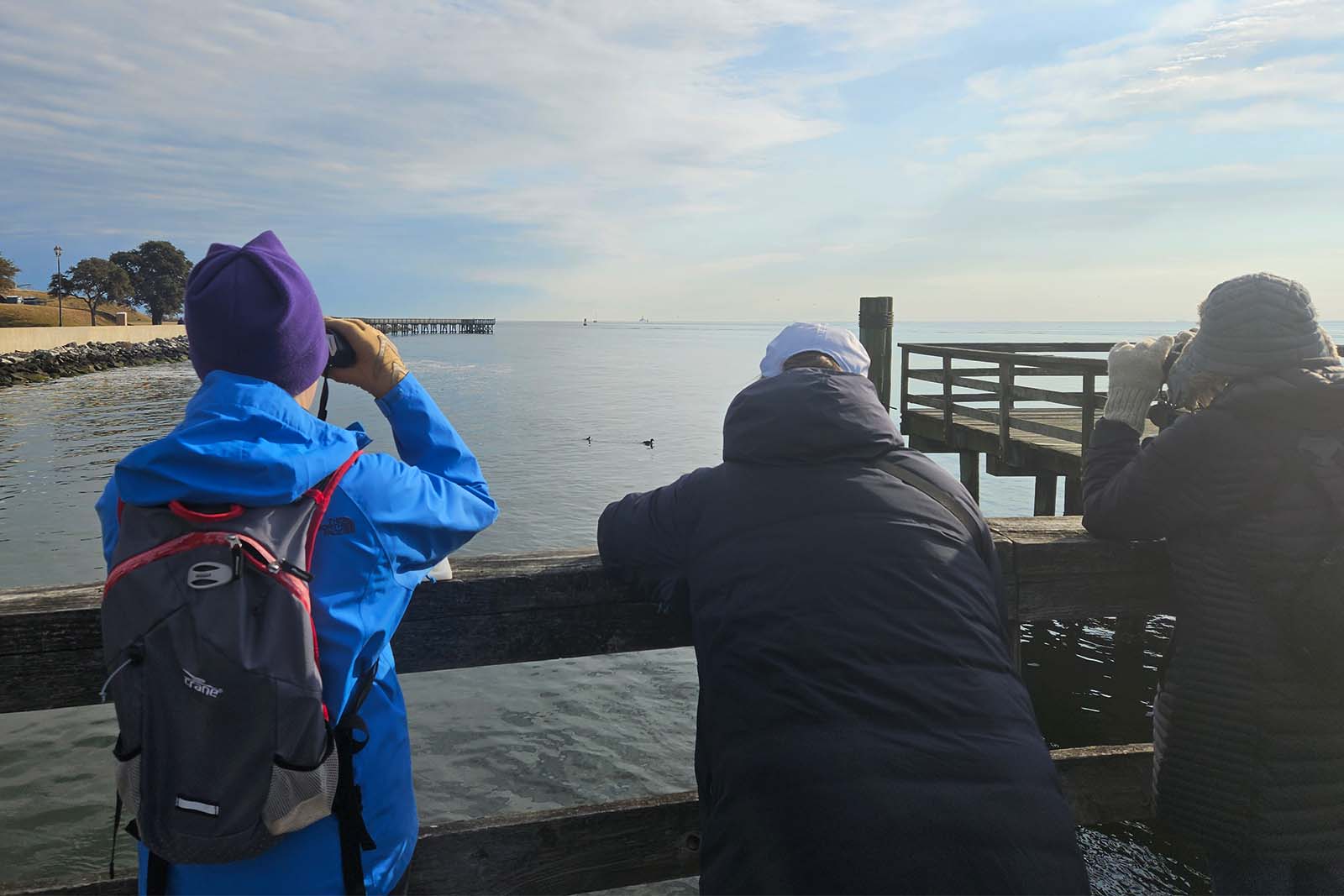
Birdability Project Begun
For people with disabilities, lack of information can be a major barrier to wildlife viewing away from home. With input from Birdability, a non-profit organization that works to ensure the birding community and the outdoors are welcoming, inclusive, safe, and accessible, DWR’s Watchable Wildlife team is pioneering the statewide Birdability Project to determine which Virginia Bird & Wildlife Trail (VBWT) sites are accessible. Data collected by volunteers will be used as filter options in a new VBWT interactive map, as well as being added to Birdability’s crowdsourced map.
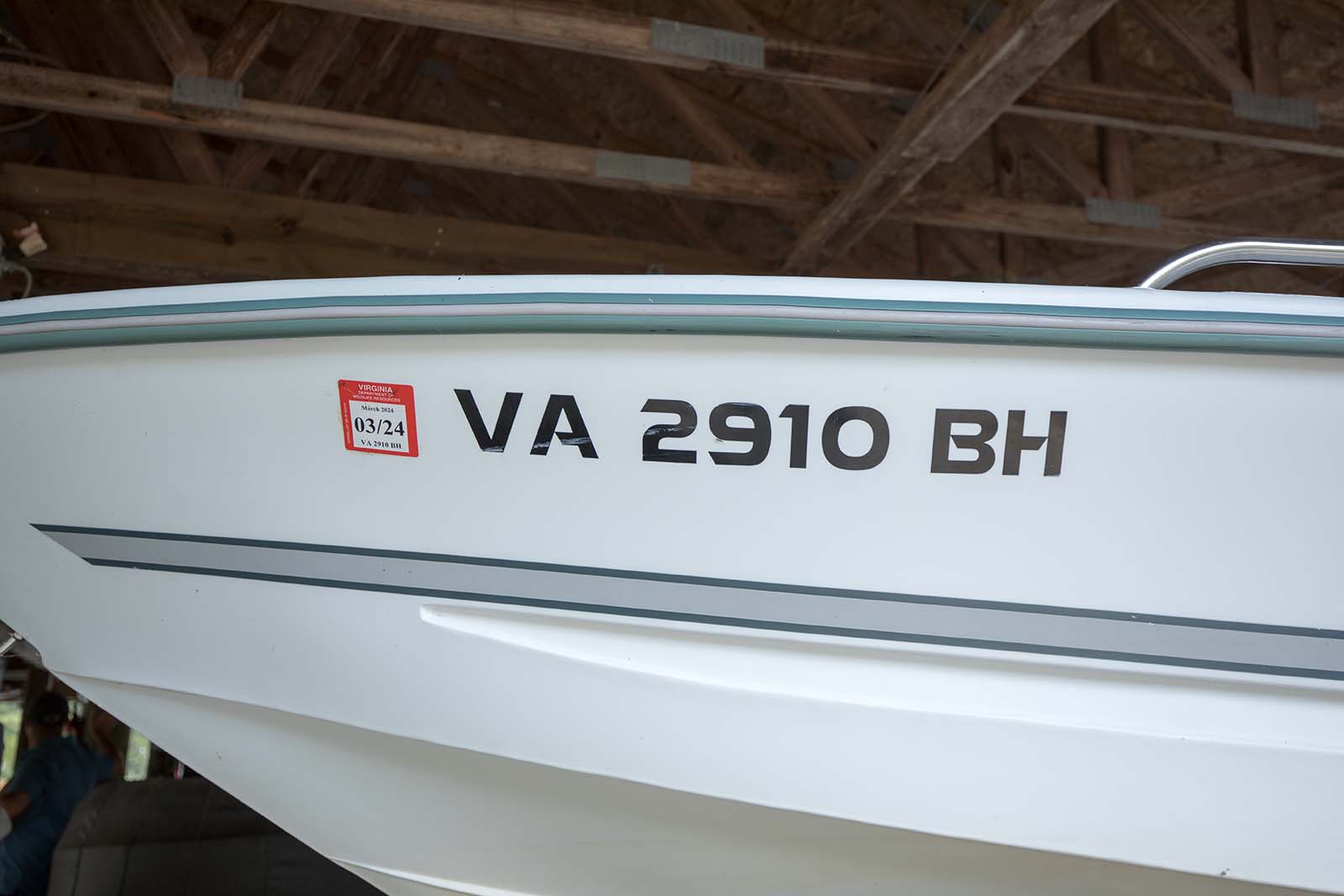
Enhancing Boat Registration
A series of digital marketing tactics focused on reducing paper usage and promoting eco-friendly practices in the boating registration renewal process. Refreshing the language of email efforts, automated push notifications, and targeting lapsed boaters with ads helped result in 43,449 vessel registration sales, generating more than $1.5 million in revenue.
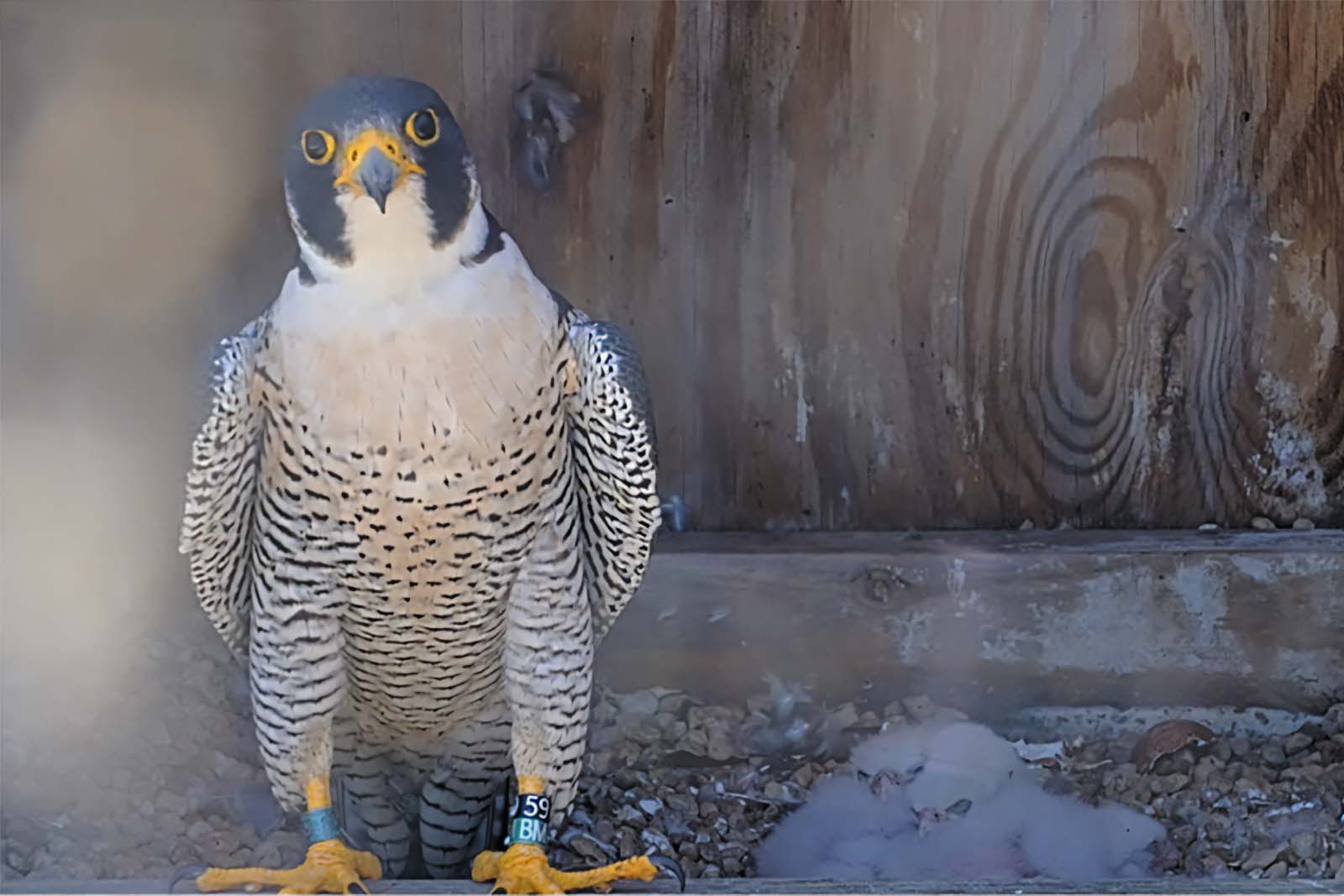
Wildlife Viewing Cameras
The Richmond Falcon Cam went live with a brand new, state-of-the-art camera that provided improved audio and video. For the fourth year in a row, the falcon pair produced and fledged four chicks downtown. The Marsh Cam, a camera overlooking a tidal marsh habitat and two managed impoundments at Hog Island WMA that can be remotely controlled, is being utilized more in classrooms across the state. A connection to iNaturalist allows public wildlife observations to be logged and displayed on the website—more than 1,700 observations of more than 100 species have been recorded. The Elk Cam, which highlights and informs the public about Virginia’s elk restoration project, uses a 4K camera complete with audio to capture the elk herd in Buchanan County. Viewers can see elk grazing and hear the iconic bugles of bull elk. Meanwhile the Shad Cam, a camera aimed through a window into the waters of the James River, allows viewers to glimpse a wide variety of fish species as they navigate the fish ladder at Bosher’s Dam in the metro Richmond area. Users documented more than 100,000 fish passthroughs.
Learn More About DWR’s Wildlife Viewing Cams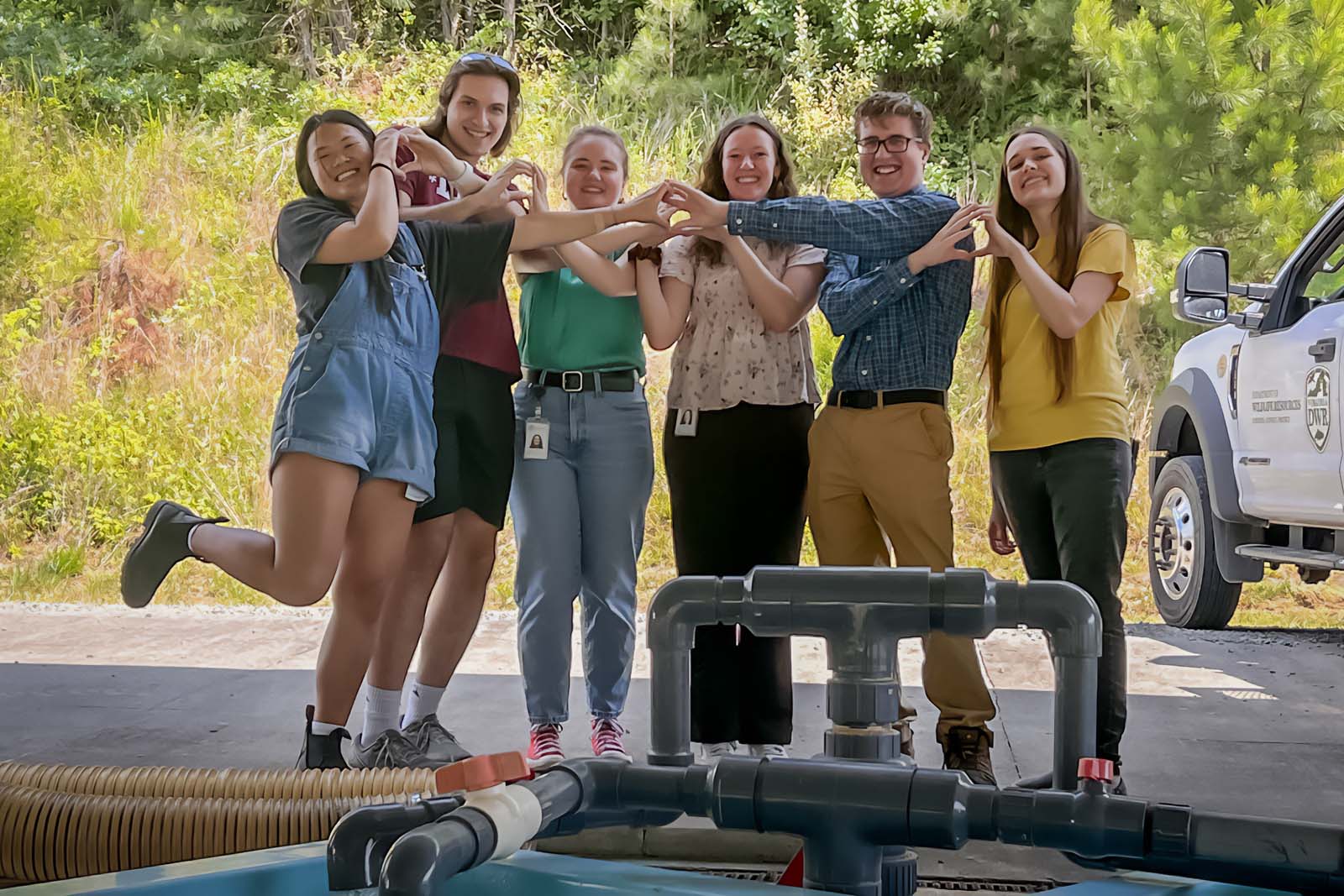
19 Summer Internships Completed
DWR’s Human Resources division partnered with 19 DWR mentors to recruit for and hire 19 college summer interns, the third year in a row that DWR has held the Summer Internship program. The Human Resources team provided five learning opportunity field trips: introduction to paddling; outreach day at Holiday Lake; seabird conservation project in Hampton Roads; introduction to electrofishing and sampling; and a tour of Big Woods WMA.
Learn More About DWR’s Summer Internship Program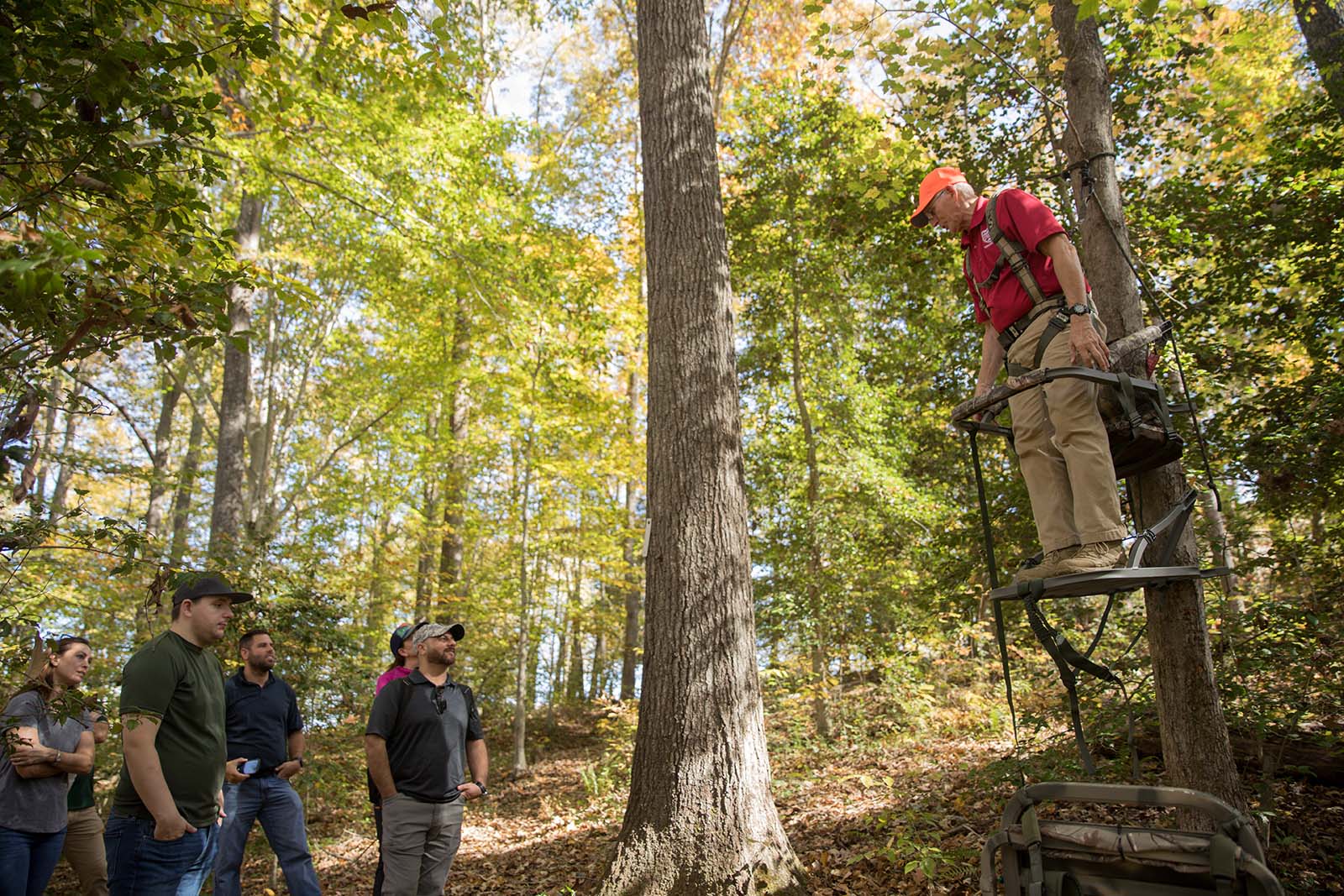
Becoming a Virginia Hunter
A partnership with the National Deer Association (NDA) and the Southeast Deer Partnership (SDP) enabled this inaugural educational event, where the Outreach team took a proactive approach to recruiting new deer hunters by inviting 31 individuals to learn about hunting. Following the event, the majority of attendees reported feeling somewhat confident to very confident in performing the skills they were taught. When asked how likely they were to begin hunting, the average score was 9.1 out of 10 (with 10 being the most likely). In a separate event, 28 hunting-adjacent individuals attended a workshop focusing on spring gobbler hunting. Topics included shotgun live-fire and how to pattern a shotgun, shooting from a ground blind, shot placement, scouting techniques, and decoys.
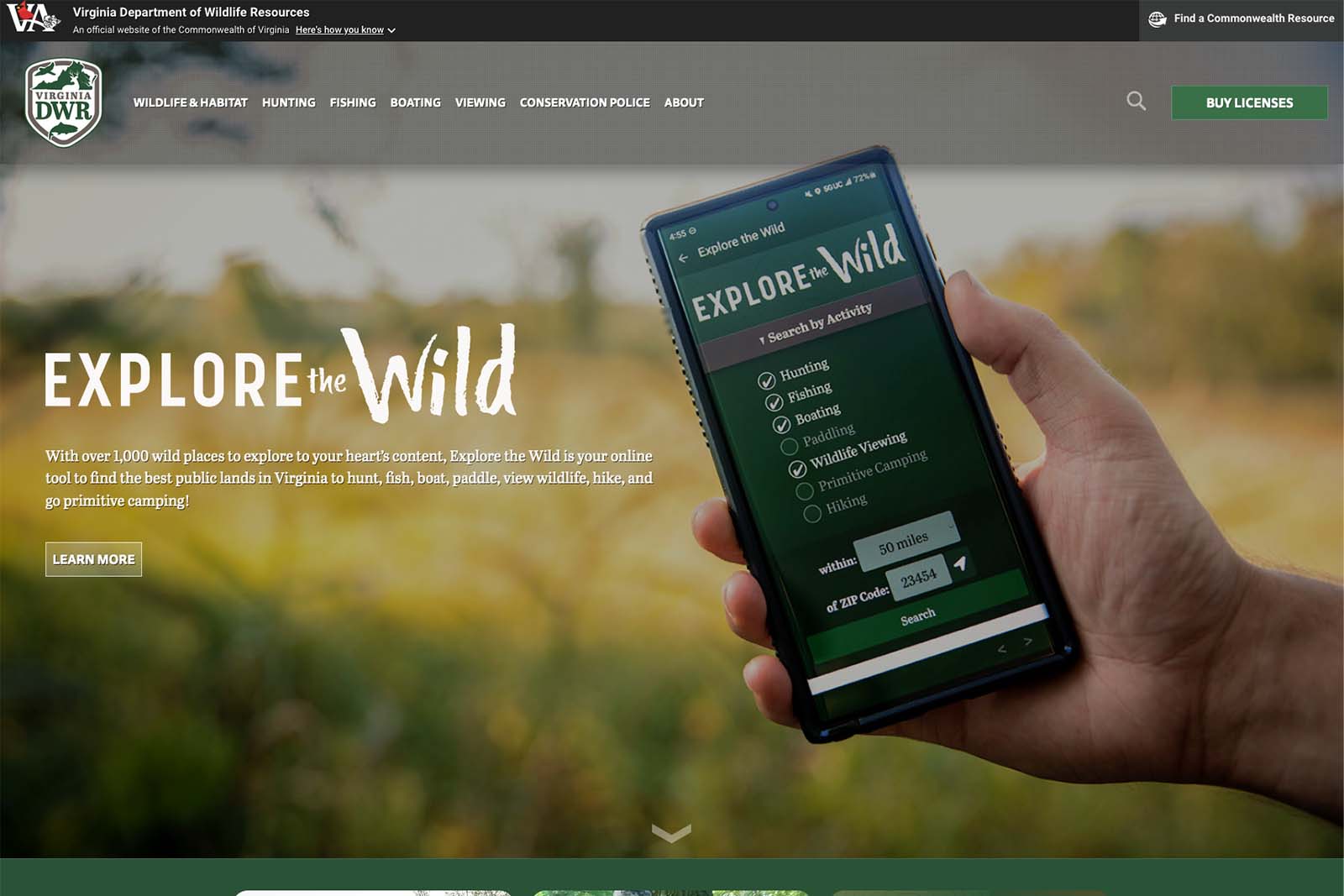
Website Wins Award
The DWR website was recognized as the Agency with the Highest Overall Score in the Virginia Information Technology Agency’s (VITA) Cyber Sweep Competition with a score of 99.9 (out of 100). As a part of the Commonwealth’s ongoing website modernization effort, the competition ranked agency websites on content quality, accessibility, and freshness, as well as security and user experience. The Outreach Division’s Communications and Marketing digital outreach staff have dedicated time and resources to ensure that the agency’s website meets or exceeds content and technical quality measures. In fact, the DWR website surpasses the industry standard average scores for each of the three overall metrics that VITA monitors: quality and user experience, accessibility, and search engine optimization.
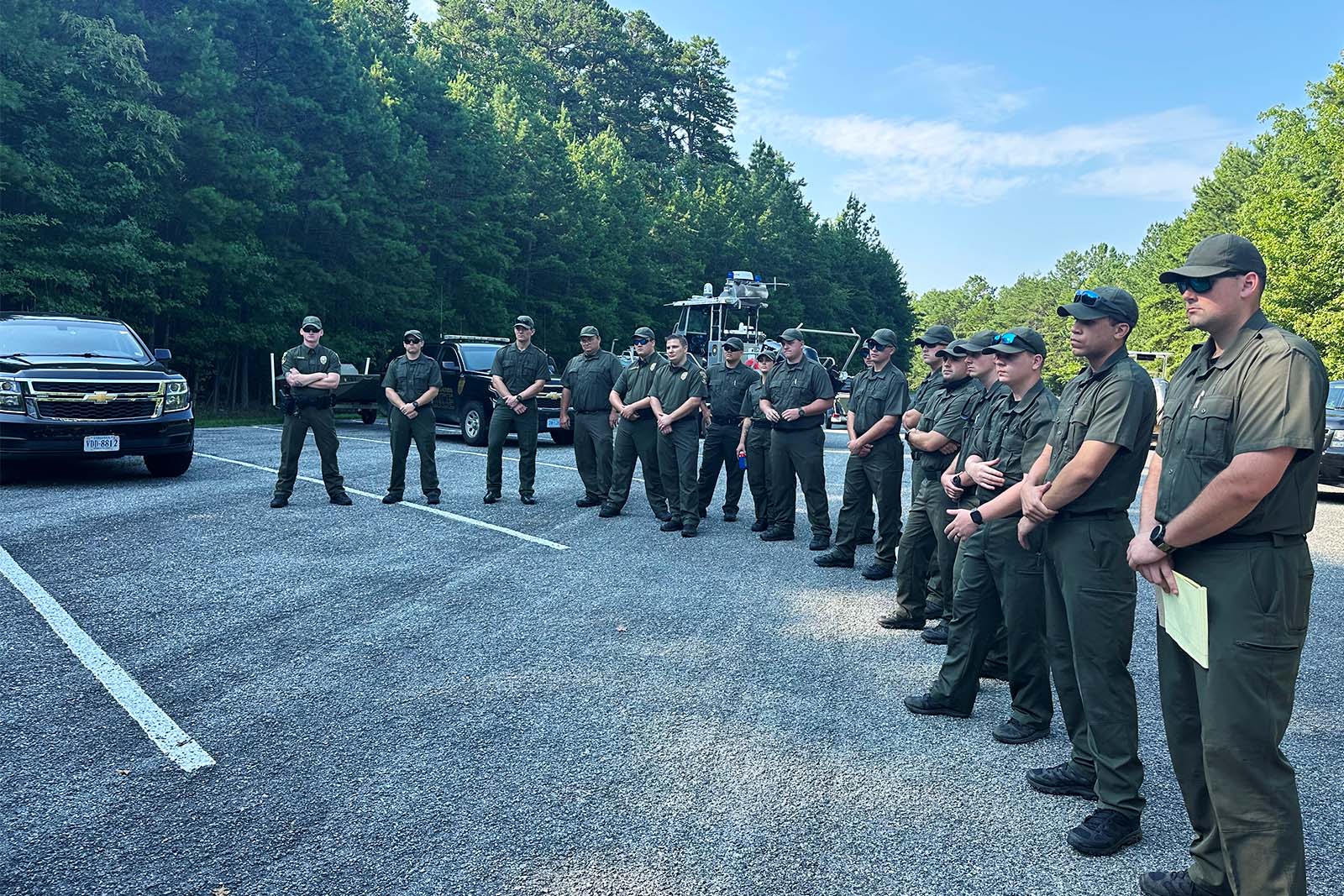
CPO Recruitment Success
An intentional effort was made to review Conservation Police Officer (CPO) recruit hiring practices and remove potential barriers by identifying best practices in recruiting and engaging potential law enforcement candidates. An advertising campaign targeted females and underrepresented populations with content demonstrating to prospective applicants that officers come to the department with different demographic, educational, and employment backgrounds. The Training and Recruiting Section encouraged candidates to keep engaged during the screening process through frequent phone calls, emails, and text messaging, and multiple testing opportunities were provided at each step in the process. As a result, the total number of CPO applicants increased from 390 to 797 (a 104% increase in just one year), which led to the hiring of a group of 25 diverse candidates for the 13th Law Enforcement Academy.
Learn More About Careers as a Conservation Police Officer (CPO)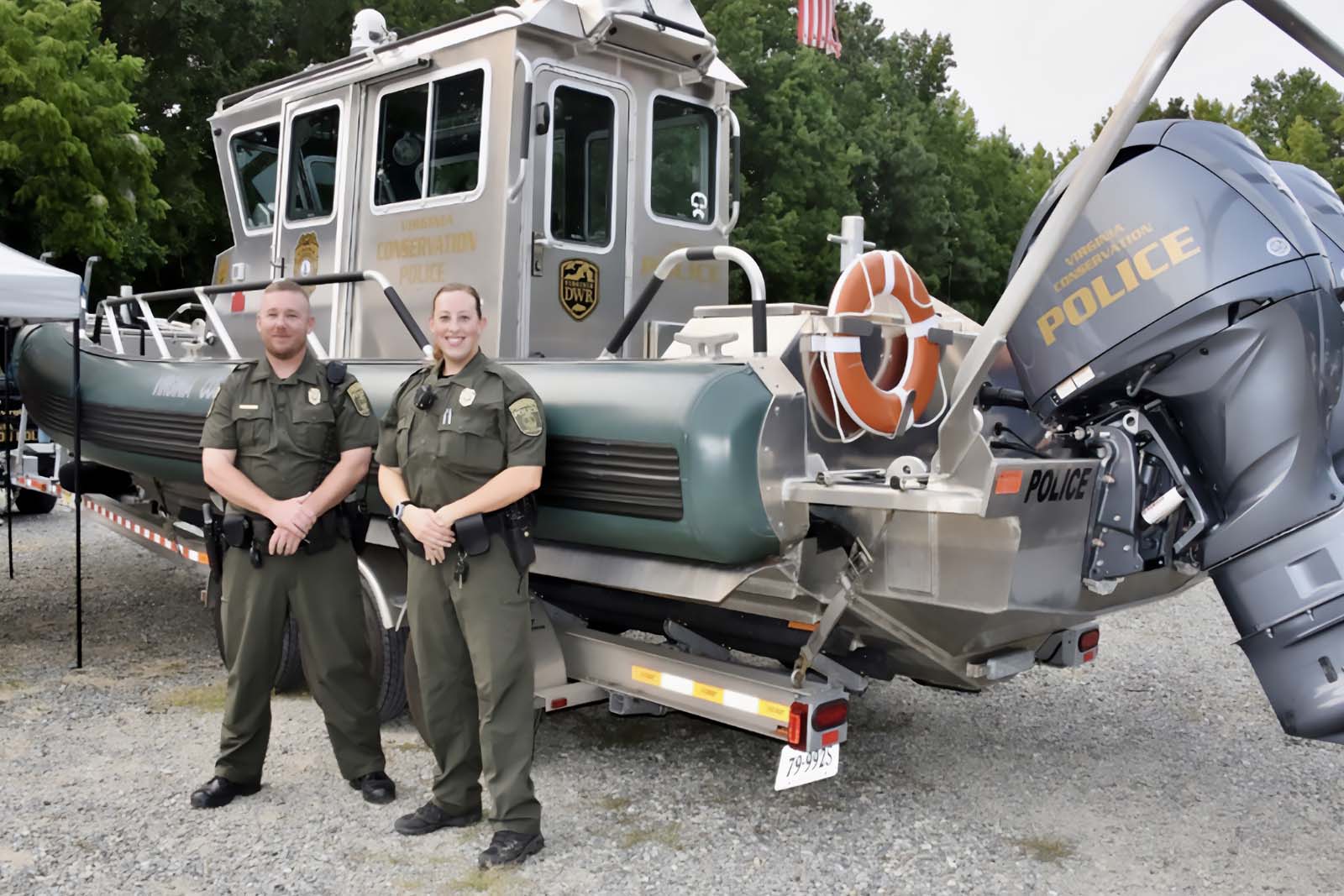
National Night Out
DWR CPOs attended 52 events (33 last year) and interacted with thousands of citizens from across the Commonwealth on National Night Out, an annual community-building campaign that promotes police-community partnerships and neighborhood camaraderie and enhances the relationship between neighbors and law enforcement while bringing back a true sense of community. Furthermore, it provides a great opportunity to bring police and neighbors together under positive circumstances.
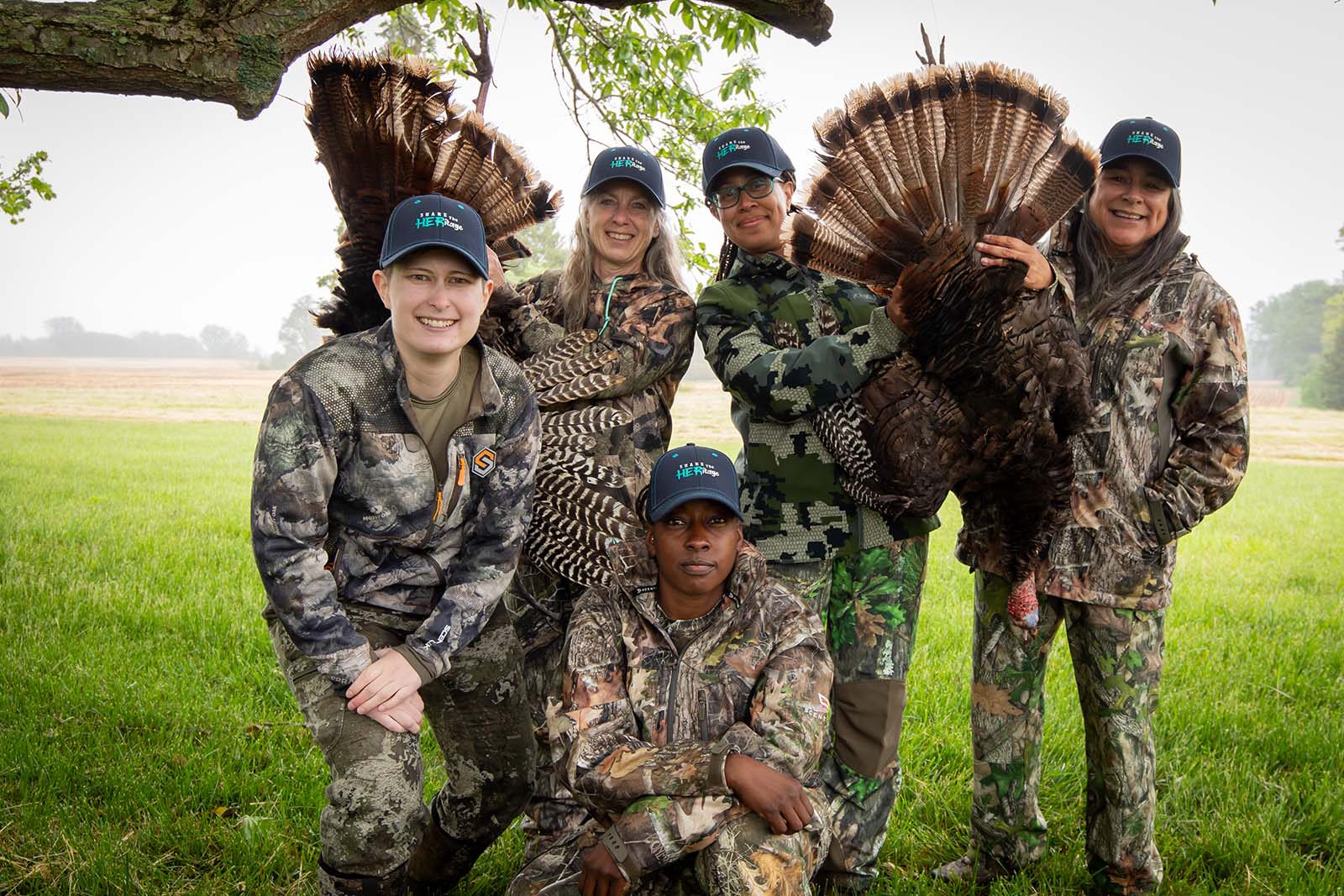
Focusing on the Three Rs
DWR’s Recruitment, Retention, and Reactivation program developed collaborative partnerships with a number of organizations and hosted a wide variety of outreach events, including a Ducks Unlimited Youth Waterfowl Hunt, Monquin Creek Youth Turkey Hunt, Occoquan National Wildlife Refuge Youth and Female Mentored Turkey Hunt, and First Hunts Foundation Share the HERitage/Forgotten Rights Mentored Turkey Hunt.
Learn More About DWR’s R3 Plan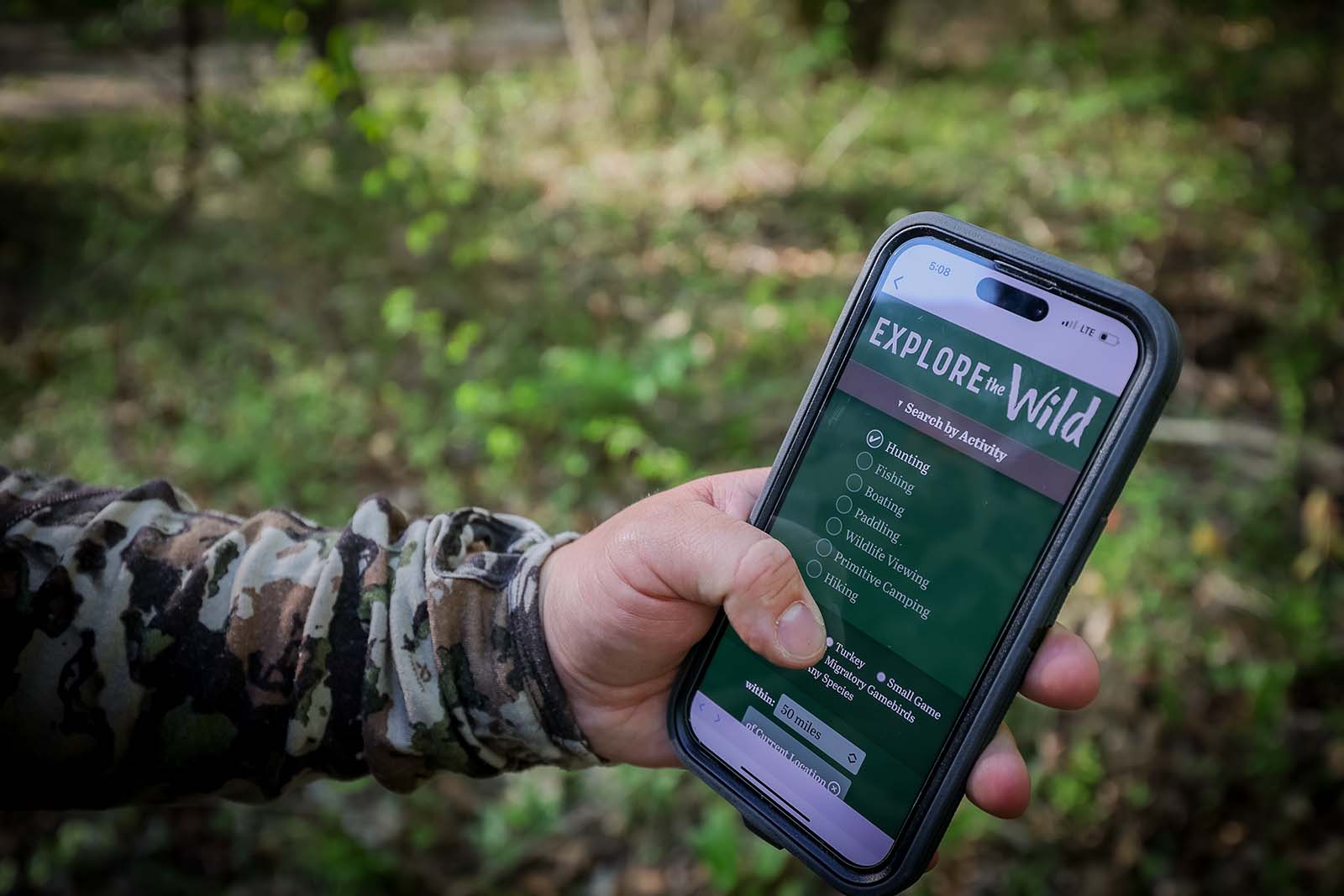
Explore the Wild Online Tool
After extensive planning, testing, and development, Explore the Wild—an easy-to-use web application for users to find public lands that offer recreational opportunities—officially launched in March 2024. Explore the Wild is a robust database of public lands, amenities, and features that includes properties owned and/ or managed by federal, state, county, or municipal governments that invite public access for a variety of outdoor recreational uses. In the first four months, the application was accessed nearly 150,000 times by more than 46,000 users.
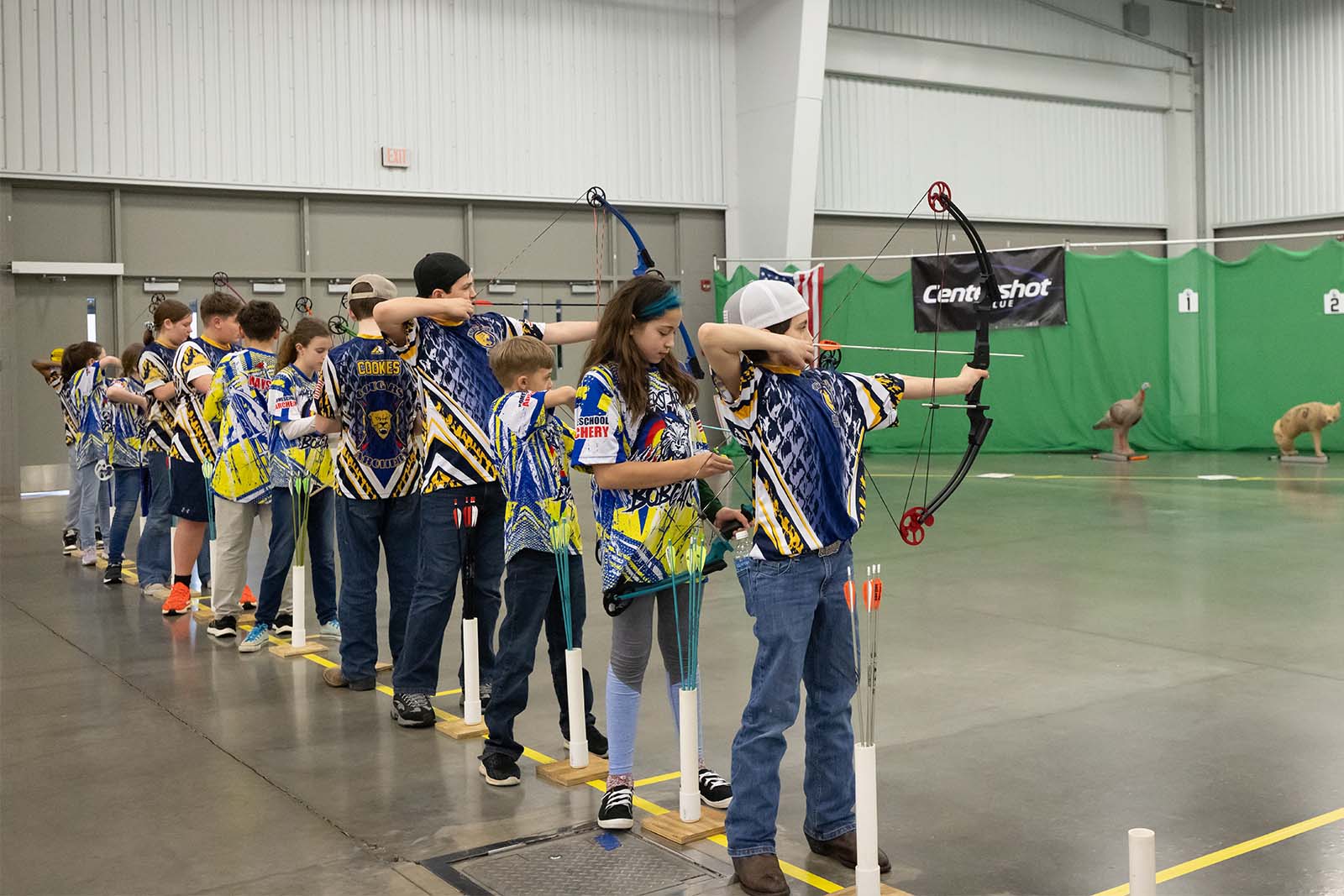
Archery Training Expanded
DWR’s Outreach division staff completed 19 Basic Archery Instructor Certification trainings for the National Archery in the Schools Program (NASP), successfully training 83 Virginia teachers, county parks staff, camp counselors, parent volunteers, scout leaders and support staff in partnering agencies. These trainings will allow teachers to begin teaching archery in over 20 new schools and resume archery instruction in many more schools across Virginia. NASP instructors will provide basic archery instruction to over 20,000 new students in 2023 and 2024. DWR also hosted the 15th Annual Virginia NASP State Tournament/IBO 3D Challenge. Virginia had more than 600 archers compete in the Bullseye State Tournament and the IBO 3D Challenge. Several teams qualified for Nationals and Worlds. Thanks to sponsorships and other funding, $21,000 in educational scholarships were awarded to top archers, with a $10,000 match from NASP, INC. DWR is also continuing to maintain programming for archery in the parks for 30 current community recreational facilities offering archery to their communities.
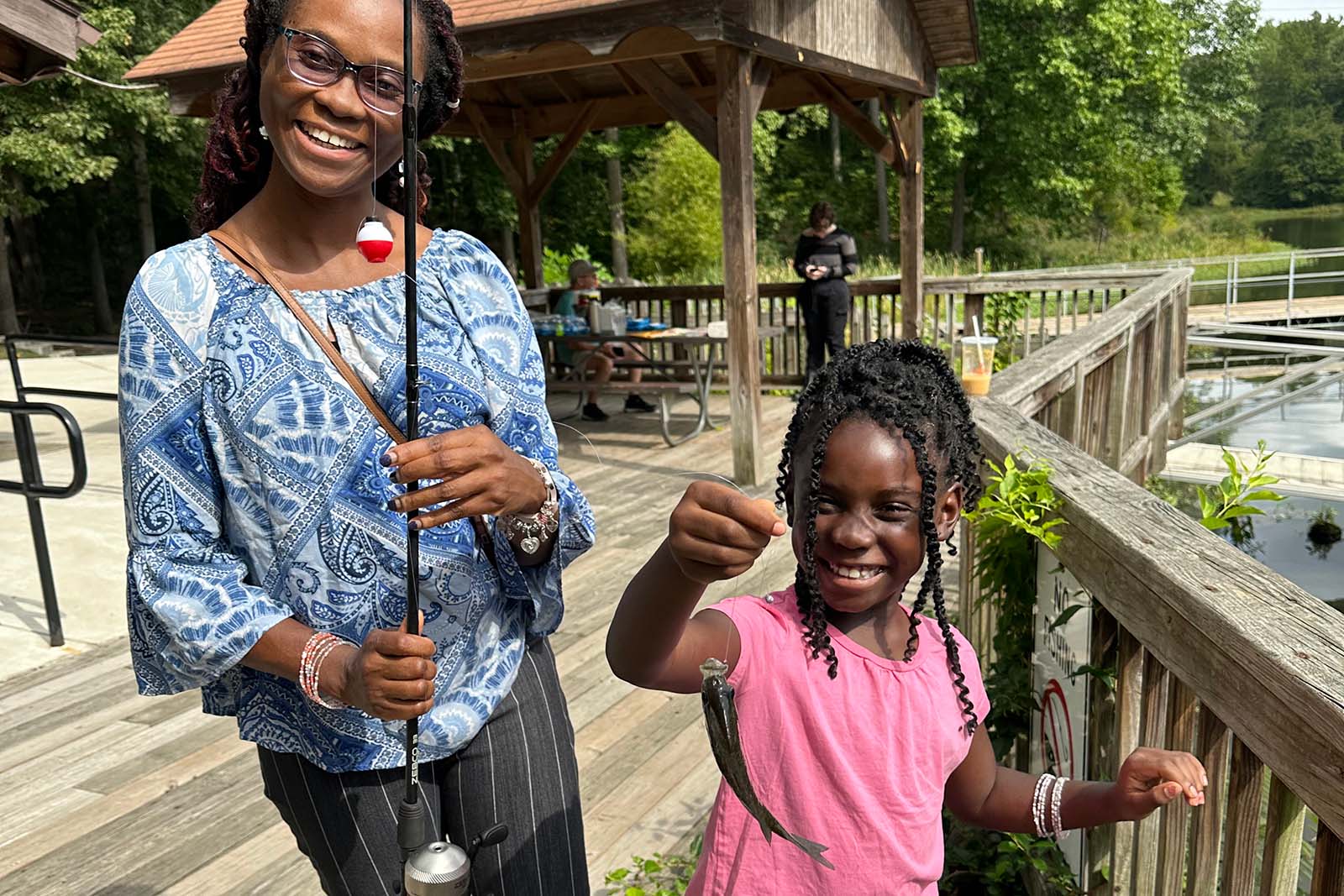
Sharing Fishing
The DWR Angling Education Coordinator hosted fishing outreach events across the state, including at Festival del Rio Rappahannock, Boy Scout Fly Fishing Workshop, Outdoor Afro at Lake Frederick, and more. Angling instructor trainings for 18 partner organizations, including DCR State Parks, local Parks and Recreation Departments, and nonprofit organizations, were successful, while agency volunteers trained more than 15 new volunteers in angling instruction.
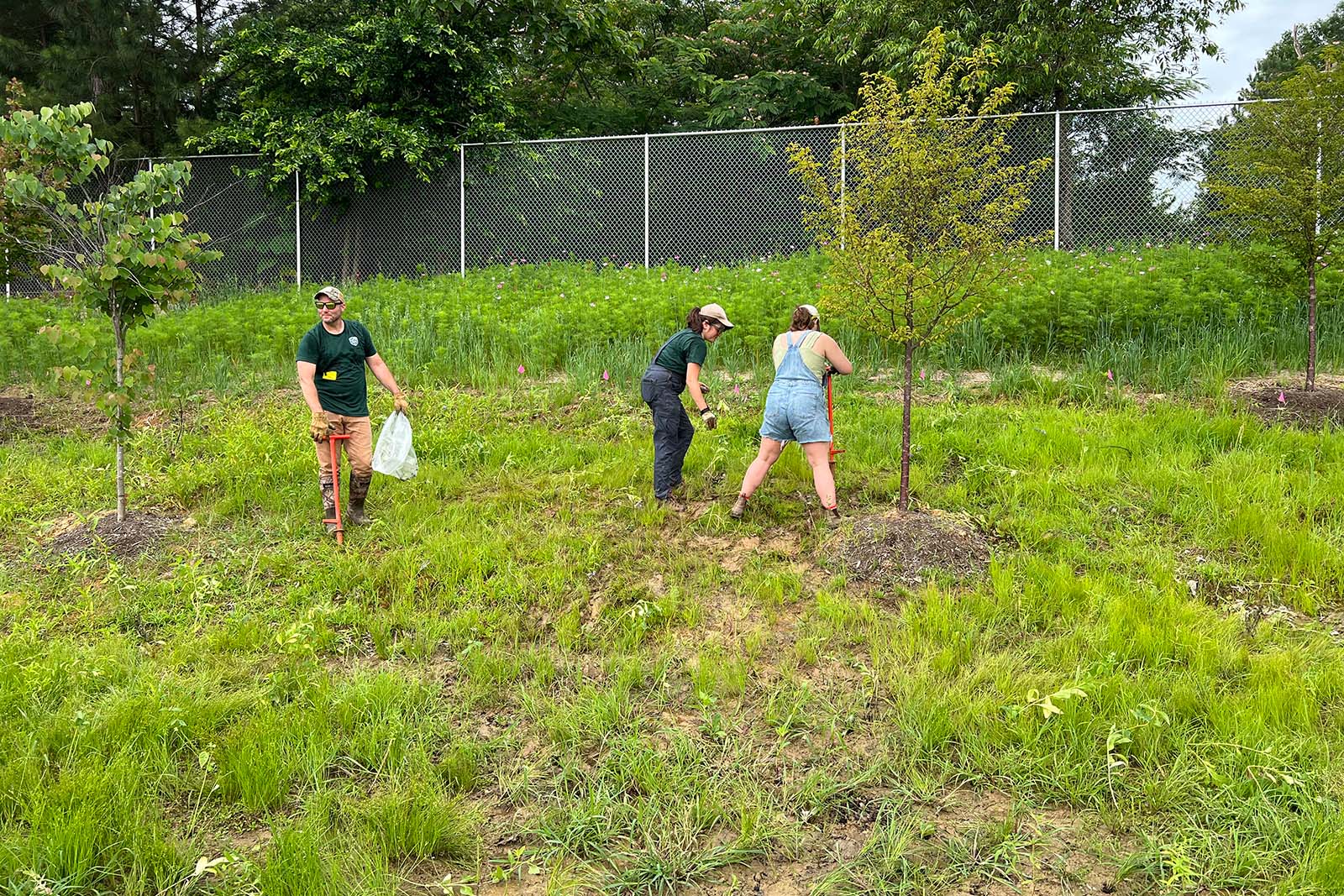
School Habitat Pilot Project
In conjunction with Henrico County Public Schools (HCPS) maintenance, DWR’s Habitat Education Coordinator identified a site that could be converted to wildlife habitat, developed a plan, and coordinated with HCPS staff in its implementation. DWR provided support and led planting and seeding efforts. Coordination with HCPS instructional staff led to the development of a curriculum based on this habitat. DWR volunteers and Master Naturalists were engaged in developing a long-term project support plan. This site will serve as a pilot that informs conversion of other HCPS properties into habitat to support wildlife.
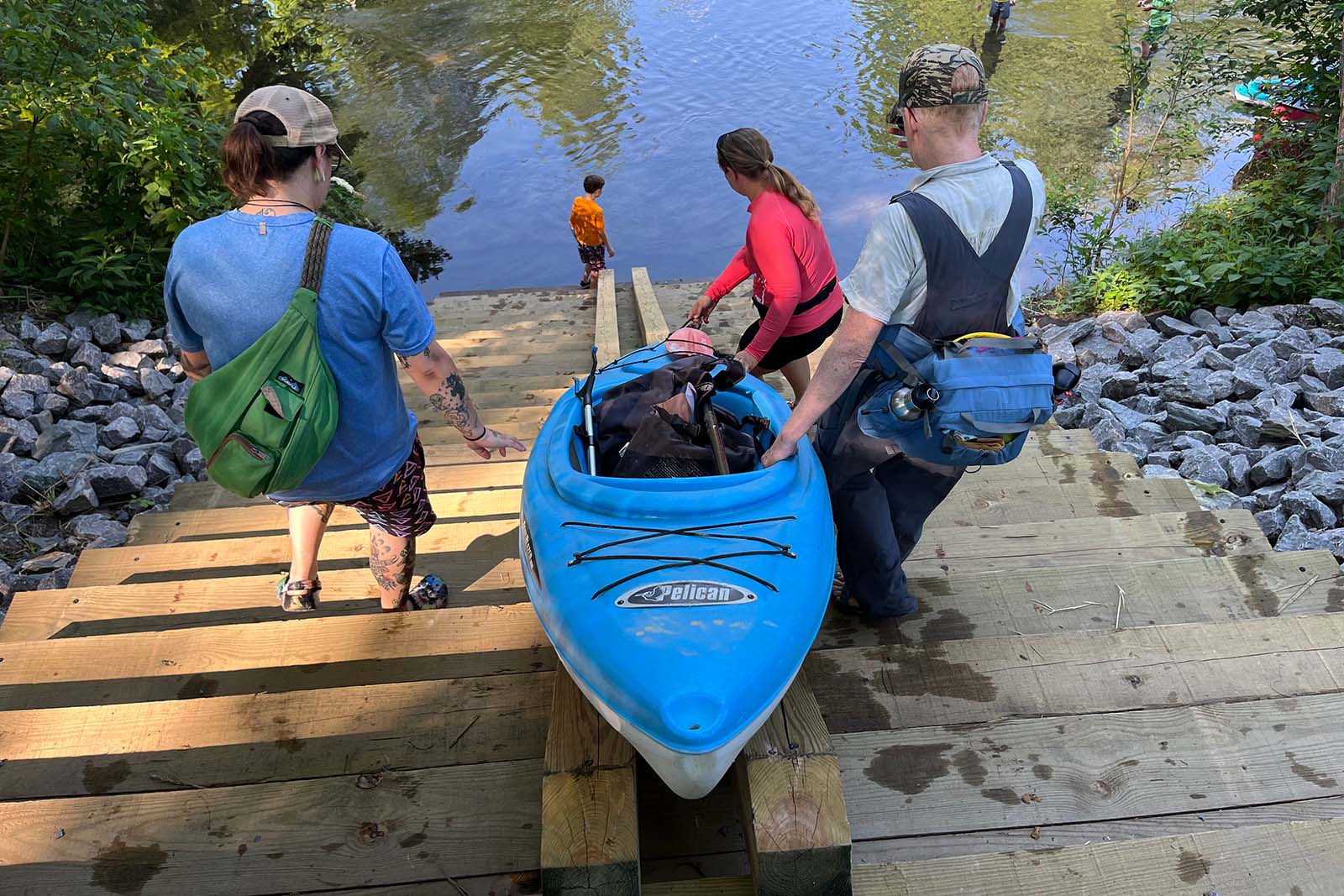
New River Access
DWR worked with the Tennessee Valley Authority (TVA) to develop and open three new boating access sites on the Powell River in Lee County. These hand-launch sites enhance river access for recreational opportunities. In addition, a new river access site opened on the South Fork Holston River in Washington County in partnership with Virginia Department of Transportation (VDOT) and Virginia Department of Conservation and Recreation (DCR).
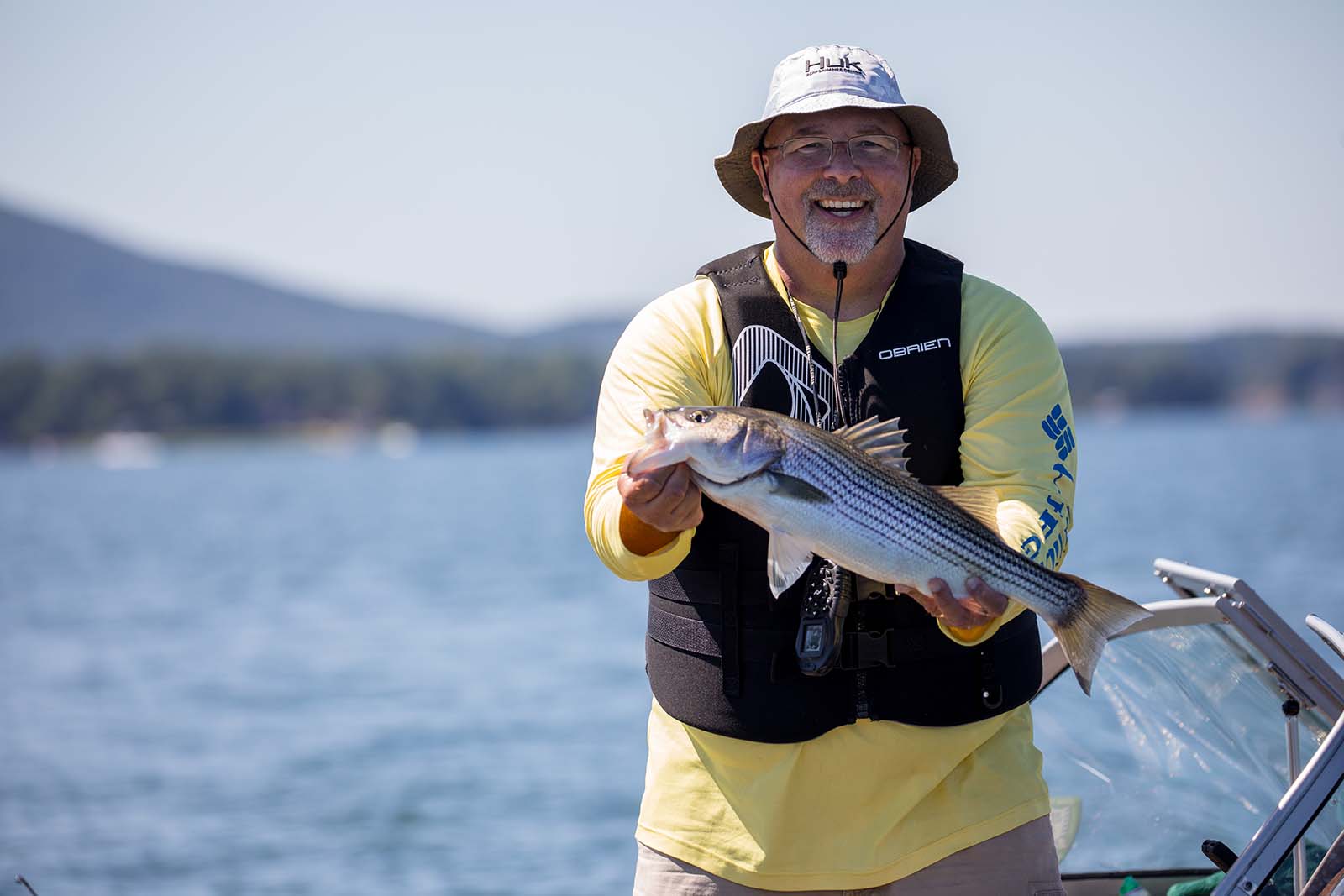
Angler Survey Conducted
DWR’s Human Dimensions Program analyzed the most recent angler survey and yielded important information about Virginia’s freshwater anglers, including that largemouth and smallmouth bass are the most popular species, the average angler fishes 25 days a year in five different locations, and the most popular destinations are lakes and ponds under 500 acres. The survey revealed significant overlap in interests of outdoor enthusiasts and has contributed to estimates of the importance of recreational fishing in Virginia. Combining the results of this survey and an economic impact analysis conducted by the American Sportfishing Association indicates that warmwater streams, large impoundments, and small impoundments combined support north of $125 million a year in economic impact, while coldwater streams are worth nearly $100 million a year to the Virginia economy.
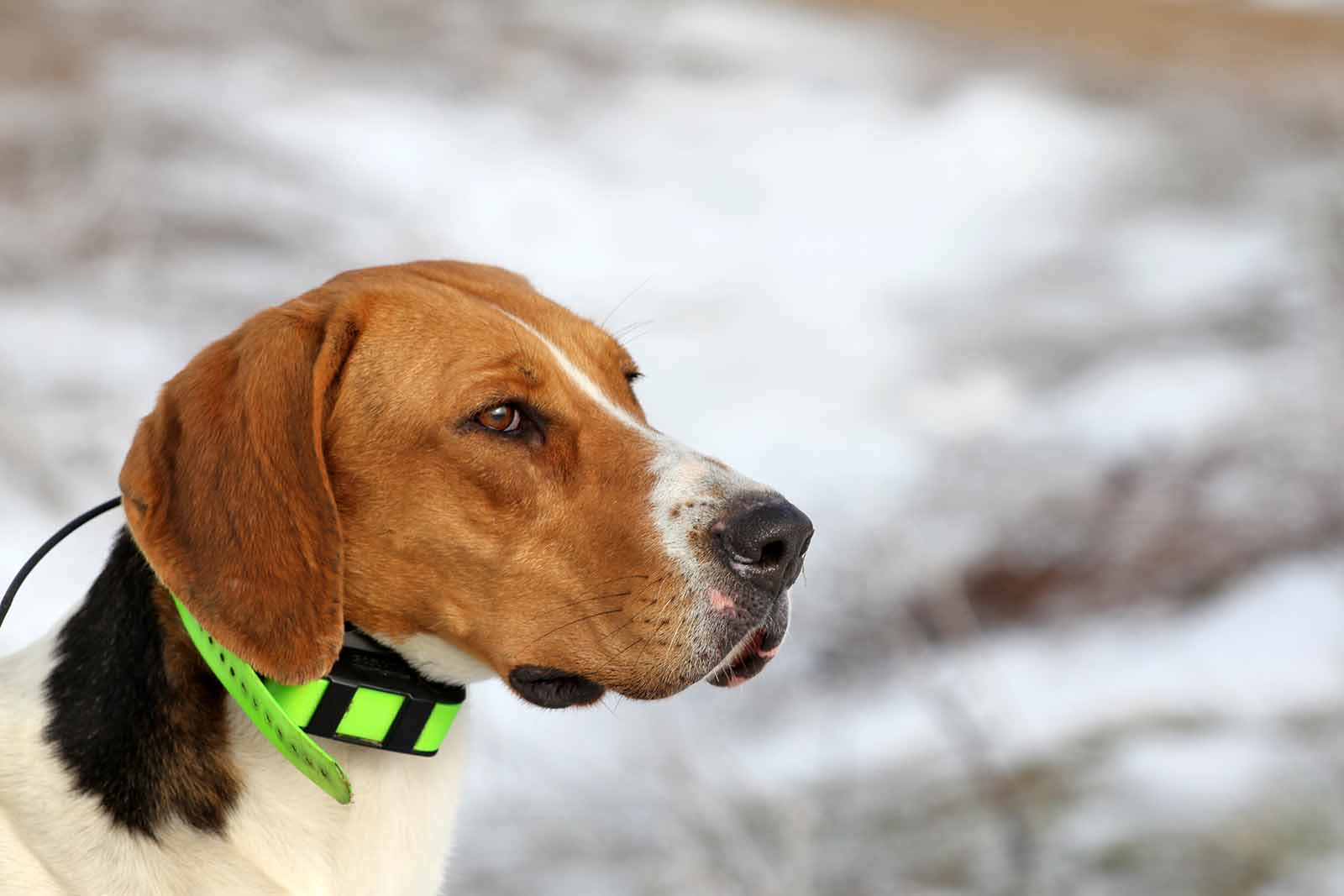
Reducing Conflict
On March 20, 2024, the Board of Wildlife Resources advanced and approved five non-regulatory proposals to assist in reducing conflicts between landowners and hunters who use dogs for deer and bear hunting.
Funding for Conservation Police Officers
DWR is actively pursuing increases to its House Bill 38 transfer dollars, in part intended to enable funding increases for its Law Enforcement division for assistance with hunter/landowner conflicts. A priority will be placed on locating new CPOs in areas where complaints related to hunting with dogs are above average.
Enhance CPO Training and Enforcement Strategies
New training focused on topics related to hunting with hounds was provided to all sworn staff members of the Law Enforcement division, and several members of the Wildlife division. This training will also be provided to new CPOs in future academies. Law Enforcement records all calls for service, including those that involve hunting with hounds. GIS staff maps these calls to highlight areas of the highest concentration of complaints.
Prioritize Enforcement of Prohibitions Against Hunting Out-of-Season
CPOs are conducting targeted enforcement efforts to identify and address chasing deer and bear during the closed seasons. Since February 2024, CPOs have investigated numerous complaints and placed charges where appropriate. During the general firearms deer season, CPOs enhanced enforcement efforts in areas where an above-average number of calls for service were received.
Enhance Outreach to Communities, Hunters and Landowners
The Outreach division completed a review of existing relevant outreach efforts by DWR and other states related to deer and bear hunting with dogs, evaluated the development and delivery of public awareness efforts, and developed educational information about deer and bear hunting with dogs, including ethics, best practices, and applicable laws and regulations. DWR is also enhancing communications through dedicated staff.
Enhance Educational Efforts
Multiple divisions collaborated to create Best Management Practices (BMPs) for both Hunters and Landowners. The Outreach division created printable versions of BMPs for the website and for Conservation Police Officers, biologists, and volunteers to use when speaking to groups. In addition, the Outreach division reviewed and evaluated existing relevant DWR hunter educational efforts, amended the Hunting Ethics section of the Basic Hunter Education Course, updated in-person curriculum, compiled relevant laws, and enhanced advanced instructor training classes to include best management practices, laws, and ethics related to hunting with dogs.
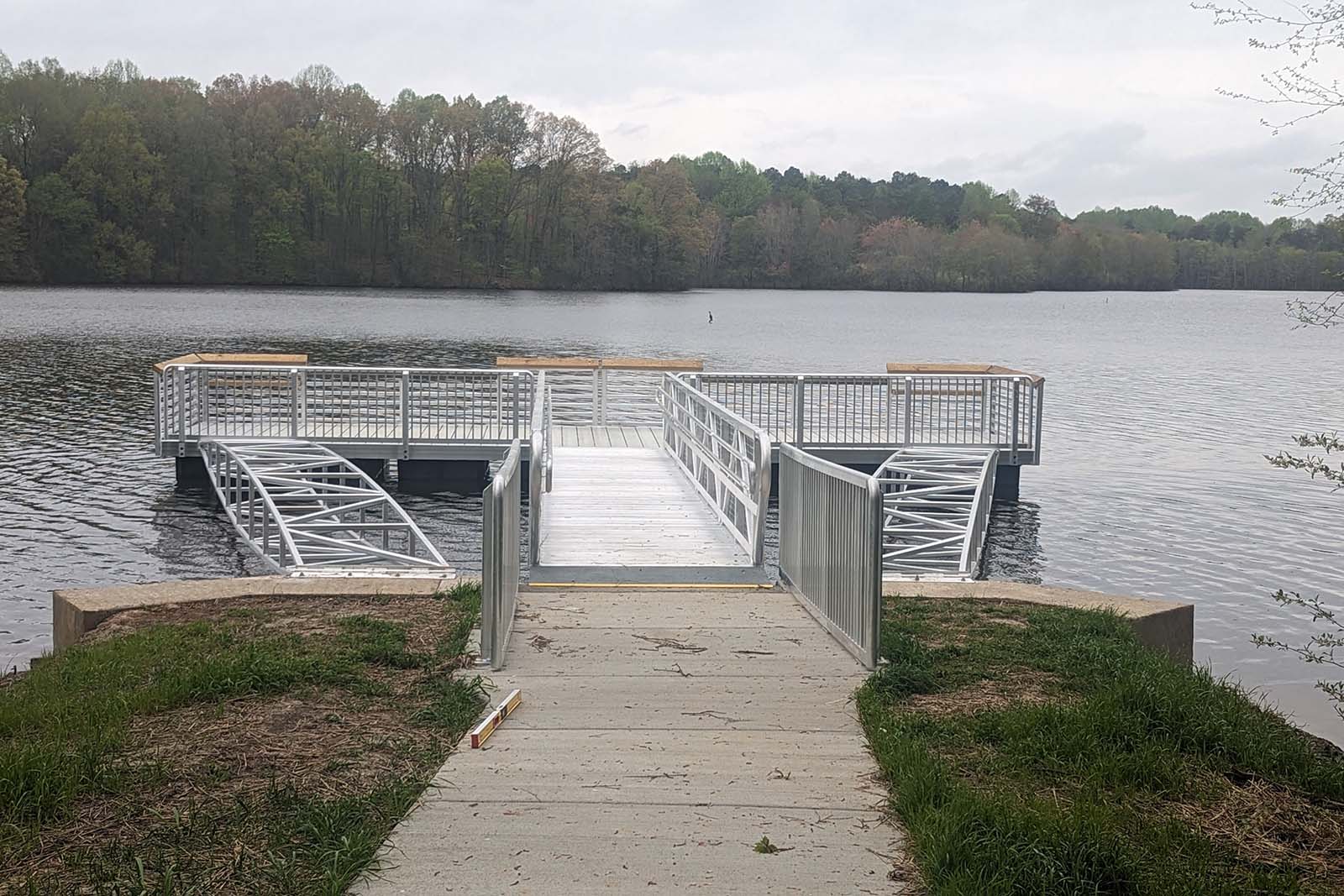
New Amelia Fishing Pier
A new, 10-foot wide, 32-foot long, aluminum fishing pier was installed at Amelia Lake on the Amelia WMA. Additionally, a new paved path leads from the parking lot to the accessible, floating pier. It meets the agency goal of providing access to a variety of constituent groups at a popular fishing lake.

Conserve. Connect. Protect.
DWR protects people, property, and natural resources by promoting safe outdoor experiences and managing human-wildlife conflicts through both law enforcement and education efforts. We also enforce the Commonwealth’s wildlife and boating laws and regulations.
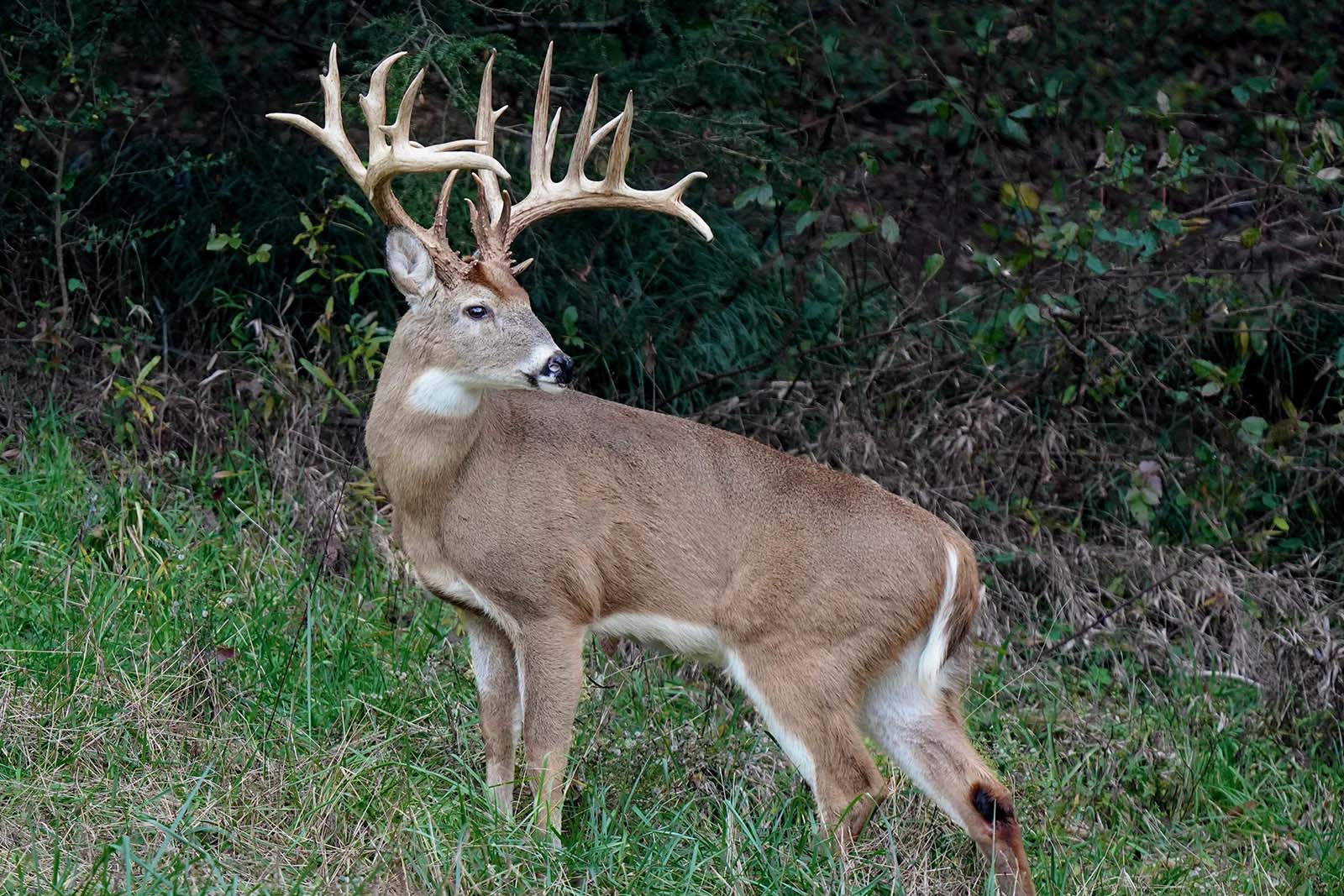
Justice for the Hollywood Buck
A hunter’s Facebook post boasting of killing a large, non-typical antlered buck led to the public identifying the deer as the “Hollywood Buck,” which frequented the Hollywood Cemetery and Oregon Hill area in the City of Richmond. The Hollywood Buck had been a well-known presence in the Mt. Calvary, Hollywood, and Riverview cemeteries for several years, often photographed by both amateur and professional photographers.
Two months of intensive investigation by DWR Conservation Police and Richmond City Police ensued, involving 10 Conservation Police Officers, the execution of 10 search warrants, and support from five surrounding law enforcement agencies. Video footage, witness statements, and cell phone data, were all used to piece together the suspects’ whereabouts and travel routes. Ultimately, the primary suspect was charged with 10 wildlife violations, including the illegal killing of the Hollywood Buck and two other antlered deer. Another suspect faced six wildlife violation charges related to the Hollywood Buck. Both suspects pled guilty to all charges, were fined replacement costs to the wildlife protection fund, were sentenced to jailtime and house arrest, and lost hunting privileges for a number of years.
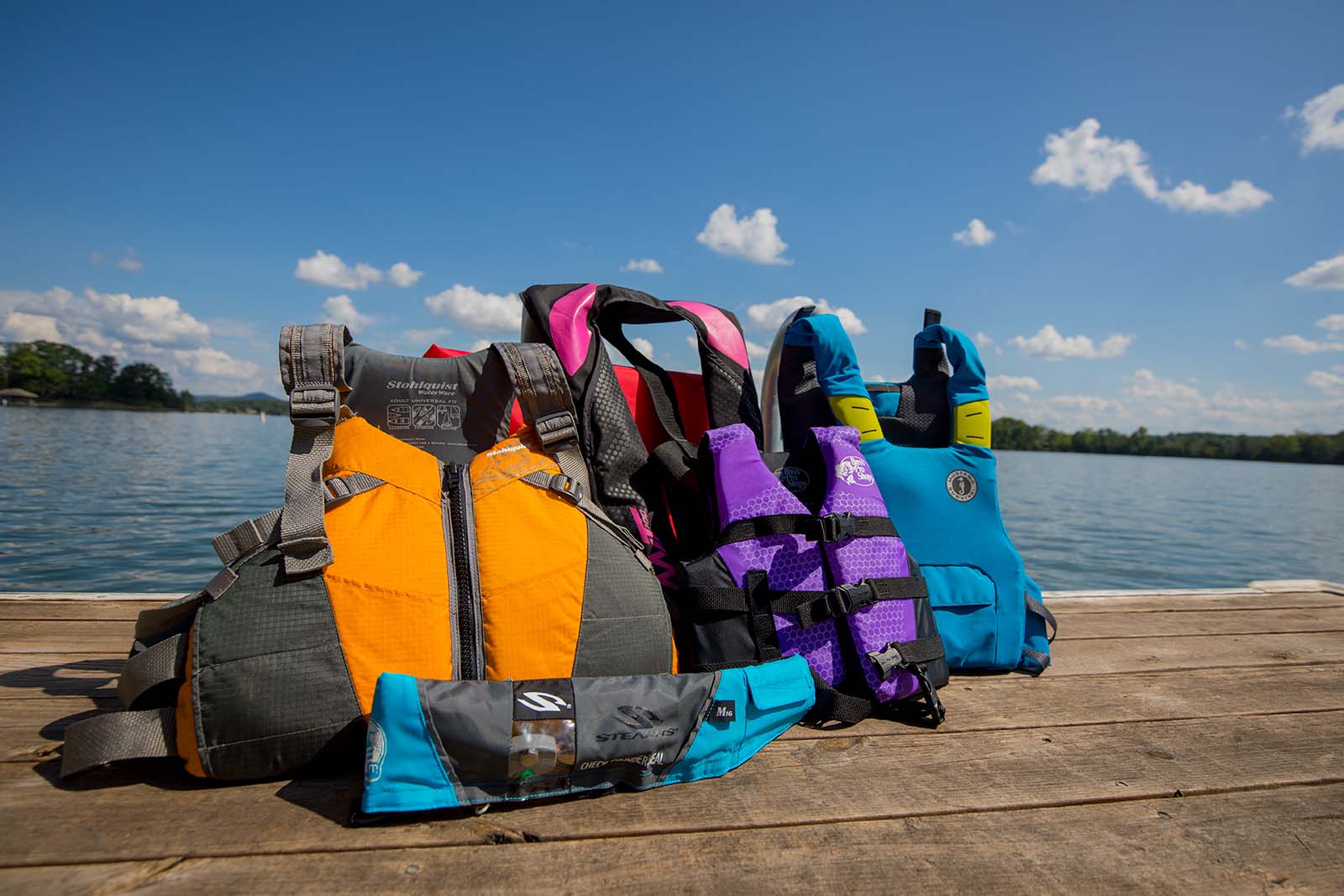
Keeping Boaters Safe
More than 24,000 students attended a boating safety education course (classroom and online combined). The Boating Safety Program continued to provide an approved virtual classroom course to provide students with an instructor-led virtual experience as well as free home-study courses to boaters who were unable to take an online boating safety course or nearby classroom course. The Boating Safety Program also coordinates with the DWR Outreach division to provide boating safety messages through the agency’s social media avenues, agency website, and boating email newsletters. The Boating Division Director served on the National Association of State Boating Law Administrators (NASBLA) Boating Standards.
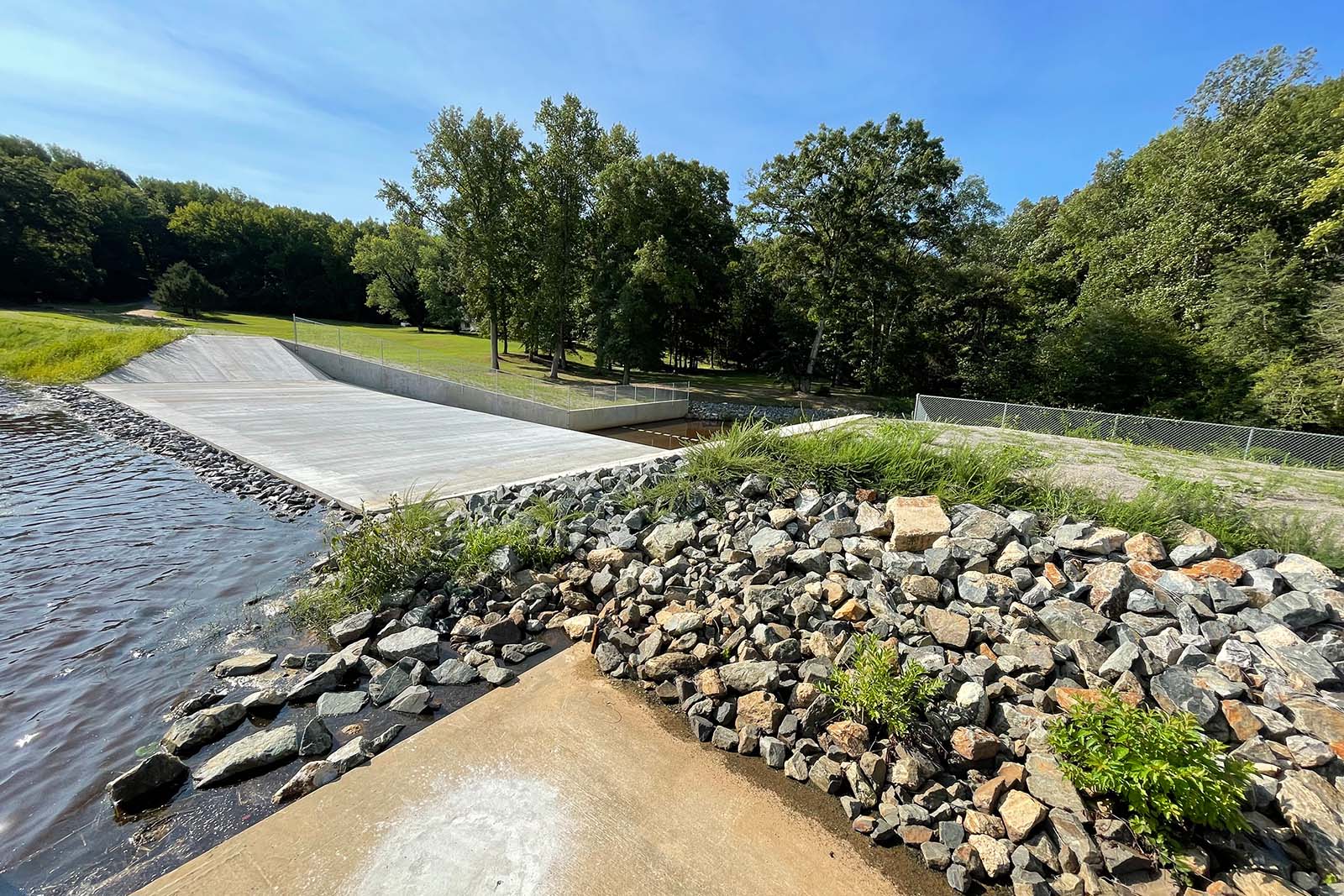
Chandler’s Mill Pond Dam Renovation Completed
This significant project rehabilitated the dam at Chandler’s Mill Pond in Westmoreland County after it was damaged in several large storm events. A controlled breach was established to allow crews to build a new spillway and make necessary repairs. This new spillway will allow for a larger volume of water to flow out of the pond during large storm events. The project meets the agency’s goals of reducing liability and addressing operational obligations while reestablishing the fishing and recreational opportunities on a DWR-managed lake.
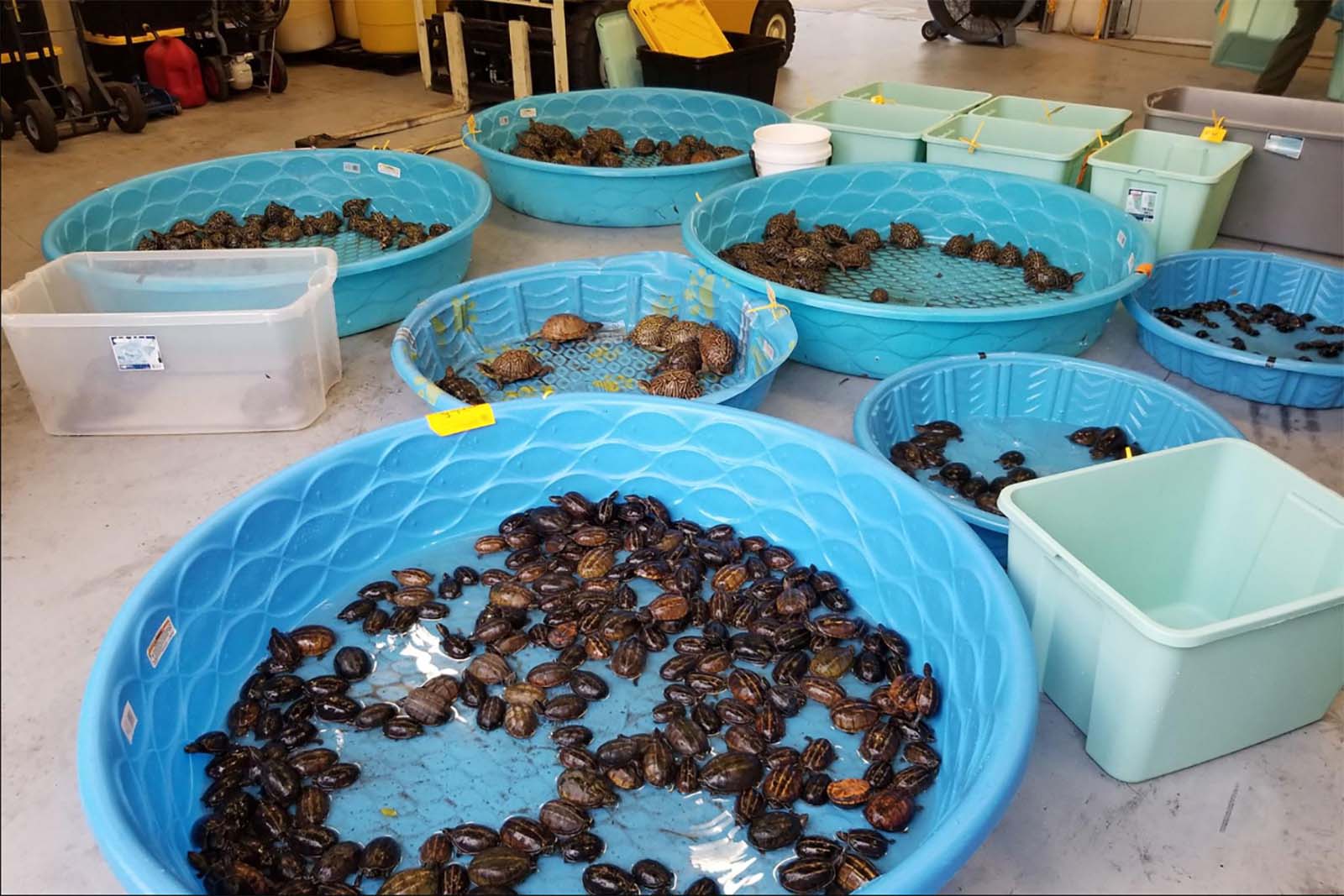
Special Operations Focuses on Illegal Reptile Trade
The Special Operations Unit of DWR’s Law Enforcement division concluded a nearly three-year comprehensive investigation of the illicit reptile trade in Virginia. The unit focused on high activity sites, both physical and virtual, for those engaged in the sale of reptiles. After three years, the investigation had grown to include several cooperating private individuals, cooperation with federal and state partners, and spanned outside the Commonwealth, with DWR special agents conducting investigations in North Carolina, Maryland, Pennsylvania, and California. These efforts culminated in the purchase, seizure, and surrender of more than 750 individual native animals, comprised of 26 different species. While the domestic estimated value of the recovered wildlife is around $35,000, the market estimate exceeds $150,000.
As a result of reporting these results to DWR’s Board of Directors, a resolution was passed that, in part, helped provide for the creation of four regional investigator positions. With the additional investigative efforts of these agents, along with their duties related to serious hunting and boating incidents, it is hoped that the illicit poaching and sale of Species of Greatest Conservation Need can be further curtailed.
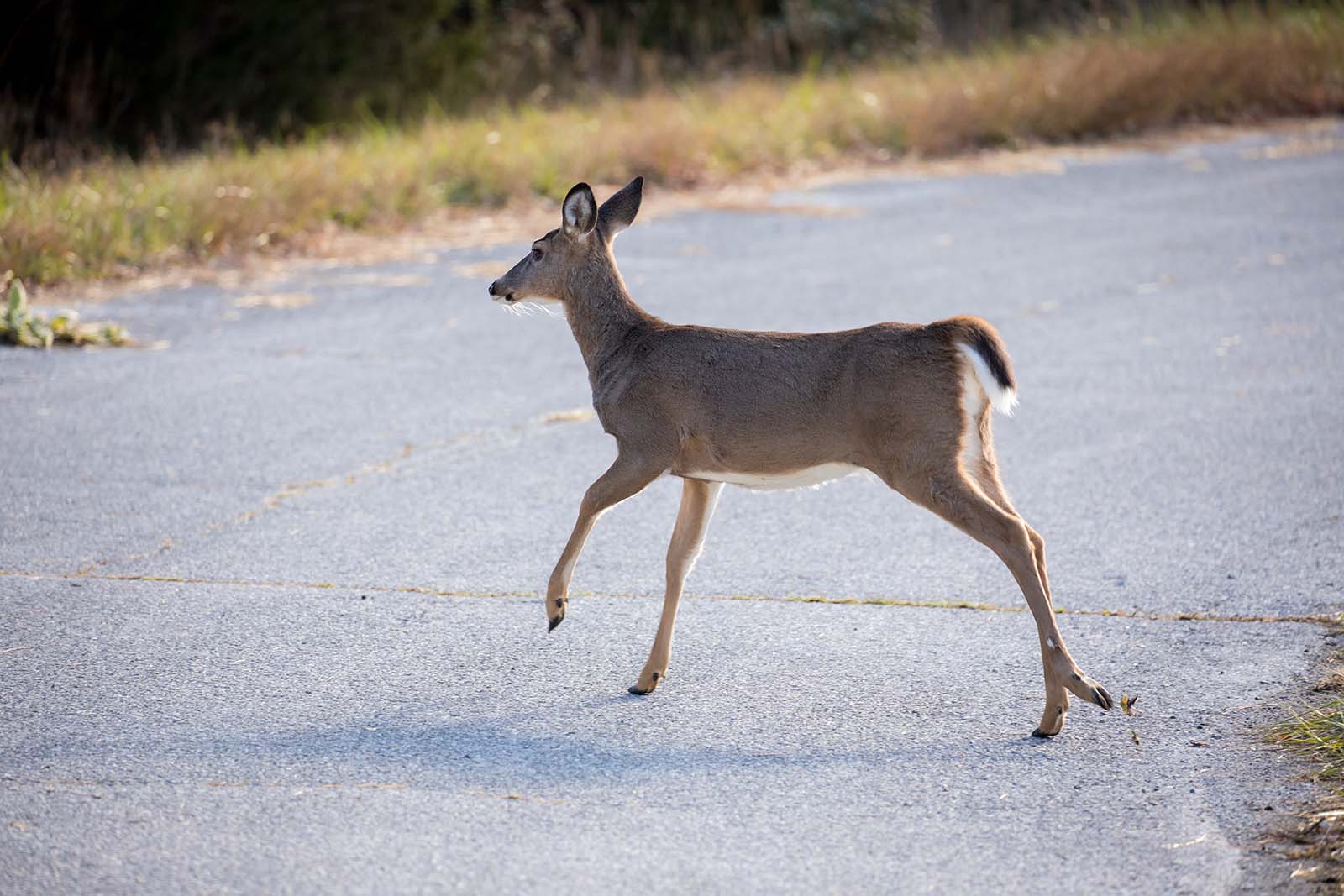
Aiming to Reduce Wildlife-Vehicle Conflicts
A DWR District Wildlife Biologist is co-leading a project on wildlife-vehicle conflicts (WVC) in Loudoun County (which experiences the highest number of deer-vehicle conflicts in the state) with students from the College of William & Mary. The project will identify priority road sections in the county for WVC reduction strategies, as well as the design of a citizen science app to collect wildlife road mortality data. In addition, the project will identify motivations and barriers to implementation of wildlife-vehicle conflict mitigation.
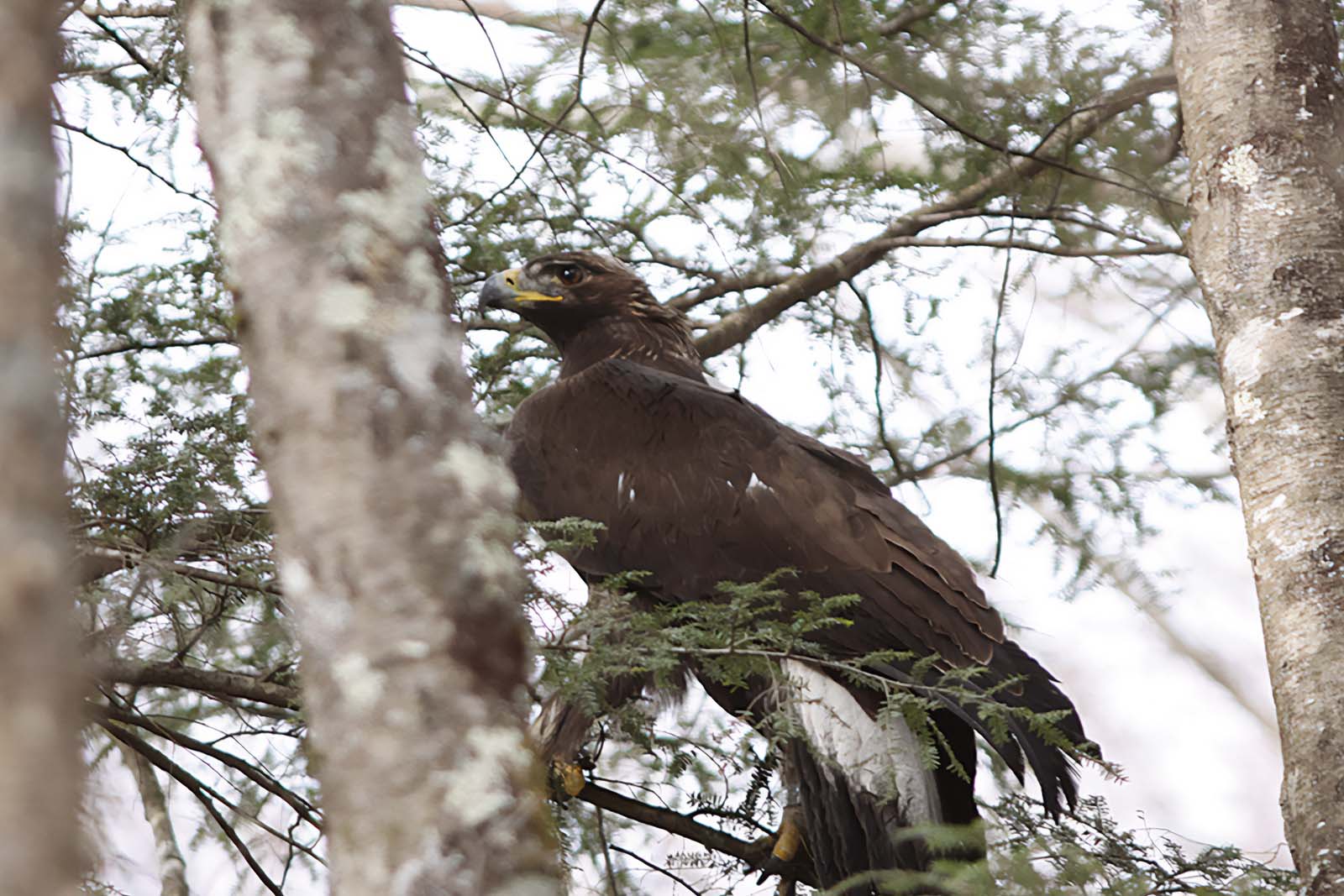
Monitoring Highly Pathogenic Avian Influenza in Eagles
DWR Nongame biologists and Wildlife Health staff performed Highly Pathogenic Avian Influenza (HPAI) surveillance in bald and golden eagle populations, trapping six golden and 16 bald eagles, collecting biological samples, measuring the birds, and banding them. They collaborated with the Southeastern Cooperative Wildlife Disease Study (SCWDS) to test the eagles both for HPAI virus and antibody.
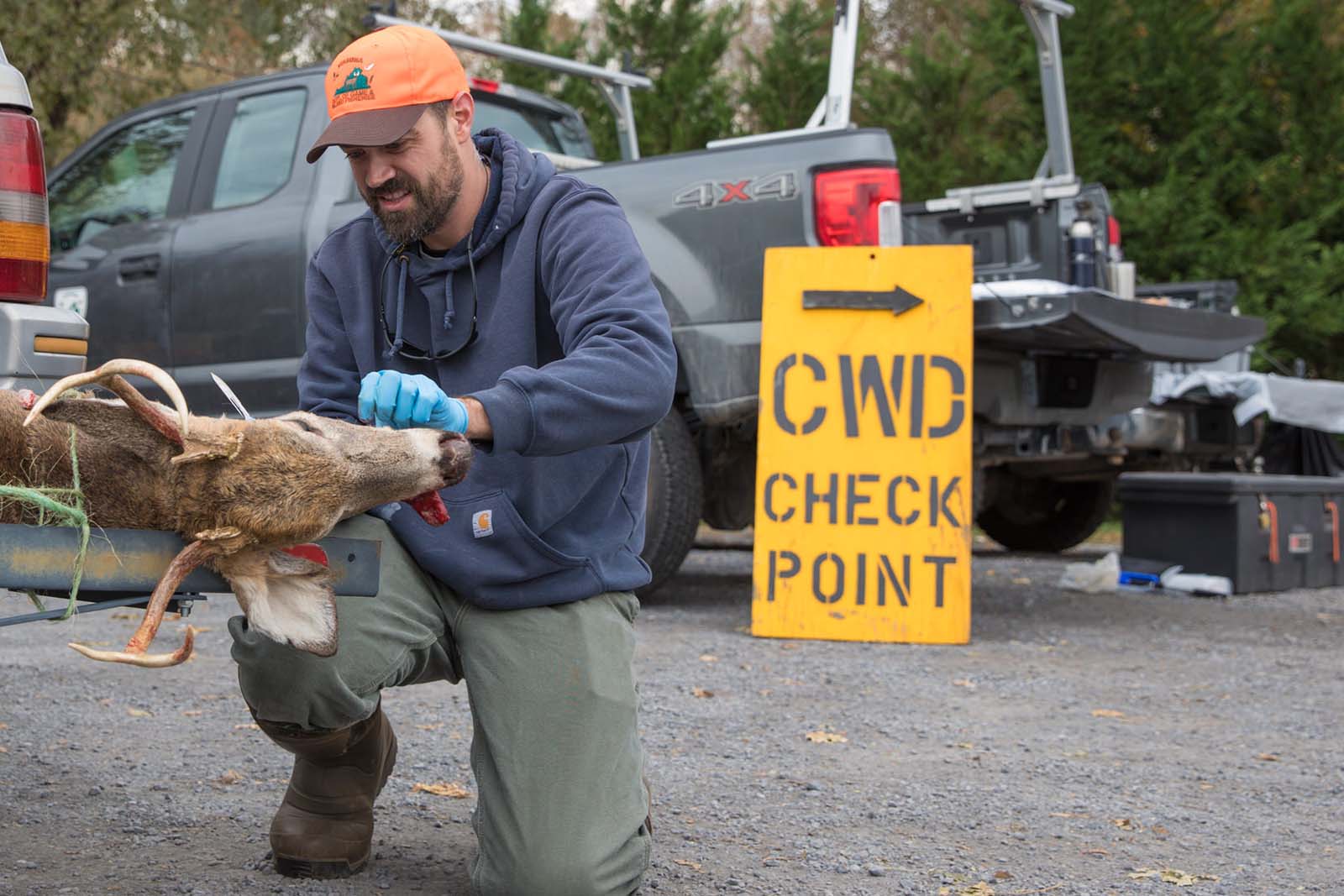
Investigating Wildlife Disease and Mortality
DWR wildlife health staff coordinated specimen collection from all public reports of unusual mortality, and, if warranted, traveled and performed environmental assessment and testing. They tested nearly 8,000 deer for Chronic Wasting Disease (CWD), with approximately two-thirds of those originating from within the three Disease Management Areas (DMAs) and one-third from the rest of the state. Wildlife Health staff also performed annual surveillance for important diseases in all DWR fish hatcheries. Notable wildlife health events included an outbreak of hemorrhagic disease (HD) in deer primarily in Rockingham and Augusta counties; a mortality event caused by highly pathogenic avian influenza in the Chesapeake Bay and Virginia Beach area, mostly affecting sanderlings and grebes; multiple outbreaks of canine distemper throughout the state, most notably in raccoons, skunks, and gray fox; an increased percentage of nestling mortalities in terns and skimmers on the artificial nesting barges near Fort Wool; a trichomonas-associated pigeon die-off along the Chesapeake Bay Bridge Tunnel; and several detections of meningeal worm causing neurologic disease in elk.
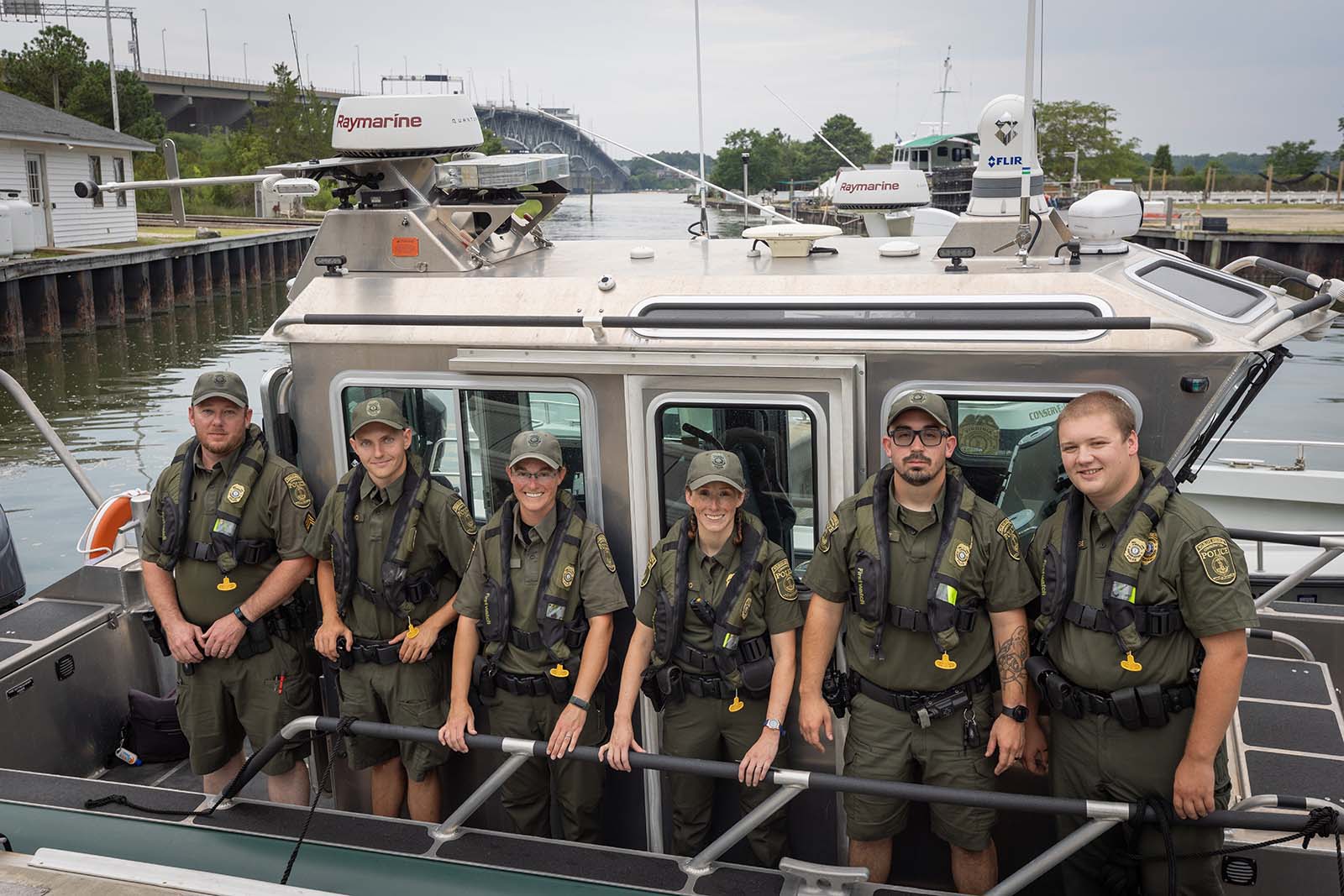
Operation Dry Water
Operation Dry Water, an annual national awareness and enforcement campaign, focuses on reducing the number of alcohol- and drug-related incidents and fatalities on the water. During the three days of Operation Dry Water weekend, Virginia CPOs were on the water educating boaters on safe boating practices and making Virginia waterways safer for all recreational users. Even with heavy rain and thunderstorms, 96 officers patrolled 42 different bodies of water and contacted 1,001 vessels, resulting in 2,332 individual boater contacts. From these contacts, 147 boating violations were handled through the issuance of summons or arrest, five of which were for operating under the influence. Recognizing the need to better educate an additional 156 boaters was accomplished through warnings.
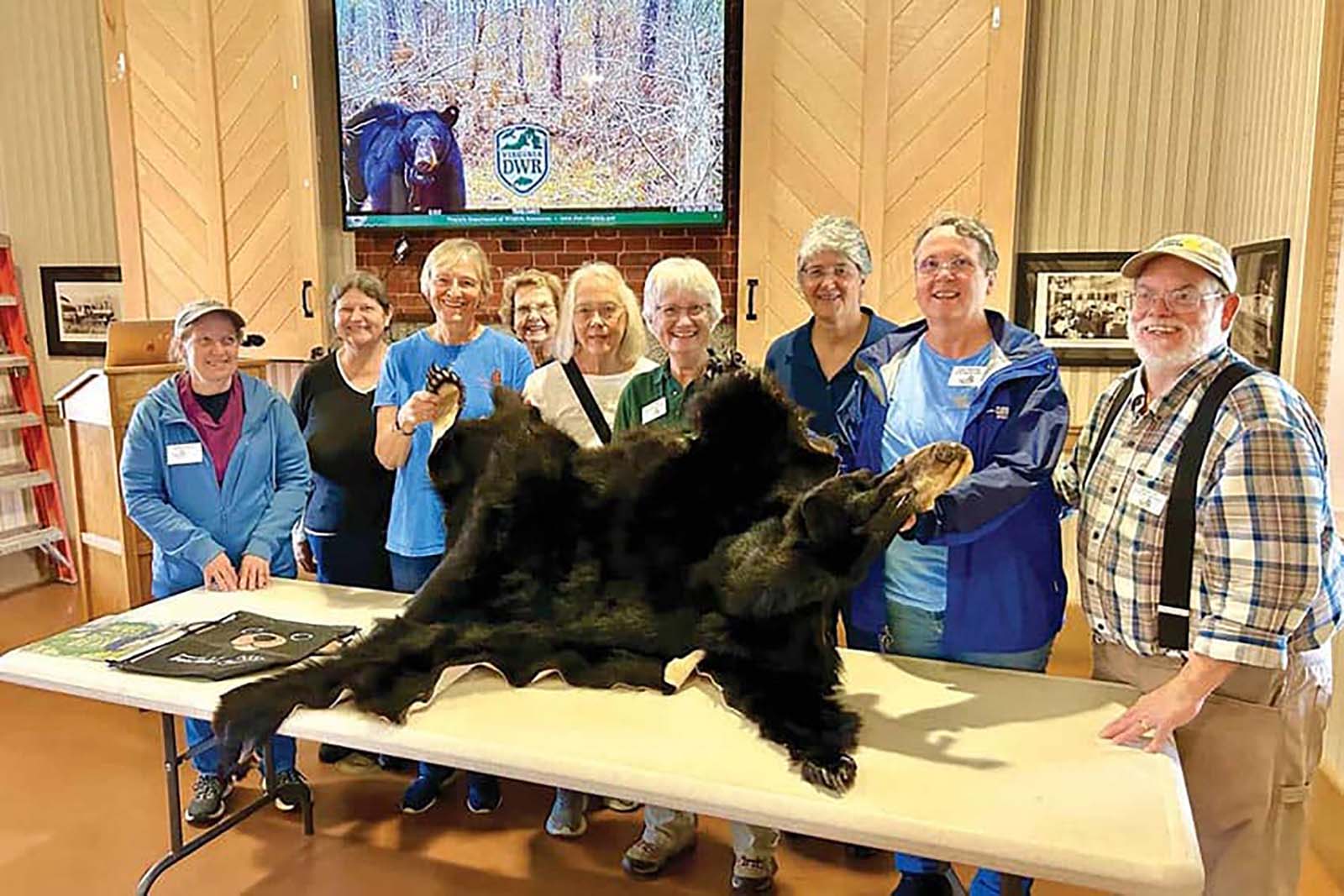
DWR/VMN Living with Black Bears Project
DWR’s Wildlife Education Coordinator collaborated with 12 Virginia Master Naturalist (VMN) chapters on the DWR/VMN Living with Black Bears Project, which aims to train VMN volunteers to educate the public about being Bearwise at various tabling and lecture events in their areas. Between January 2024 and July 2024, eight VMN chapters reported 929 outreach hours for this project and talked with over 6,898 people about Living with Black Bears in Virginia through 12 sit-down presentations and 21 tabling events. Additional outreach materials were developed with the help of the Bear team and the Outreach division.
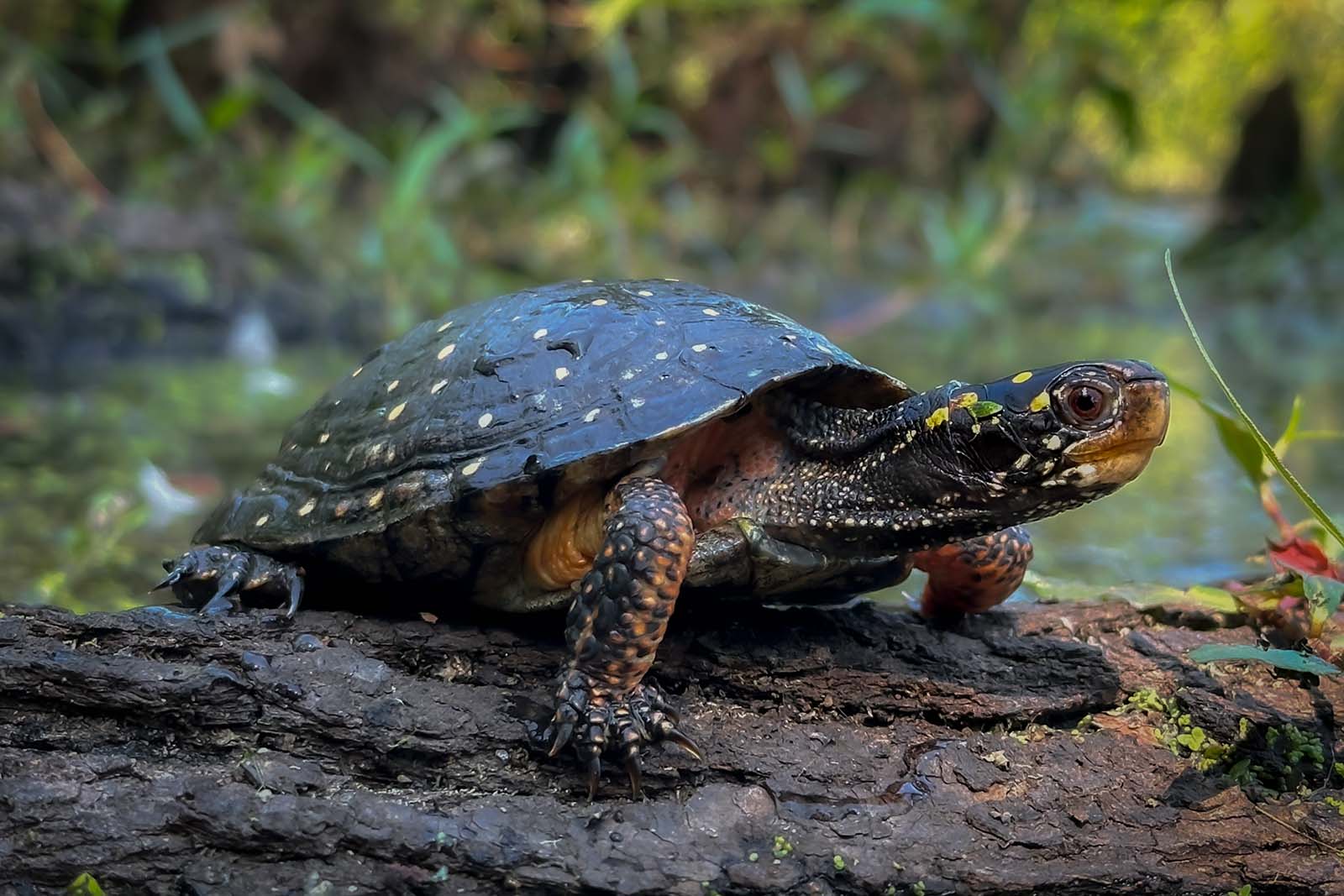
Replacement Costs Established for Commonly Trafficked Turtles
The Collaborative to Combat the Illegal Trade in Turtles (CCITT) is a Partners in Amphibian and Reptile Conservation national task team formed in 2018 that strives to build a network of conservation professionals dedicated to addressing the challenges that stem from illegal collection and trade of turtles native to the United States. An ad hoc Replacement Costs Working Group was formed in spring of 2024 in response to a request from DWR to help develop meaningful replacement costs for commonly trafficked turtles: the woodland box turtle, spotted turtle, bog turtle, wood turtle, and the northern diamond-backed terrapin. Replacement costs are frequently used in court cases to address damages resulting from violations of laws and regulations. This work for Virginia is the first time such an effort has focused specifically on reptiles and will set a framework and standards for similar efforts elsewhere in the country and for additional reptile and amphibian species.
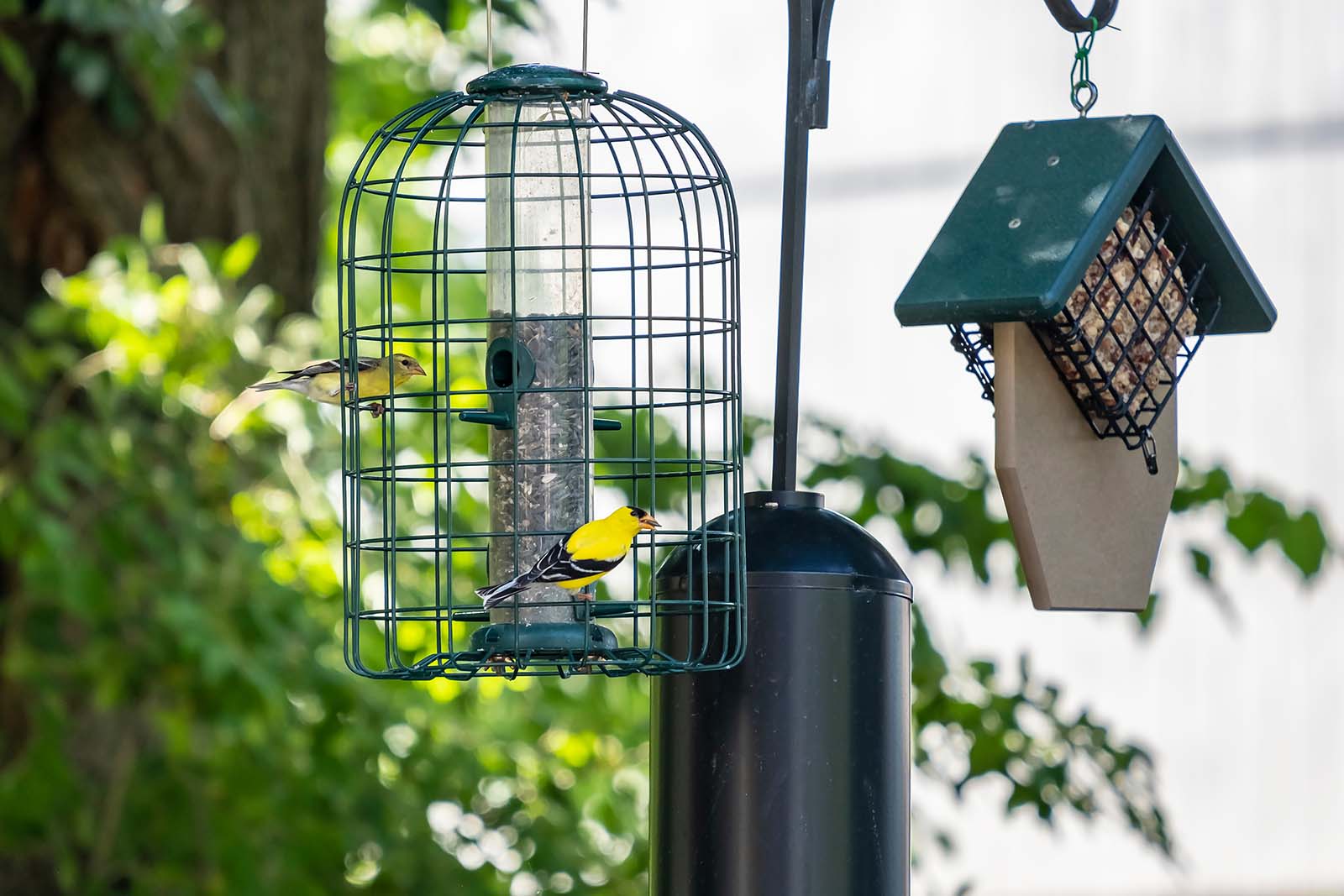
Guidance Developed on Safe Bird Feeding
DWR has developed recommendations for safe wild bird feeding, which are published on the DWR website and were created by considering science, wildlife health, and human dimensions. The webpage, including an interactive map, includes more information on why safe bird feeding is important and suggests best practices for feeding wild birds while avoiding issues that can negatively impact birds and other wildlife.
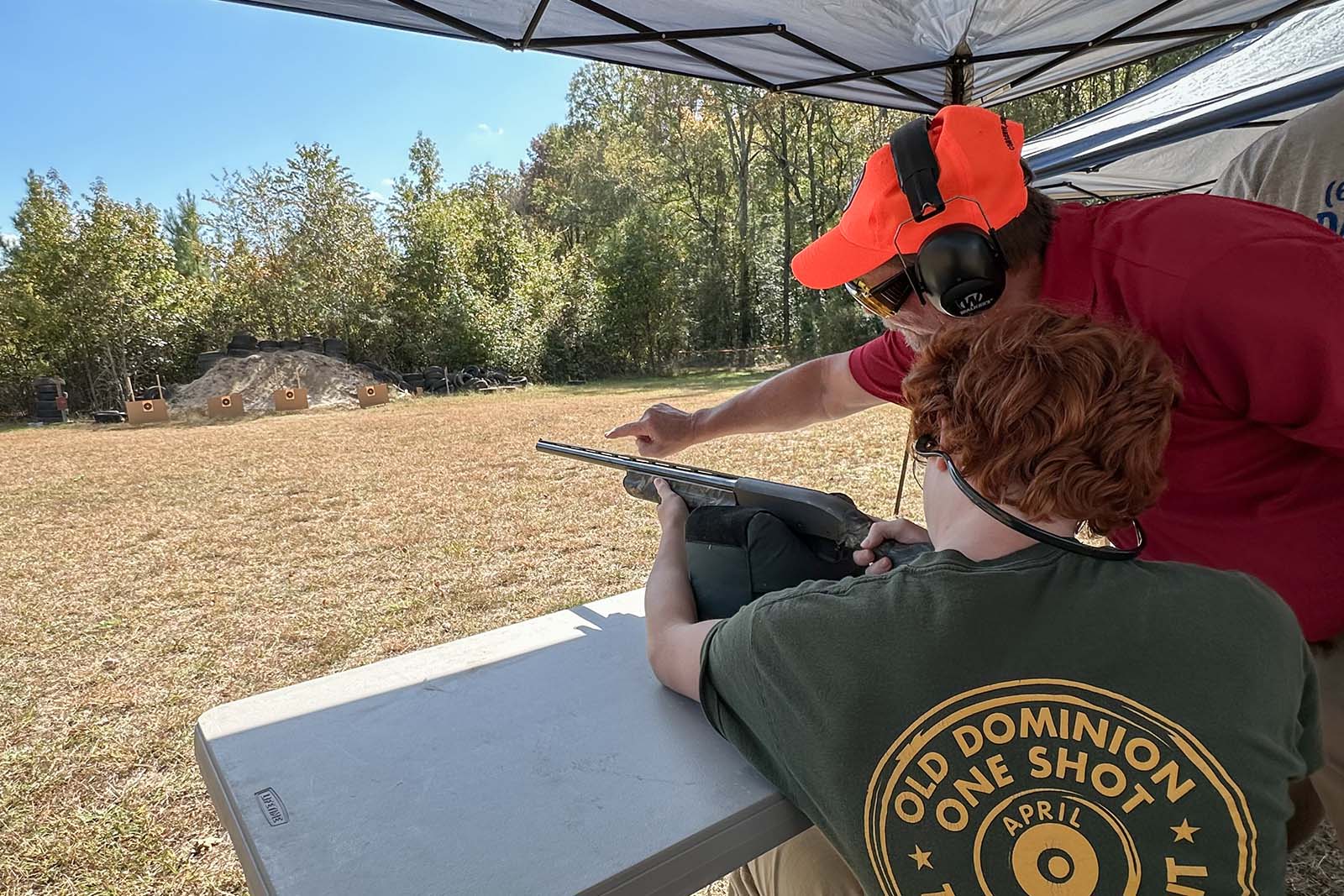
Keeping Hunters Safe
The Hunter Education Programs continue to provide new hunters and hunter-adjacent persons with educational opportunities and experiences across the Commonwealth, stressing the importance of becoming safe, legal and ethical hunters. In addition to the Virginia Basic Hunter Education classes, the Hunter Education Programs staff and volunteers provide educational opportunities in a host of outdoor recreation activities that focus on the goal of creating lifelong hunter/ conservationists. Since Hunter Education became mandatory for 12–15-year-olds and first-time hunters in 1988, there has been a 73 percent reduction in the rate of hunting-related shooting incidents (injuries and deaths). Hunting incidents have declined statewide from a high of 92 in 1986 to 23 in 2023/24, including four incidents that were non-hunting based on Law division reporting.
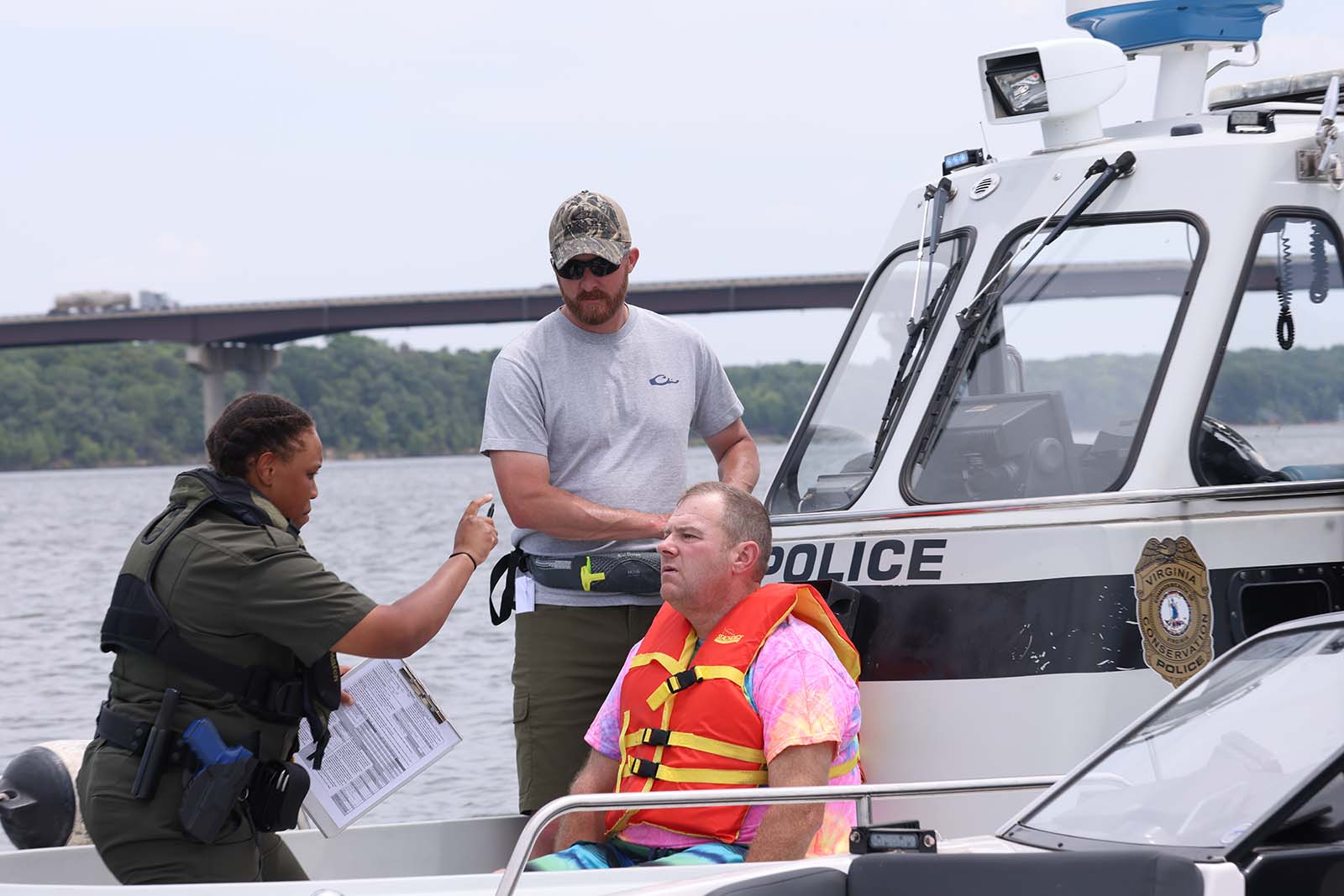
Marine Theft and Fraud Unit Cases
- 45 Felony charges
- 32 search warrants
- 6 recovered trailers
- 79 cases developed
- $437,000 impact on taxation
- 14 misdemeanor charges
- 14 recovered boats
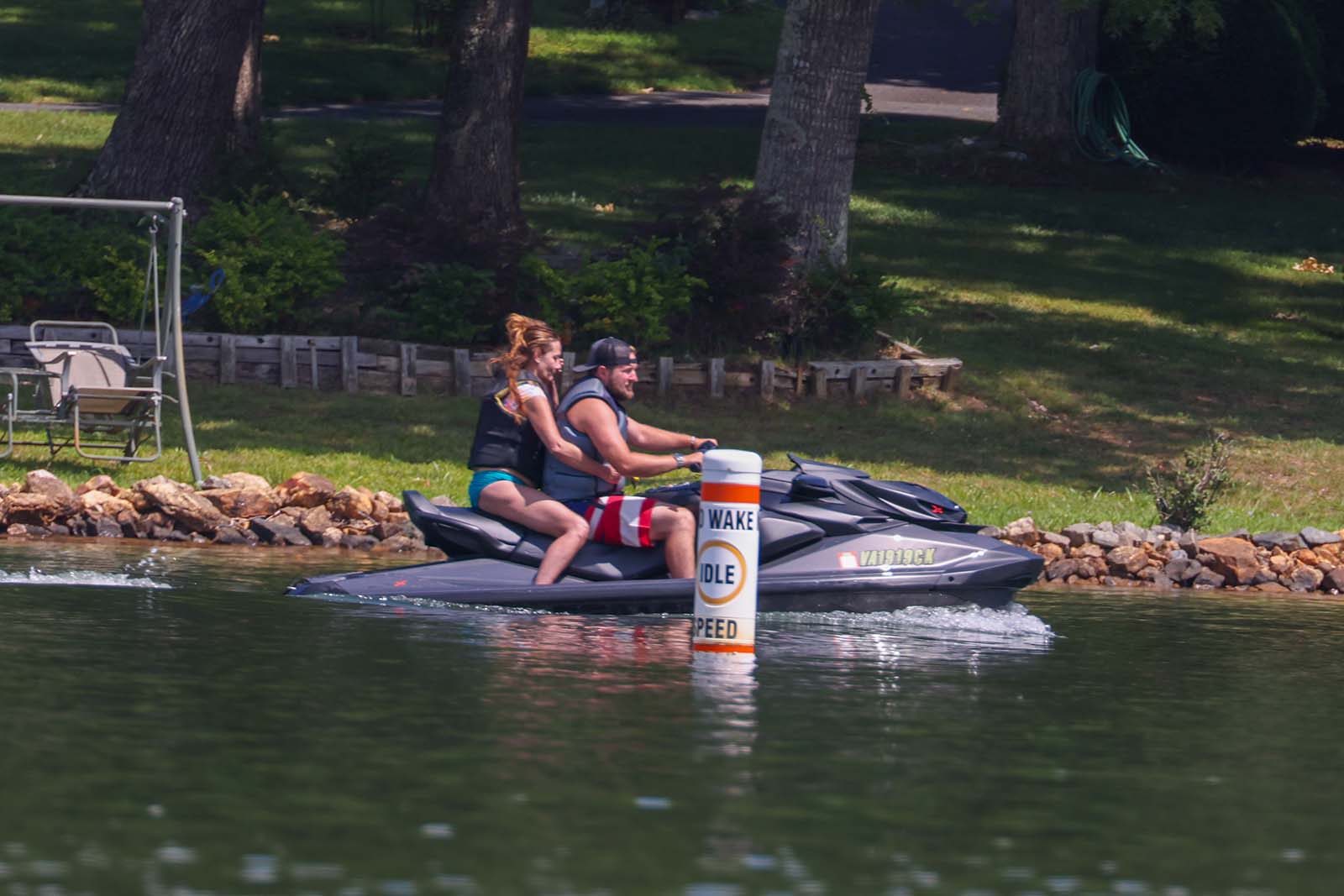
Managing the Waterways
DWR’s Waterways Manager successfully attained the Certified Recreational Boating Professional designation, approved 15 regulatory waterway markers and denied 11 regulatory waterway marker permits, provided consultation with citizens, law enforcement, and localities on a large number of other waterway markers, provided assistance via Freedom of Information Act (FOIA) requests on 13 other waterway markers, and provided assistance to U.S. Coast Guard and law enforcement on marine permit processes.
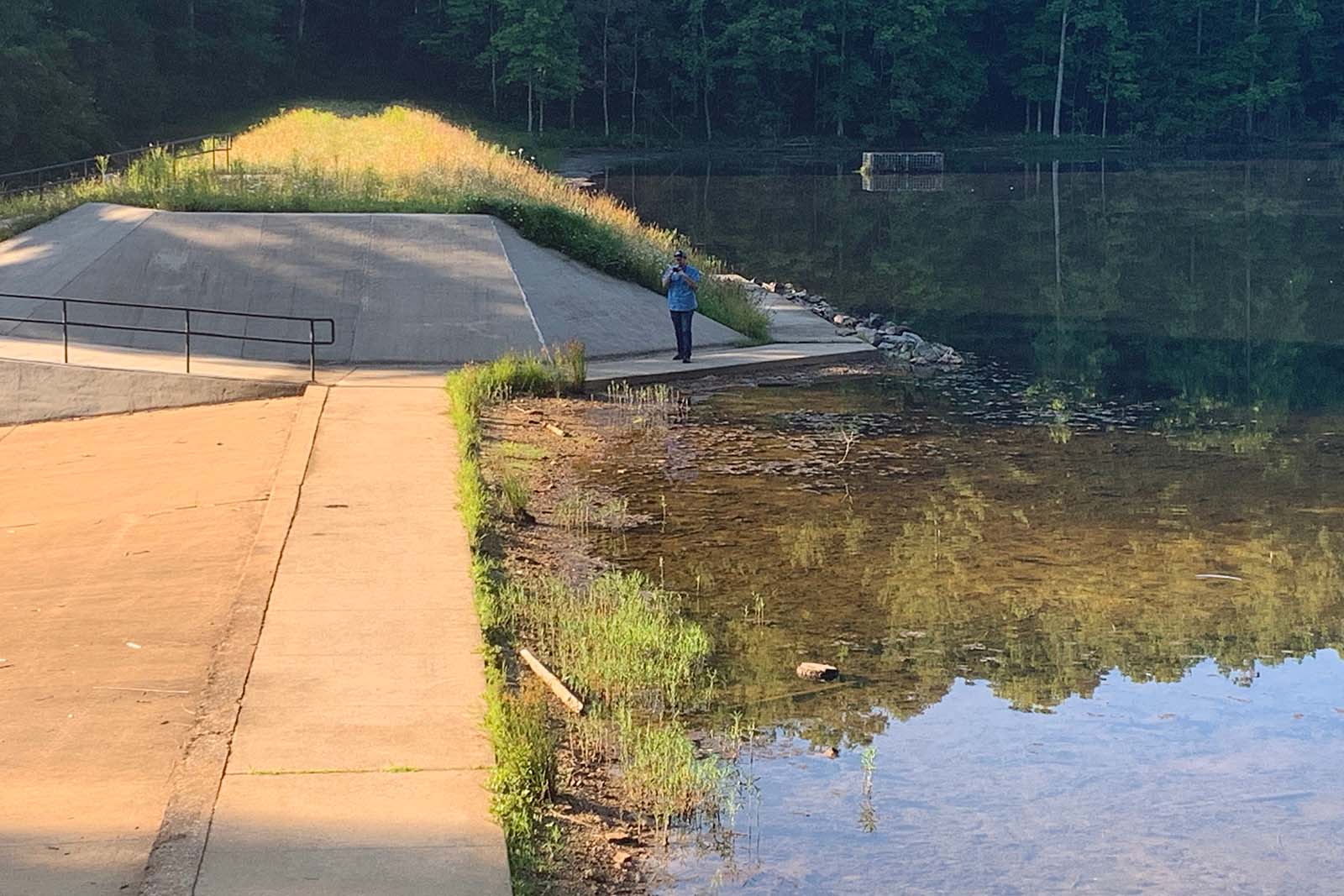
Monitoring DWR Dams
DWR’s dam safety staff inspects DWR’s 39 dams and works with consultant engineers to bring DWR’s inventory into compliance with Virginia Department of Conservation and Recreation (DCR) dam safety regulations. During the fiscal year, DWR completed 28 engineering inspections, updated 29 emergency action plans, and renewed 21 operational certificates. This work not only mitigates public risk, but also provides public fishing opportunities on DWR-managed lakes.
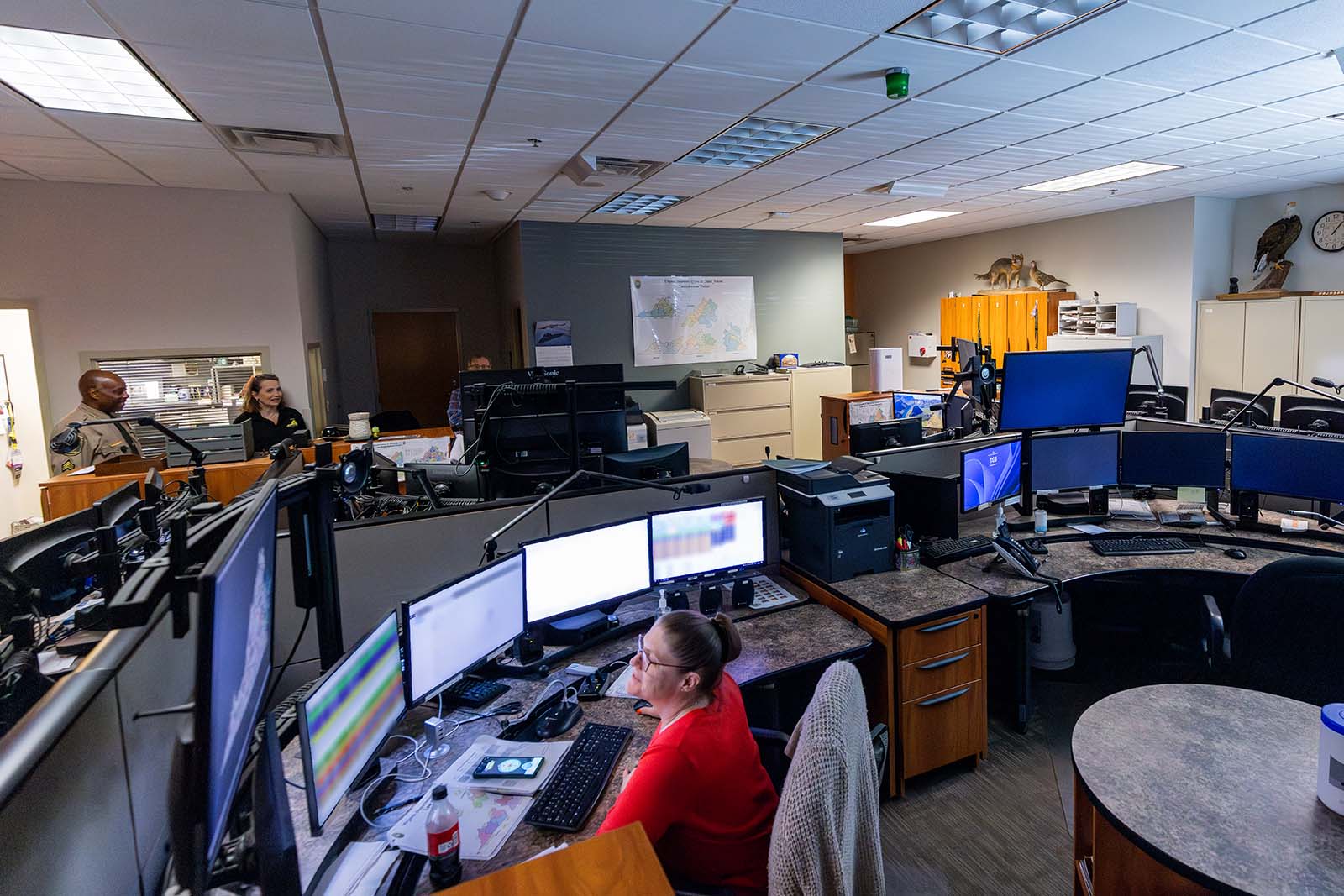
Law Enforcement Communications Center
DWR operates a 24-hour, 7-day-a-week Law Enforcement Communications Center that provides support for all DWR personnel and also the Virginia Department of Conservation and Recreation (DCR) State Park Rangers. Calls for service exceed 60,000 each year.
| Call Type | Number of Calls |
|---|---|
| CPO/Ranger Patrols | 23,012 |
| Hunting/Boating/Fishing/Trapping Violation | 5,891 |
| Crimeline Reports | 5,725 |
| Service-Related | 5,156 |
| Wildlife Nuisance/Permit/Injured | 4,911 |
| General/Traffic Violation | 4,434 |
| Criminal Investigations/Complaints | 950 |
| Environmental Issues/Fish Kills | 280 |
| Distress | 210 |
| Abandoned/Recovered Boats | 163 |
| Stolen Property Reports | 136 |
| Boating Incident | 93 |
| Hunting Incident | 27 |

DWR Wins National Awards
The Virginia Department of Wildlife Resources (DWR) was honored to accept the State Agency of the Year Award from the National Assembly of Sportsmen’s Caucuses (NASC) at the Congressional Sportsmen’s Foundation (CSF) 20th Annual NASC Sportsman-Legislator Summit. The award recognizes DWR’s strong support of pro-sportsmen’s policies, which include the adoption of a resolution to support opening Sunday hunting on public lands and proactive management of Chronic Wasting Disease.
DWR also reestablished a thriving herd of elk in Southwestern Virginia and in 2022 brought back the first modern elk hunting season in the Commonwealth. The NASC award also acknowledges the transparency of DWR’s regulation review process, noting that the agency provides online and in-person opportunities for the public to provide input and facilitates stakeholder committees to work through tough issues. NASC appreciated that DWR’s website includes timely updates during the legislative session with information on the status of bills that impact hunting, fishing, trapping, and related conservation issues, along with other useful resources for sportsmen and women. In addition, DWR seeks to inform outdoor enthusiasts through its GoOutdoorsVirginia app and monthly newsletters.

Meagan Thomas, a watchable wildlife biologist with DWR, received the Mark J. Reeff Award for a distinguished early career professional at the Association of Fish & Wildlife Agencies (AFWA) Annual Awards Ceremony. Thomas has helped the Watchable Wildlife Program expand its capabilities in providing more opportunities for the public to view and enjoy wildlife, such as bird watching, and help further connect them to nature.

Master Officer Jason Harris of DWR’s Conservation Police was selected as the

Courtney Hallacher, DWR’s statewide wildlife education coordinator, was recognized as the 2024 Project WILD Outstanding Coordinator of the Year by the Association of Fish and Wildlife Agencies (AFWA). The goal of Project WILD is to develop awareness, knowledge, skills, and commitment resulting in informed decisions, responsible behavior, and constructive actions concerning wildlife and the environment.
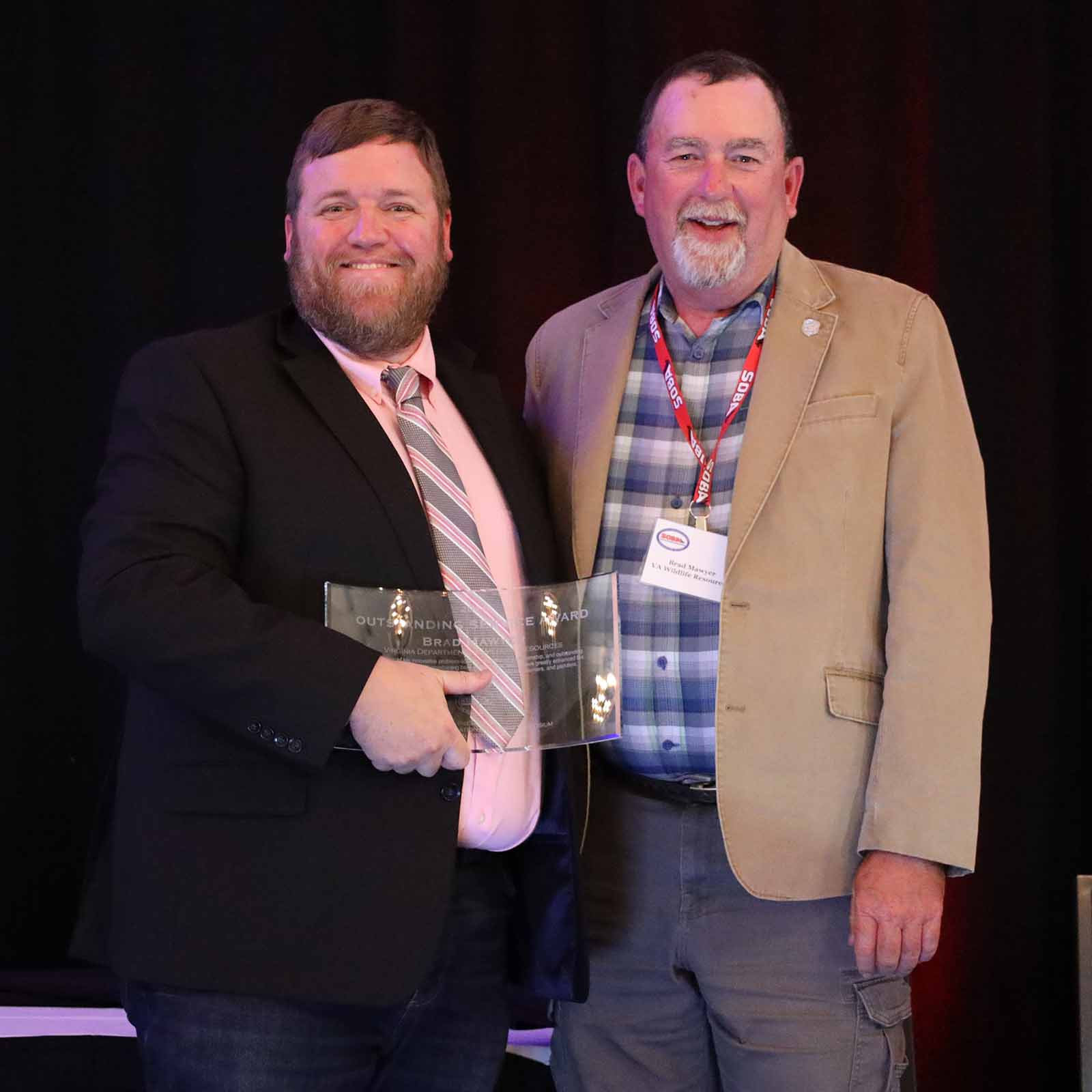
Brad Mawyer, a regional boating access manager at DWR, was awarded the Outstanding Service Award, presented to an individual or agency that has made a significant contribution to improving access for boaters and anglers to our nation’s public waters, at the 2024 States Organization for Boating Access (SOBA) Education & Training Symposium. In his 35 years with DWR, Mawyer has demonstrated not only professional proficiency, but also exceptional mentorship.
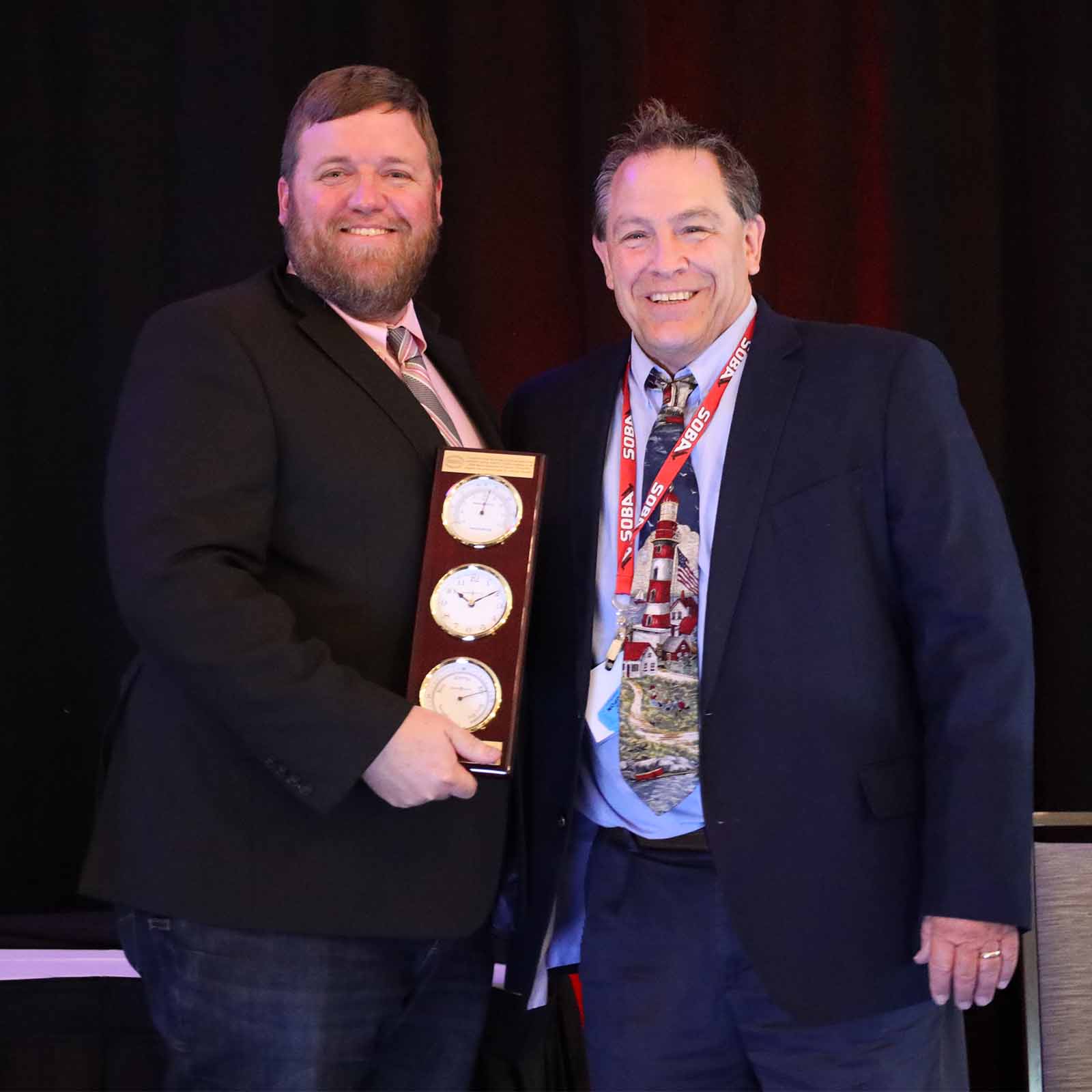
Preston Smith, DWR’s federal aid coordinator, accepted the William H. Ivers Award, bestowed upon an individual who has made substantial contributions spanning at least 15 years to the design, construction, management, or administration of boating access facilities or programs, at the 2024 SOBA Education & Training Symposium. Smith has represented and guided boating access programs on a national scale.

Marc Puckett, DWR’s small game project manager, was inducted into the National Bobwhite and Grassland Initiative Hall of Fame, recognizing his 25+ years of work in quail and early successional habitat management.

Funding Our Future
DWR depends on sustainable revenue from a number of sources. These include hunting and fishing licenses and permits, boat registrations and titles, and federal funds—some of which are based in part on the number of hunting and fishing licenses sold and the number of boats registered each year.
The department’s conservation and outdoor recreation efforts also benefit from the sale of Virginia Conservation License Plates, branded merchandise, Virginia Wildlife magazine and calendar sales, Restore the Wild memberships, and donations.
Just as importantly, DWR increasingly depends on the transfer by the Virginia General Assembly of funds associated with the Virginia sales and use taxes on watercraft, as well as the sales tax on hunting, fishing, and wildlife-watching equipment (commonly referred to as HB38), purchased in the Commonwealth.
DWR is constantly seeking ways to increase these existing funding sources and to develop funding partnerships with other state agencies, nonprofits, and private businesses.
How You Can Help
- By purchasing hunting and fishing licenses and permits
- By becoming a Restore the Wild member
- By purchasing a firearm or ammunition, or equipment for fishing, archery, or wildlife watching
- By registering and buying fuel for your boat
- By subscribing to Virginia Wildlife magazine and purchasing a Virginia Wildlife calendar
- By purchasing DWR-branded merchandise from DWR’s website
- By purchasing a Conservation License Plate through DMV
- By donating to DWR and the Wildlife Foundation of Virginia Partnership Fund
- By engaging DWR through sponsorships and public-private partnership opportunities
- By donating to the Non-Game Tax Checkoff on Virginia state tax returns

